Search results
For "costume"
Traditional Macedonian Clothes
Always closely linked to their native land, the Macedonian people have mostly lived through centuries of tradition transmitting it from one generation to another, and thus creating an unusually rare material and spiritual culture which bears some patriarchal characteristics. True folklore cannot be bought or sold, but has to be learned through toil, sweat, tears, and, sometimes, even blood. Contrary to some who abuse its name for self-serving interests, it is not mere entertainment to amuse the throngs or to pander to an audience.
Rather, it should, as with all true art, stimulate, educate, irritate, and, hopefully, lead all who are touched by it to a new level of insight. At the same time, by its nature folklore is also accessible, not merely to an artistic elite, but to all who pursue it with passion. It will take all of your concentration, creativity, and passionate effort to capture its essence, to add to its richness, and to transmit it undiluted to the next generation so that they, Macedonians and others may yet know its sublime beauty and glory.
Folk costumes
Particular attention Macedonian had paid to the design and decoration of their clothes, so that national costumes and jewellery are the most expressive and the most numerous examples of the traditional creativity of the Macedonians. The national costumes in Macedonia (created over a long period of time), preserved the traces of old cultural influences, and in their way of development fit the elements of old Balkan, Slav and Oriental culture. Above all the product of domestic textile manufacture, the Macedonian national costumes are characterized by richness and ornamentation. Western Macedonia, especially divided into smaller regional units with different ethnic characteristics is a real mosaic of various beautiful national costumes, where the women's costumes are of special interest.
Decorative Macedonian embroidery, characteristic in the forms, technically complex and of picturesque colours give special expression and distinction to the national costumes. The women's gowns are especially decorative, and are the main bearer of this kind of traditional artistic creation. Embroidery is not only an artistic expression and the essential element but the most characteristic of the costumes of different regions. All of that is an historic heritage that makes Macedonia proud.
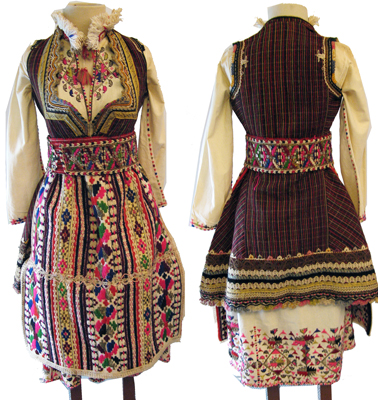
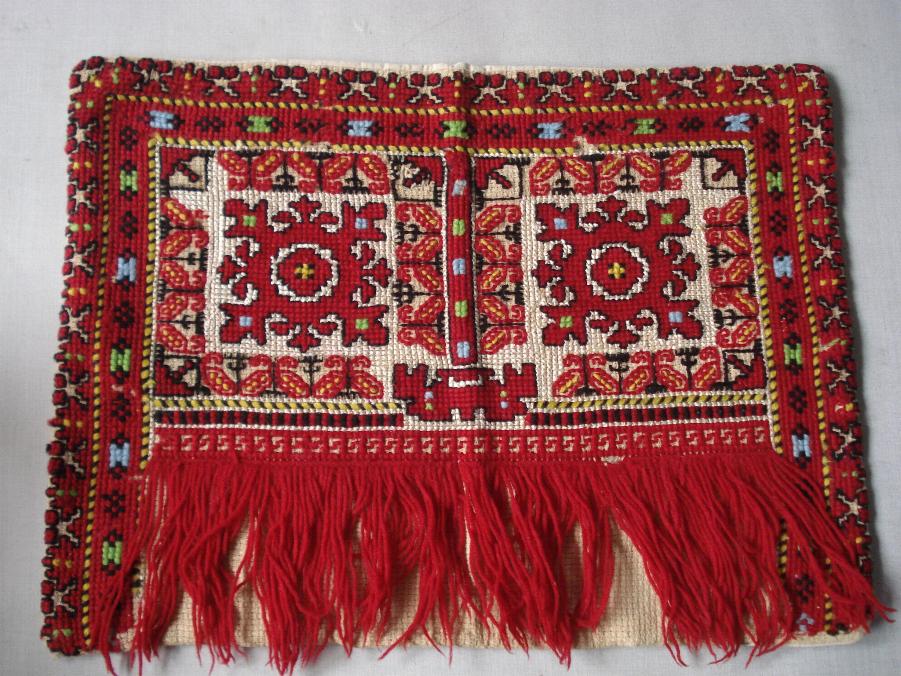
Most of Macedonia's colorful folklore consists of folktales and aphorisms (witty sayings). The following are typical aphorisms: "Falsehoods have short legs" (lies are soon found out); and "Begin a task, but always have its conclusion in mind" (finish what you start.) (Link do natinal quotes).
Macedonian folklore music
The ethnic Macedonian traditional music, which can be rural or urban (starogradska muzika), includes: lyric songs, epic songs, labour songs, ritual songs, humorous songs, circle dance ("oro"), the old urban style called Čalgija (not to be confused with chalga) etc.
Popular traditional songs are: Kaleš bre Angjo, Slušam kaj šumat šumite, Biljana platno beleše, Dafino vino crveno, Narode Makedonski, Zemjo Makedonska and many others. Often referenced oro dances are Teškoto from the village of Galičnik, Kalajdžiskoto, Komitskoto (The Dance of the freedom fighters) and others. An internationally acclaimed professional folklore association is the award winning “Tanec”.
Like its people Macedonia’s musical instruments have mixed origins. Many were brought to this land with the various invaders passing through over the centuries, while others are home grown. Playing traditional instruments is seeing a small revival in fusion music and in the revival of ethnic festivities.

Polog Region
Information on the Polog Region
The Polog Region is one of the eight statistical regions of Macedonia. The region is located in the north-western part of the country and is bordered by the Southwest Region and the Skopje Region.
Location of the Polog Region
The Polog region is composed of the Polog valley with the mountain massifs that surround it: Shar Mountain, Zeden, Suva Gora, the Mavrovo plateau, the mountain massif Bistra and the valley of the river Radika, with a total area of 2.416 km2 or 9.7 percent of the territory of Macedonia. The region has 184 settlements, of which 182 are rural and 2 urban settlements (Tetovo and Gostivar). The Polog region is divided into nine municipalities. The administrative centre of the region is Tetovo with 53 000 inhabitants. The valley features a typical plain with an altitude of 400 to 500 meters and steeply elevated picturesque mountains that reach over 2700 meters above sea level. There is a great geological, relief, climatic, floral and anthropogenic diversity. The Polog planning region has a total of 304,125 inhabitants.
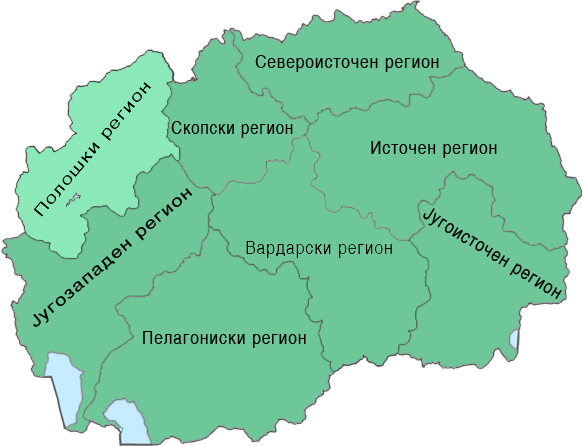
Traffic routes in the Polog Region
The region has decent roads and one highway: Skopje–Tetovo–Gostivar, one railway line Skopje-Tetovo-Gostivar-Kicevo, several cable cars and ski lifts at the ski resorts Popova Shapka and Mavrovo. From this region the roads lead towards the Mavrovo - Debar region and towards Kosovo. There are a number of local routes throughout the region.
The Climate in the Polog Region
The Polog region has a typical continental climate with special temperature specificities with hot summers and cold winters, with a sharp transition from winter to summer. The average annual temperature in the Polog region is 11 C in Tetovo, and about 10 C in Gostivar, while in Popova Shapka it is 4.6 C, so that in the mountain massifs in this region a typical mountain climate is dominant. In Polog, the average annual rainfall is 800 mm, and in the mountains 1100 mm. The precipitation is more pronounced during the winter period of the year, and a large percentage of them are snow falls creating conditions for winter sports and tourist activities.
Natural Resources, Flora and Fauna in the Polog region
Korab Mountain
The Polog region is recognizable by the highest mountains in the Republic of Macedonia.The Mountain Korab is a typical Alpine mountain with many peaks higher than 2,500 meters. Here is also the highest peak in the country, which is Golem Korab (2,764 m). This mountainous area abounds with natural beauties, with 12 permanent glacial lakes, with deep and attractive river valleys, with ravines and canyons (the 42 km-long Baricna canyon of the Radika River), with rapids, waves and waterfalls (Korab Waterfall on the river Dlaboka Reka, which is 136m high), with rich vegetation (Korab is part of the National Park Mavrovo), with suitable tracing trails, ski trails, etc.
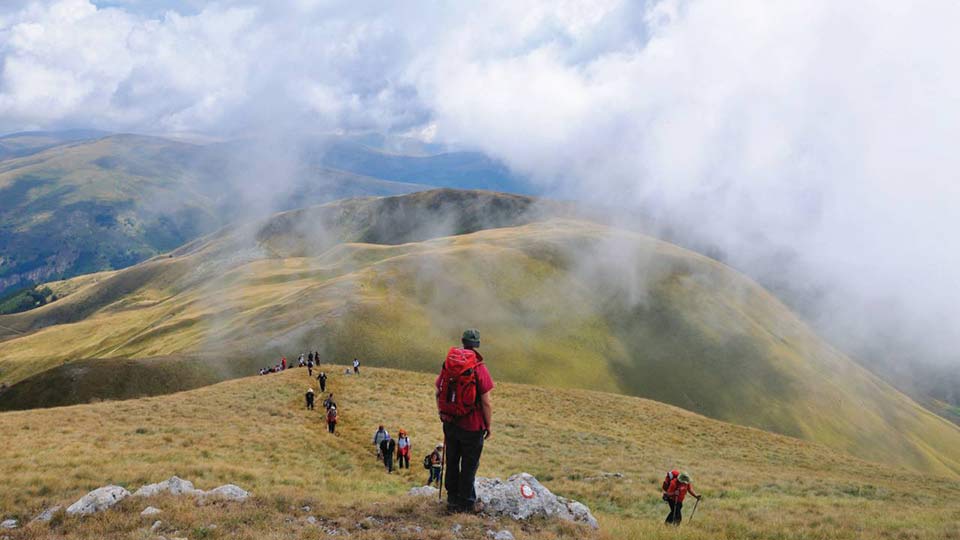
National Park Mavrovo
In this region is the largest national park in Macedonia — the National Park Mavrovo, on the southern coast of the Mavrovo Lake. The National Park has opened a tourist information center, where tourists can receive all the necessary information related to their stay and the park's offer. Second mountain in height in the Republic of Macedonia, and the first in mountainous areas is Shar Planina. It is a typical mountain with alpine landscapes on high and steep peaks, with mountain lakes, high waterfalls, remains of old plowing valley, but also flattened crests.
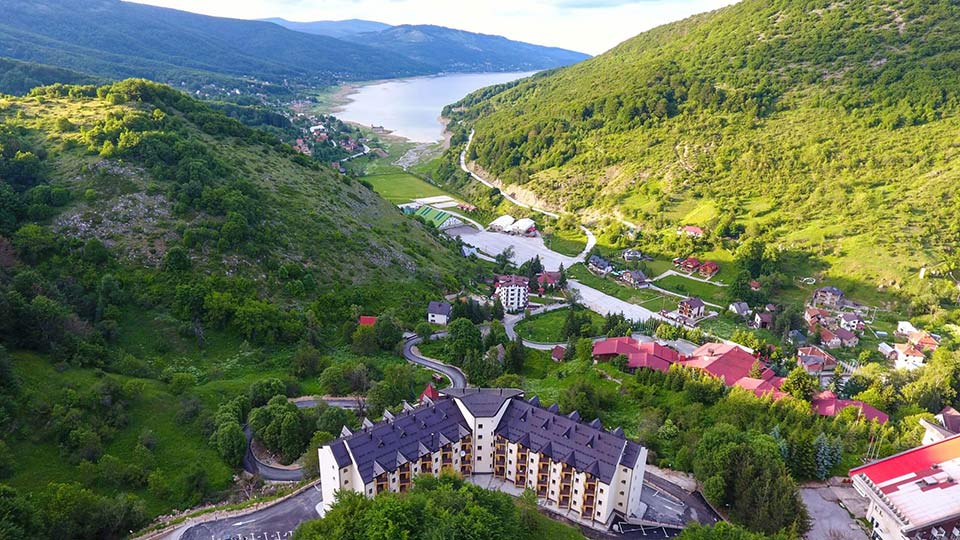
Shar Planina
The area of Shar Planina is 912.7 km², it is 80 km long and 10 to 20 km wide. It has 77 peaks higher than 2000 meters. The highest peak of Shar Planina, is Titov Vrv with (2747 m), Sogovo (2.268 m), Bistra (2.163 m). Other high mountains in the Region are: Deshat (2,373 m), Krchin (2,341 m). There are 30 glacial lakes on the mountain Shar Planina. The largest are Bogovinsko Ezero, Crno Ezero, Belo Ezero, Golem Gjol, Mal Gjol, Golemo Ezero, Malo Ezero etc. On the mountain there are numerous attractive sites, such as: Popova Shapka, Leshnica, Jelak, Mazdraca, Tri Vodi, Ljuboten etc. On the site Popova Shapka is the winter ski resort "Popova Shapka" which is a settlement with numerous holiday homes, hotels, restaurants, excellent ski fields, cable cars, ski lifts, mountaineering house and so on.
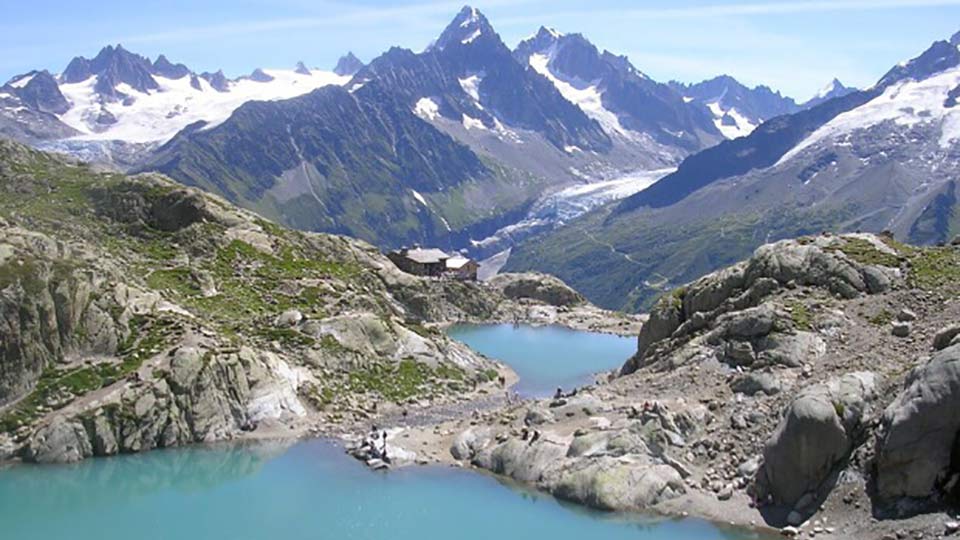
The region abounds with springs. The most significant are the upper flow of the river Vardar to the Derven Ravine, the picturesque valley of the river Pena, Lakavica and a large number of mountain rivers. Relief dissection, relative height differences, geological diversity. The presence of water and the characteristic climate allow for the development of a diverse floral species represented by a diverse dendroflora (beech, oak, birch, chestnut, hornbeam, pine) and grass vegetation with the presence of endemic species of rare species. In the region there are various types of big and small game: bear, wolf, deer, wild goat, wild boar and various species of birds and reptiles.
Winter-Sports Ski Centres in the Polog region
The Polog Planning Region is abundant with mountainous areas and winter sports centres. These are the Popova Shapka Ski Centre (1.780 m. above the sea level) and the Mavrovo Ski Centre (1.270 m. above the sea level). At both centres several tourism, sports and recreational activities such as: skiing, hiking, mountaineering, paragliding, cycling, hunting, fishing, etc. are actively practiced. Several cable cars and ski slopes are concentrated here, there are also two larger weekend settlements, as well as the largest number of accommodation facilities and high-level catering facilities in the region. At the same time winter events are organized, and especially well-known are the "Shar Planina Ski Cup" and "Mavrovo Memorial", which are visited by thousands of domestic and foreign tourists.
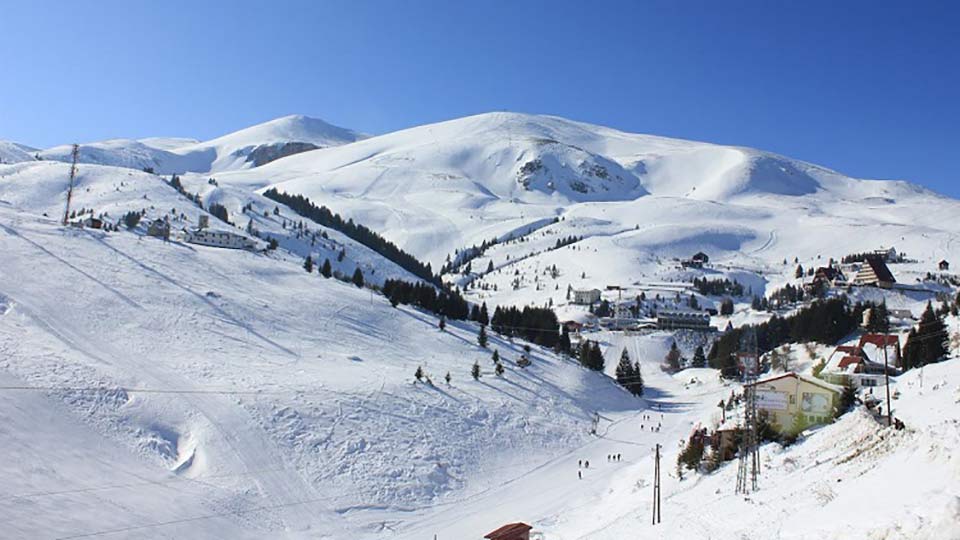
Bistra Mountain
The third high mountain in the region is the mountain Bistra, which is the second most important mountain with winter sports activities. Here is the "Mavrovo Ski Centre". Bistra is part of the Mavrovo National Park. This mountain is lower, and the highest peak is Medenica (2,163 m) and is smaller than the area of Shar Planina (with 572 km²). Bistra has a variety of geomorphological surface and underground relief forms. Such as: the glacial relief, depressions, hollows, karst fields, lost rivers, caves, abysses, river springs, canyons and other.
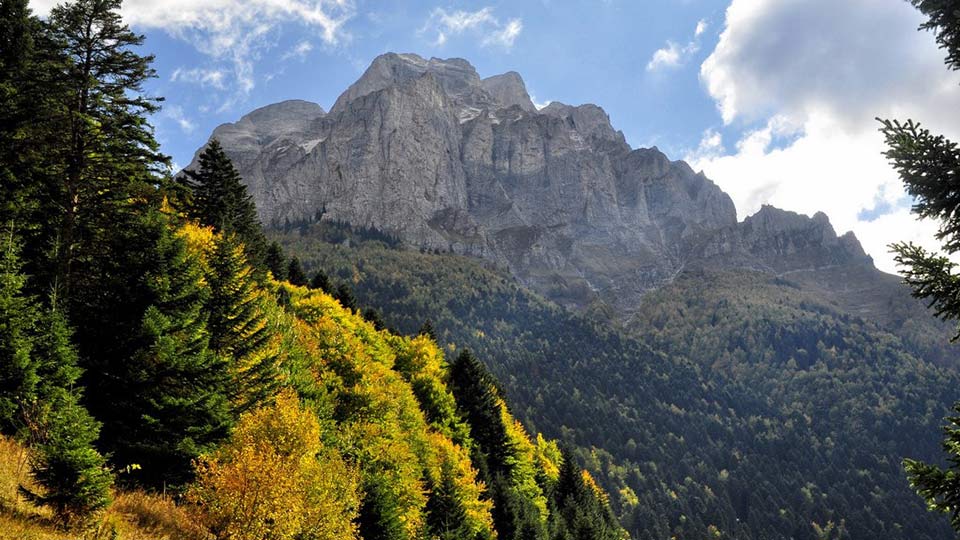
Rivers in the Polog region
On the Radika River lies the most attractive canyon in the country, the 42 km long canyon Boric, with hundreds of meters high vertical sides. Geologically, in the Polog planning region, a large area belongs to the limestone composition. Thus, there are various karstic areas and underground forms. Of these, the caves are the most attractive. For tourists we recommend the caves Sharkova Dupka on Bistra (a cave that is adapted for visits) and Gjonovica or Ubavica (Beauty) on the Bukovik Mountain, as well as the caves of the Suva Gora Mountain.
The longest river in the Republic of Macedonia has its spring in the Polog region. It is the river Vardar, with a length of 301 km. Other famous rivers are: Pena, Radika, Mavrovska, Bogovinska, Mazdracha, Padalishka and so on. The most famous spring in the region is the karst spring of the river Vardar, known as Vrutok, with a capacity of 1.5 m³ water per second. The village of Vrutok is famous for the spring of Vardar, the hydropower plant holding the same name and the specialized fish restaurants, today Vrutok is a modern village settlement with enormous potential for eco-tourism. The Golden Trout was created for the first time in the Vrutok's fishponds, and later the Silver Trout.
Lakes and waterfalls in the Polog region
The Mavrovo Lake was created in 1947 and it is located at 1 200 m asl. It is 10 km long, 5 km wide, and 50 m deep. Here, in the Polog planning region, there are several mountain lakes, the most numerous of which are on Shar Planina. There are eight on the mountain Korab, the most famous of which are the Korab and Kobilino Lake. On the Deshat Mountain there are five - Sveta Nedela, Lokuf and other, and on Stogovo, there are three - Gorno, Dolno and Marusha..
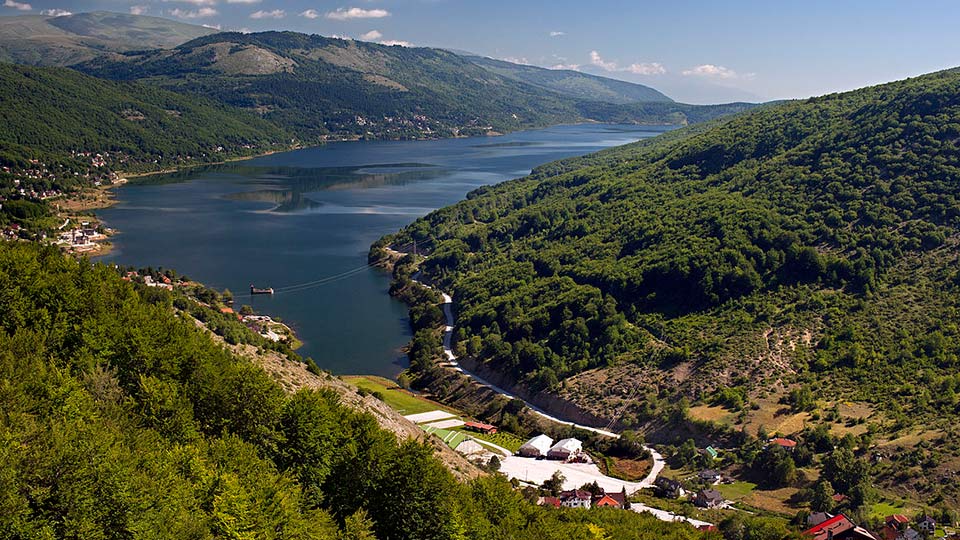
In the Polog region, is also the highest waterfall in the country, and it is Dlabok Dol, 136 meters high. There are several waterfalls on Shar Planina, the most famous of which is Belovishki Vodopad with a height of about 80 meters. Another famous and visited waterfall from the tourists is Duf, 28 m high, located near the village of Rostusha. The Mavrovo National Park was declared in 1949. It covers an area of 73.088 ha. Within the park are the Mavrovo Lake, the mountains Bistra, Desat and Korab, as well as parts of Shar Planina and Krchin and the mouth of the river Radika.
Natural and cultural-historical heritage in the Polog Region
From the cultural and historical heritage in the Polog region, according to their tourist potential, especially distinguished are the: cultural-historical monuments in Tetovo, the monastery St. Athanasij or the Lesok Monastery (1335), Sharena Dzamija (the Painted Mosque) (1495), the Arababati Baba Tekhe (XVIII), the Tetovo Kale, the cathedral church of St. Cyril and Methodius, the church Bogorodica (Holy Mother of God), the monastery St. Naum on Popova Shapka, the church of St. Nikola. Famous cultural and historical monuments in Gostivar are the: Clock Tower, Church of St. Nikola, the church Uspenie na Bogorodica, etc. In the valley of the river Radika is the famous monastery St. Jovan Bigorski (XVI).
Lesok Monastery
The Lesok monastery in the village of Lesok has two churches: St. Atanasij and Bogorodica. The Church Bogorodica was built in the 13th century. It is mentioned in the decree of Stefan Decanski from 1326. The Church St. Atanasij was built in 1335, by the monk Antonij, who later became the first Polog Bishop Joanakij. The latest archaeological excavations revealed significant data, which testify that the building lies on an old VI century church. In the monastery complex is the tomb and the memorial with the epitaph on the tombstone of Kiril Pejcinovic - one of the most important Macedonian revivalists. Next to the monastery is also the hospital for lung diseases. The monastery complex (along with the lodgings) during the year is visited by many believers and tourists and is suitable for summer monastery tourism.
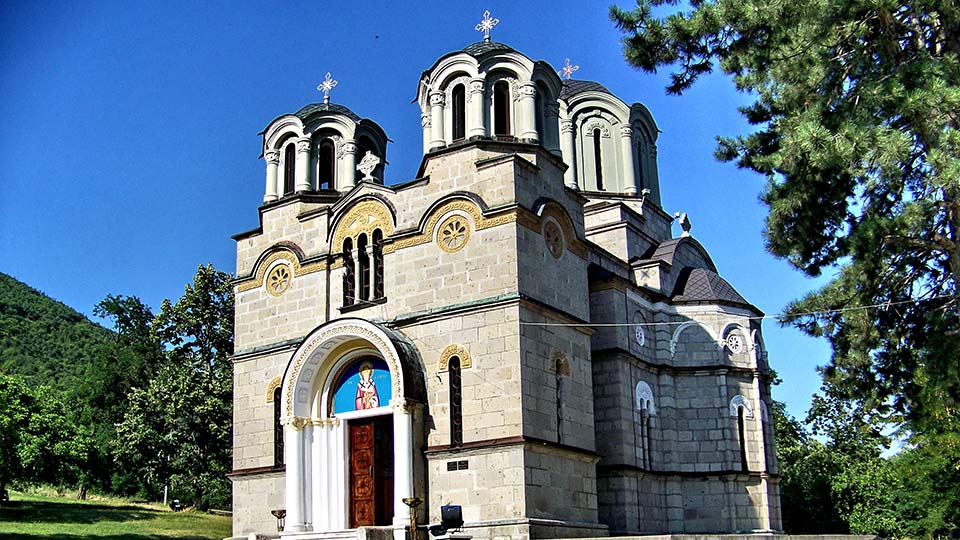
Sharena- Painted (Aladza) Pasha Mosque
Sharena-Painted (Aladza) Pasha Mosque is located in the old part of Tetovo. The construction of the original mosque dates back to 1495, and its legators are the two sisters Hurshida and Mensure, buried in the eight-sided turbe, in the courtyard of the mosque. In 1833, the mosque was renovated and expanded by Abdurahman Pasha. The mosque is significant for its interior and exterior painting decorations. Architecturally, it is a square building in which the Baroque and neoclassical Ottoman style are reflected.
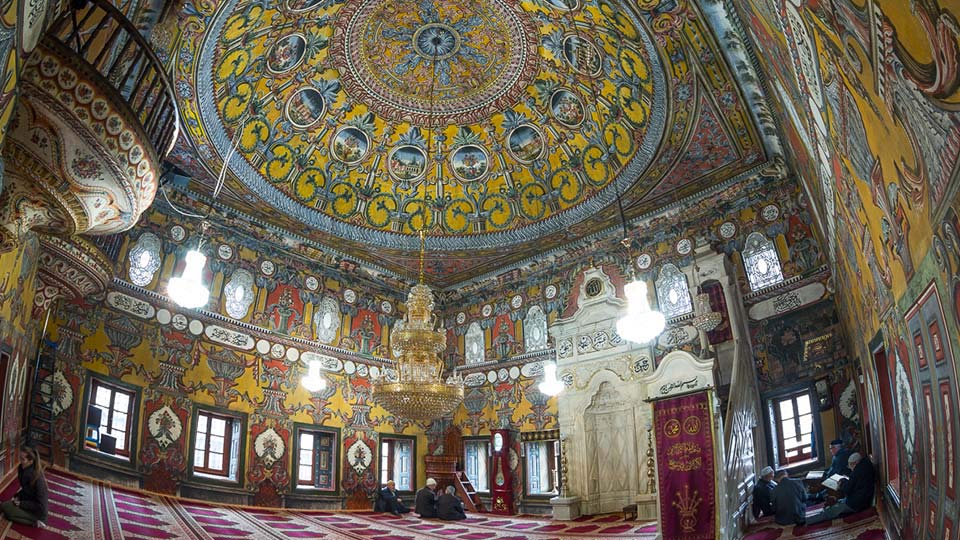
Arababati Baba Teke
Arababati Baba Teke in Tetovo was built in the XVIII century by Redzep Pasha and his son Abdurahman Pasha. The teke represents a complex of religious buildings, grouped around the turbe (grave) of the sufi Sersem Ali Baba. Nowadays preserved are: the basin, turbe, tower, several fountains, kitchen, dining room, guest accomodation, dervish hane (the deke was used by the dervish order - sufis known for their dervish life), haremlak, lots of greenery, flowers and fruit trees. Today, in this complex of religious buildings, the National Museum of Tetovo is located.
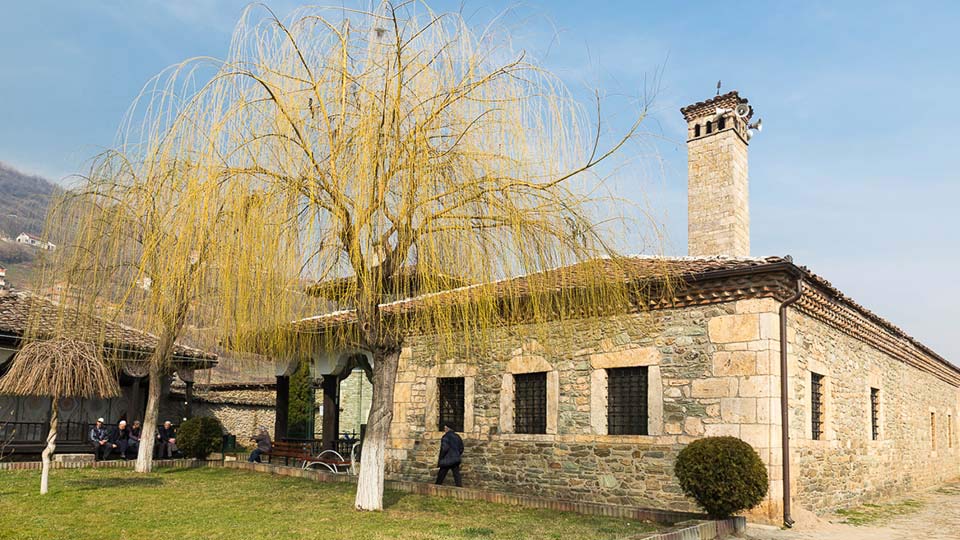
Tetovo Kale – Fortress
Rexhep-Pasha began to be built the fortress and its construction lasted for 20 years and was completed by his son Abdullahman Pasha in 1820, but he also failed to open the building because he was summoned by the sultan and left for Istanbul and never returned to Tetovo. Therefore the fortress was left uninhabited and unused. The archaeological complex consists of five serraglios, large kitchens, a bath and one well in the middle. On the fortress there are remains of a complex of warehouses, kitchen – dining room, towers, an underground prison and three tunnels. From the older remains, there is a medieval church from the 14th century – dedicated to St. Athanasij.
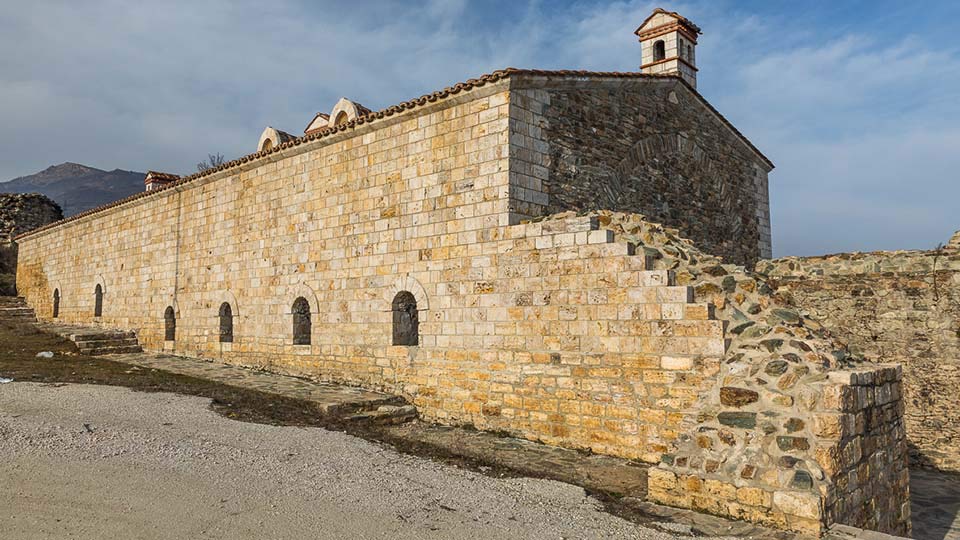
Bigorski Monastery
The monastery St. John the Baptist or Bigorski monastery was built on a limestone rock from limestone, which is why it was named Bigorski monastery. The Bigorski monastery is a monastery complex located on the road between Gostivar and Debar, in the immediate vicinity of the villages Rostushe, Bitushe, Velebrdo and Trebishta, along the river Radika. According to the Bigorski screed, the monastery was founded by the monk Jovan (John) in 1020. In the 16th century the monastery was destroyed by the Ottoman rulers and only one small church remained from the whole complex. The monastery was rebuilt in 1743 by the Hieromonk Ilarion, who was the first abbot of the Bigorski Monastery in recent times.
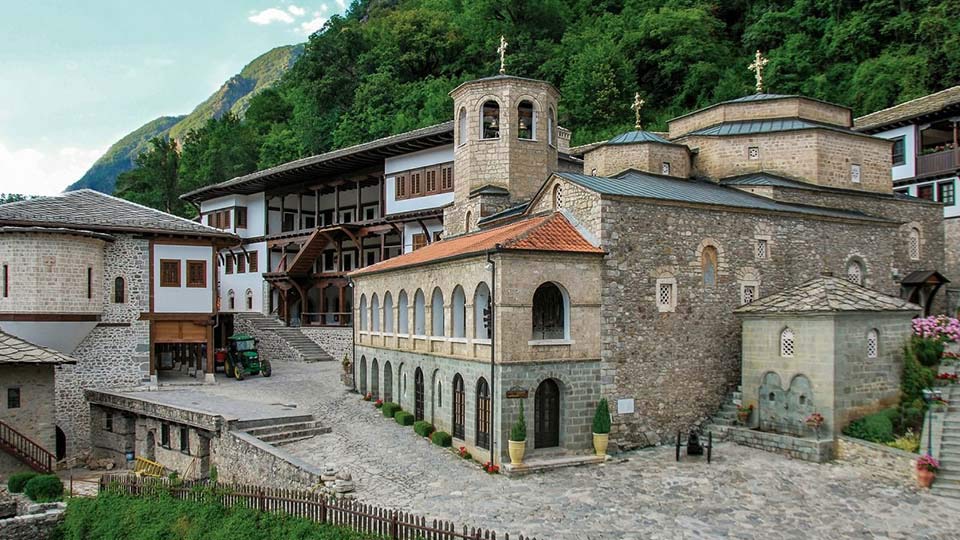
Additional information about the Polog region
In the region throughout the year, several cultural, sports, entertainment and other events are organized. The most famous are the "Galichnik Wedding" (12 July on Petrovden), "Snowy City" (Children's resort "Bunec" - Mavrovo), "Shar Planina Ski Cup", Tetovo Festival, Lesok Folk Fest, Tetovo Choir Echos, Days of Naim, "Mavrovo Memorial ", “Traditional Korab Mountain Climbing”, “Traditional Titov Vrv Mountain Climbing," “Sheep and Goat Breeders Day" and so on.
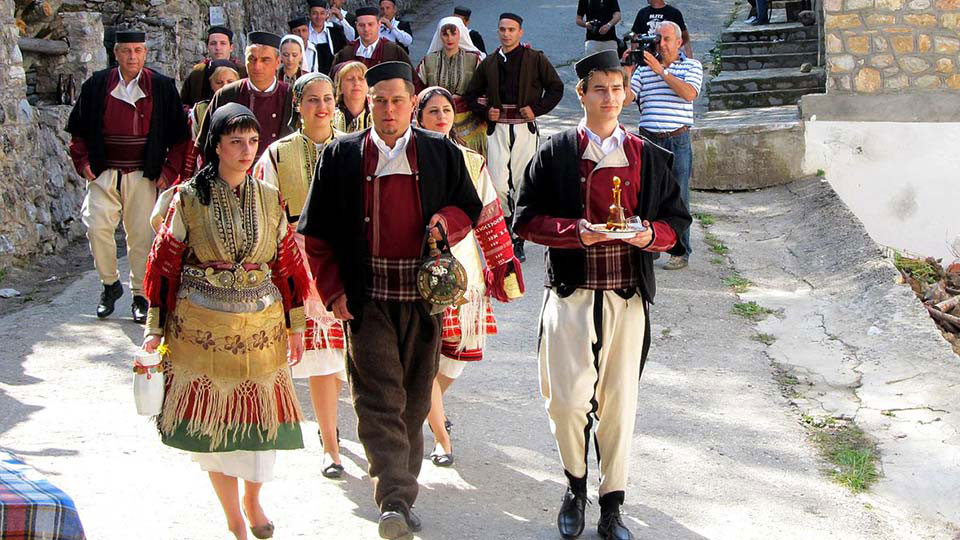
Mijaks - a part of the Macedonian people who live in the Mijak Region or the Dolna Reka Region beside the river Radika. They are known for their culture, architecture, customs and cultural and national heritage. The traditional Mijak costumes are widely known.
More information on the Polog region can be found in: Centre for development of the Polog planning region.
Skopje
Basic information about Skopje
The capital of Macedonia is the city of Skopje. It is the largest city in the country and at the same time it represents an administrative-political, economic, cultural and educational-scientific centre. It is located in the northern part of the country, divided into two parts by the river Vardar. The city in the course of its existence, depending on the historical circumstances, was named by different names, and its ancient name is Skupi.
General data on the City of Skopje
Skopje is a city in the central part of the Balkan Peninsula. It communicates easily with the Mediterranean region to the south and the area of Central and Northern Europe to the north. Through the Kacanicka Ravine it connects with the Adriatic Sea. To the east, through Kumanovo and Kriva Palanka it connects with the Republic of Bulgaria, to the west it connects with Polog, Kicevo valley, the Ohrid-Prespa region and the Republic of Albania.
Skopje dates from the pre-ancient period. This city had a strategic significance in the ancient period, when it was known as Skupi. Excavations from the ancient town of Skupi are located in the area of Zajcev Reid above the mouth of the Lepenec River in Vardar, near today's village of Zlokukani. At that time Skupi was the capital of Dardania.
Skopje’s History
In the Byzantine documents, the city of Skopje was called Skopia, and the Slavs also referred to it as Skopie, Skopje or Skoplje. During the reign of the emperor Samoil, the city belonged to the Samoil's kingdom, while in the later period it was under Byzantine, Bulgarian and Serbian rule. In 1392, the city was captured by the Ottomans and it was named Uskup (Üsküp).
In 1962 due to heavy rains, the river Vardar flooded Skopje. The flood was an indication of the largest earthquake the city experienced. On July 26, 1963, at 5:17 am, the city was devastated by an earthquake measuring 9 degrees on the Mercalli scale (6.1 according to the Richter seismic scale). Due to the earthquake, 1,070 people have lost their lives, 90% of the city buildings have been demolished, and over 20,000 people have been left homeless. After the earthquake, the city began to be built on a model of the designs of Kenzo Tange and Adolf Ciborovski. The old railway station, today is a museum of the city of Skopje and a symbol of the great earthquake. The clock of the station has forever stopped at the fatal 05.17 hrs. in the morning.
Today, Skopje is considered a city of solidarity due to the fact that specifically with solidarity, the city managed to renew itself. The initial assistance to the citizens came from all Yugoslav republics at that period, and a few days after the earthquake aid and rescue crews from all over the world arrived. Exactly 87 nations in the world provided assistance and helped for the city to be built again.
Geographic characteristics
Skopje is located at 21° 26′ geographic longitude and 42° north geographic latitude. The altitude in the centre of the city is 240 m, it extends on an area of 1,818 km2, with 9 km in width and 23 km in length. The city's climate is characterized by an average annual temperature of about 12.4°C. The summers are long, dry and hot, and the winters are cold, with many misty days. The River Vardar flows through the valley of Skopje with its tributaries: Treska, Pchinja, Markova Reka, Lepenec and Kadina Reka. The Skopje valley is surrounded by the mountains: Vodno, Karadzica, Osoj, Zheden and Skopska Crna Gora.
Main features of Skopje
Places of interest for tourist sightseeing tours are:
- The Stone Bridge, on the river Vardar is a symbol of Skopje. It was reconstructed in the 15th century and represents a connection between the new and the old part.
- Fortress Kale - The first walls were built at the beginning of the 6th century. The fortress dominates the left bank of the river Vardar overlooking the old part of the city.
Kale – Fortress of Justinian I
It is thought that the area of the fortress Kale, known as the Skopje Kale, was inhabited as early as in the Neolithic period and early Bronze Age, as witnessed by numerous archaeological findings. The fortress itself dates back to the time of Emperor Justinian I (535). Due to its strategic position and role, the fortress throughout history had often been attacked and used by various warriors. After the collapse of Samoil's empire (1018), the city was captured by the rebels of Peter Deljan (1014-1041). It was then attacked by the Kumanians, the Scythians, the Pecheneses, and so on. Various archaeological remains were found at the Kale. Today the fortress Kale is one of the most remarkable buildings in Skopje with the presence of a number of different cultural and tourist motifs.
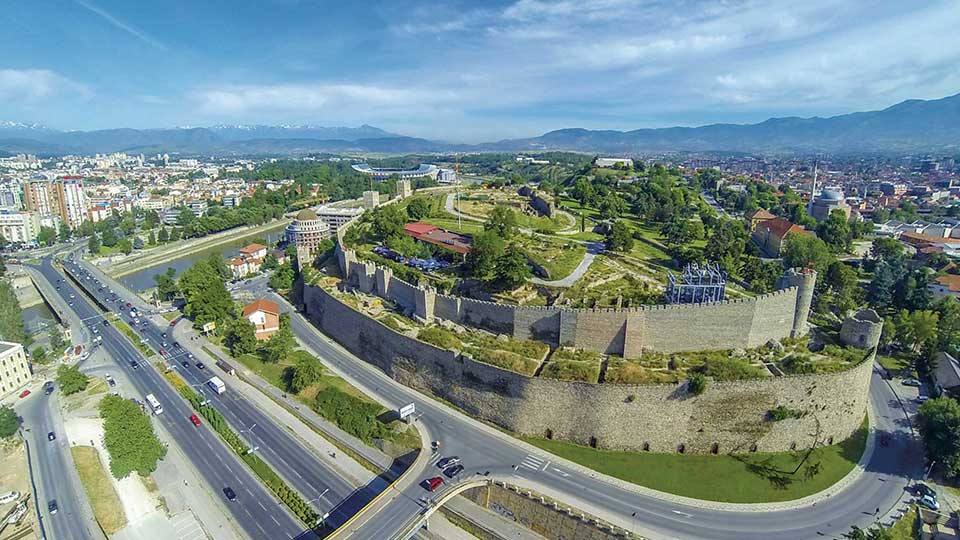
Stone Bridge as a symbol of Skopje from the 15th century
The stone bridge on the river Vardar was built in the first half of the 15th century. The bridge connects the old with the new part of the city. Side walkways were built in 1905, and in the last decade of the 20th century it was completely renovated. On the left side of the river on the bridge there is a memorial plaque of the shot citizens of Skopje in 1944 during the fascist occupation.
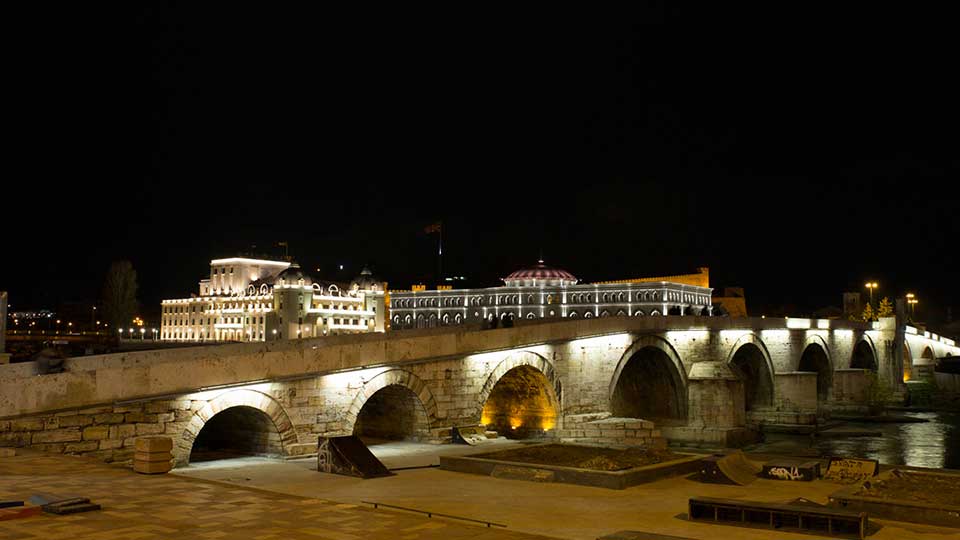
In its original form, the bridge had 13 arches, with a total length of 215 metres and a width of six metres. In order to restore the original appearance of the Stone Bridge, in 1992, new interventions started, whereby the initial width of the bridge was achieved.
Church St. Spas in SKopje
The Orthodox Church "St. Spas ", in the old part of the city was built in the XIX century. The iconostasis contains beautiful wooden carvings, carved by the mijak carvers Petre and Marko Filipovski and Makarie Frchkovski. In the courtyard of the church is the tomb of the greatest Macedonian revolutionary of the 20th century - Goce Delcev, and next to it is the Old Turkish Bazaar, where there are old crafts, Bezisten, Chihte-amam and other important facilities.
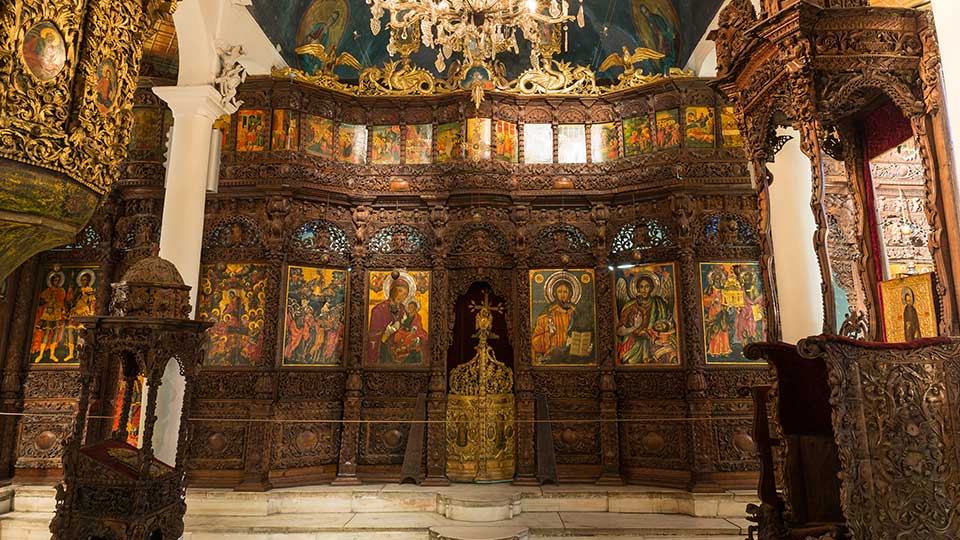
Porta Makedonija (Gate Macedonia)
It was built in 2011 and was put into operation at Christmas 2012. The building has dimensions of 20 to 10 meters and a height of 21 meters. The facade is decorated by 32 reliefs in deep carving with a total area of 193 m2.
The reliefs depict images from the prehistoric period through the pile-dwelling in the Bay of Bones, from the antique with Philip II and Alexander III of Macedonia, from the Roman period to Justinian I, from the Middle Ages with Tsar Samuil, King Marko and Karpos, and until the XX century with Ilinden, ASNOM, the Exodus from Aegean Macedonia and September 8, 1991 - the proclamation of an independent Macedonia.
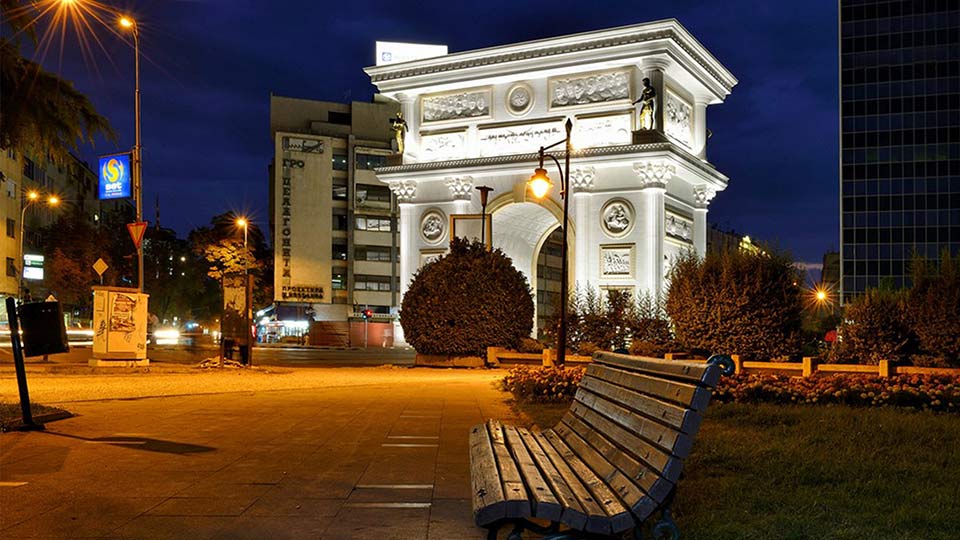
There are also reliefs of the monastery St. Jovan Bigorski, an Ohrid house, Daut Pasha Amam, the Poetry Bridge in Struga have also been represented. Inside there is a souvenir shop and gallery space on two levels, and at the top an observation platform.
Warrior on a horse
The monument is a composition of several elements. Alexander's bronze monument has a height of 14.5 metres and weighs 30 tons. In the middle of the ten-meter-high pillar is the warrior Alexander II of Macedonia, known as Alexander the Great, looking in the direction of the sunrise. On that pedestal there are three rings with mounted plates, representing three battles. Among them there are three rings of bronze, with decoration and ornamental reliefs. Around the pillar is a fountain complemented by eight bronze soldiers that are three metres tall and eight lions, two and a half metres high, four of which are facing the fountain. The monument is a work of Valentina Karanfilova - Stefanova.
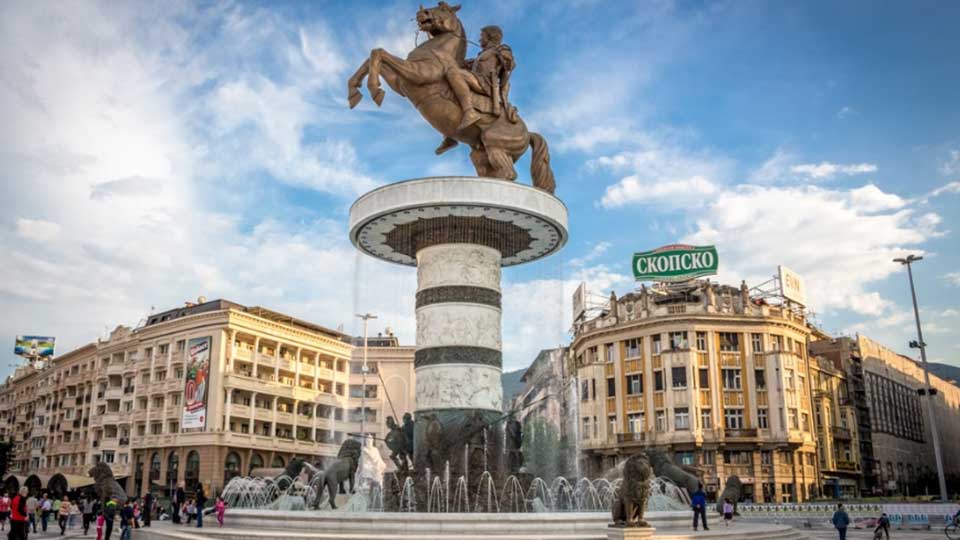
Macedonia Square
Macedonia Square in Skopje was more fully formed in the period between the two world wars, more precisely from 1920 to 1940. It is located in the context of the Stone Bridge, as the basic link of the city units from the left and the right side of Vardar. Important facilities were located around it: the National Bank, the Post Office, Officer's Building, Na-Ma Department Store, Hotel Macedonia, Ristic Palace. However, after the Second World War, and especially after the 1963 disastrous earthquake, part of the buildings were demolished, so that today the square in Skopje has a somewhat different arrangement, but there are still important administrative, cultural, shopping, banking, catering - tourism, and other facilities in its immediate vicinity. In its immediate vicinity is also the Pella Square with the Gate Macedonia, as a real gateway for an entrance to the square.
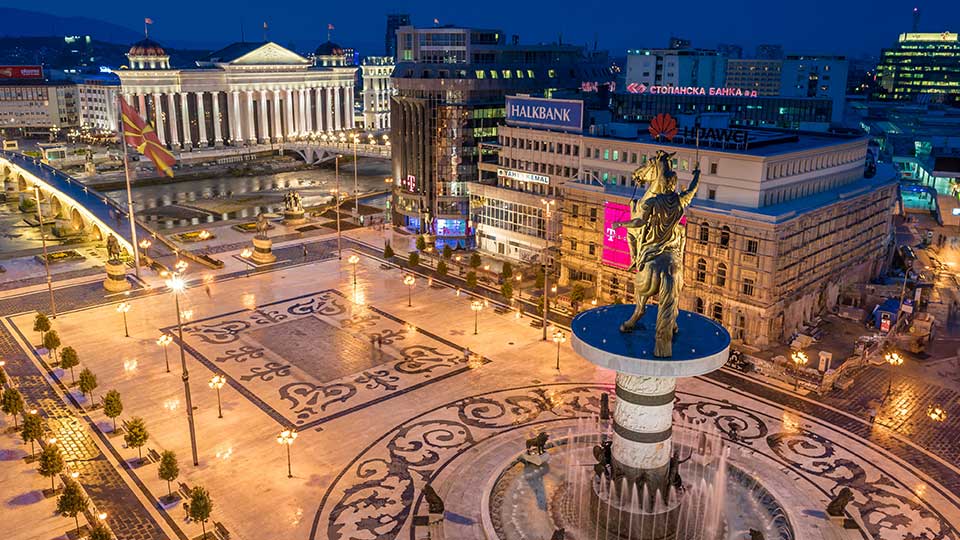
Monuments in the central city area
In the period from 2010 to 2012, Macedonia Square was enriched with several monuments of the famous Macedonian revolutionaries from the time of Ilinden 1903 and ASNOM 1944. Immediately beside the Stone Bridge, the monuments of the Macedonian revolutionaries Goce Delchev and Dame Gruev rise. Opposite them is the monument of the first president of the Presidium of the National Assembly of the People's Republic of Macedonia, Metodija Andonov-Cento. Opposite, and next to the grandiose Warrior on a horse, the five meter marble statue of Tsar Samuil rises, set on a pedestal in the height of 3.5 meters. On the square itself is the monument of Dimitrija Cupovski, and in the park "Zena Borec" opposite the Assembly of the Republic of Macedonia, a memorial - sign of the First Session of ASNOM was placed.

On the quay of Vardar are the monument of Justinian I, five meters high, placed on a pedestal of 3.5 meters. Against him, the figures of the bronze Gemidzii are placed. Near the Stone Bridge on the side of the Old Bazaar, the bronze monuments of the Aidut military duke Peter Karposh and Gjorgjija Pulevski are placed, as well as the monuments of Ss. Cyril and Methodius and Ss. Clement and Naum of Ohrid.
Memorial house of Mother Theresa
The memorial house and the memorial of Mother Teresa (1910 - 1997) are located on the street Macedonia, in the centre of the city of Skopje. It is dedicated to the great humanist Agnesa Gondza Bojadziu - Mother Teresa, born in Skopje, winner of the 1979 Nobel Peace Prize. Today, Mother Teresa’s missionaries of charity include over 3,000 sisters and over 500 brothers in many countries around the world.
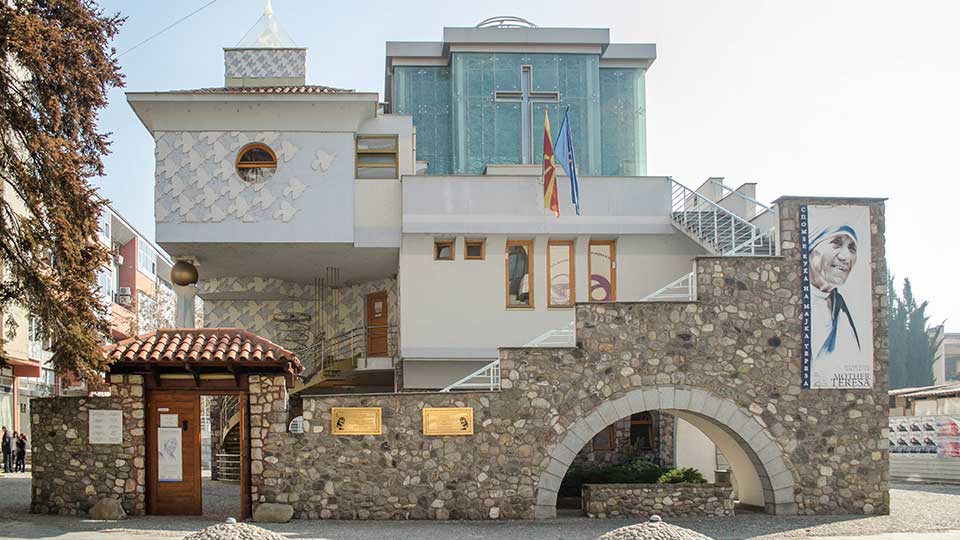
Mother Teresa was proclaimed an honoured citizen of her hometown of Skopje, which from her departure for a humanitarian mission to help the hungry and desolate people she visited four times: in 1970, 1978, 1980 and 1986.
Cathedral St. Kliment Ohridski (Clement of Ohrid)
The cathedral St. Kliment Ohridski is a facility from the recent history of the Macedonian church building. Its construction dates back to the seventies and eighties of the 20th century. It was consecrated in 1990. It is the seat of the Macedonian Orthodox Church - Ohrid Archbishopric. It is located in the centre of Skopje.

Old Bazaar
In Skopje, on the left side of Vardar, through the Stone Bridge is the Old Skopje Bazaar. Part of the city with diverse and rich history, tradition, culture and architecture, today with a blend between the old and the new, the economy and trade, culture and tradition. In the spirit of the historical temporal and developmental circumstances, the culture of organization and tradition of living, the Old Skopje Bazaar has preserved numerous functional facilities from the Ottoman period, and new buildings have been built as a feature of modern times. These include the Skopje Bezisten, Kapan An, Suli An, Kurshumli An, Daut - Pasha Amam, Cifte Amam, the church St. Spas, the church St. Dimitrij, the complex of museums of Macedonia (historical, archeological, ethnological museum).
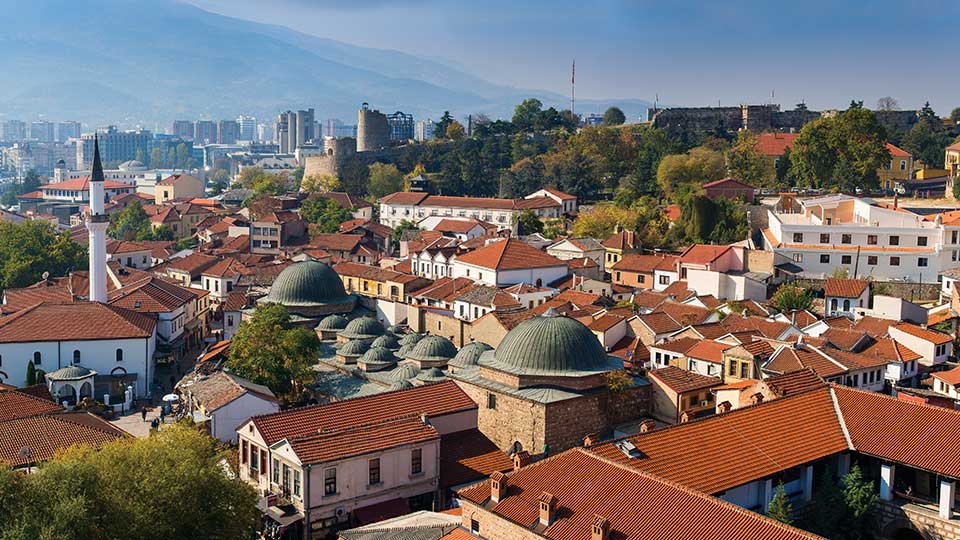
The Old Skopje Bazaar, dating from the 12th century, most actively developing from the 15th to the 19th century, is a complex economic - trade, architectural and cultural - traditional assembly. It was built in oriental style, with several wider and more narrow and cobblestone paved streets. Along them, blinded to each other, there are various craft and trade shops. Here, you can find various traditional crafts, blacksmiths, goldsmiths, potters, shoemakers, tailors, watchmakers, tinsmiths, saddle-makers with various production and service activities. There are also various shops for modern industrial goods and products that can be found only here. The Old Bazaar is complemented by the largest green market in Skopje. The Bazaar is the centre of the most attractive catering shops with a variety of traditional dishes.
Daut - Pasha Amam, an impressive monument of Islamic architecture and art gallery
Daut Pasha Amam is a bath built during the 15th century by the great Vizier of Rumelia. It was probably built by masters of the famous Debar bricklayers’ school. Built in the centre of Skopje, in about hundred metres from the Stone Bridge, the Amam was fully restored in 1948. The most striking part is the roof, composed of 13 unequally distributed domes. Inside there are 15 rooms, different in size, interconnected with vaulted ornaments decorated with oriental ornaments. Besides Cifte Amam and Mala Stanica, today it is part of the National Gallery of Macedonia. Daut Pasha Amam has a collection from the 15th and 16th century, with a rich collection of paintings from the 18th and 19th century, as well as from the contemporary Macedonian painting.
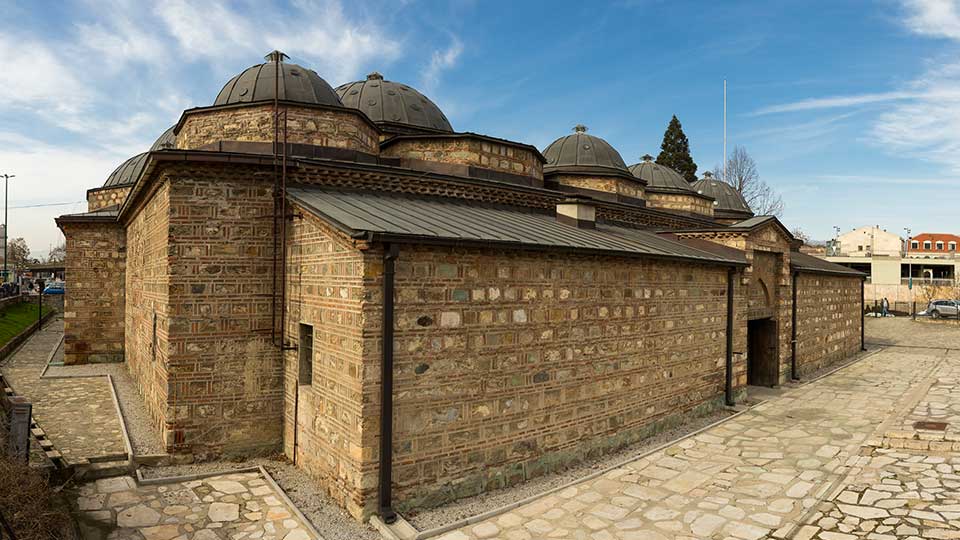
Kurshumli an is a recognizable historical heritage of Skopje
It is assumed that Kurshumli An (lead an) was built in the middle of the 16th century. It consisted of two parts - one for the placement of merchants and goods, and the other included the barn, the auxiliary rooms, and the rooms for the servants. For a long time it served as a gathering place for merchants and their caravans and played an important role in the development of the city's commercial life. It retained the role of a lodging until the end of the 19th century, and then it was converted into a prison. It is believed that it obtained its name during the 19th century, due to the roof that was made of lead. Impressive are the semi-circular walls on the second floor and the fountain in the middle of the an. Today in the an there is a lapidarium of the Archaeological Museum, located in the cells of the ground floor. Each cell contains monuments originating from the same area and from the same period, when Macedonia was a Roman province.

The City Konak Sully An is today a gallery and museum
Suli an is a 15th century building, built by Ishak Bey. In the 16th century it was upgraded, so that the upper floors became trade shops. During the earthquake it was severely destroyed, but it was restored acquiring its original appearance. Today it is the seat of the Gallery of Contemporary Art and the Faculty of Arts, and since 1983 the Museum of the Old Skopje Bazaar has also been located there.
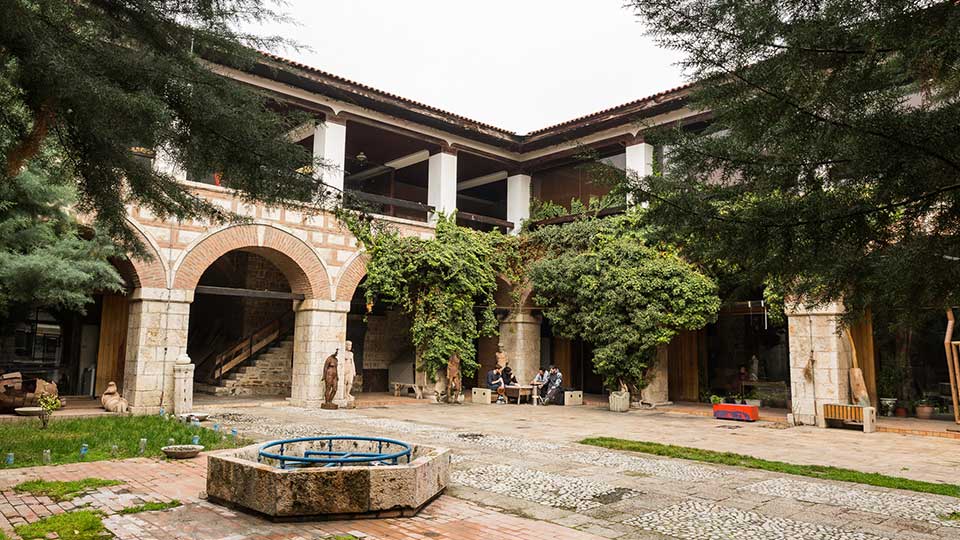
Mustafa - Pasha Mosque one of the most magnificent buildings of the Ottoman period of Skopje
The Mustafa - Pasha Mosque was built by the Skopje commander Mustafa Pasha in 1492. It is located opposite the entrance of the Skopje Fortress. The mosque is basically a quarterly architectural pedestal built of marble blocks decorated with various ornaments. The minaret is built of beam blocks. In this mosque is the richly decorated sarcophagus of Uma - the daughter of the builder of the mosque, then the fountain, the remnants of the former imarets, the madrasa, and more. Today it is an important monument of culture and a place for the spiritual confession of members of the Muslim faith.
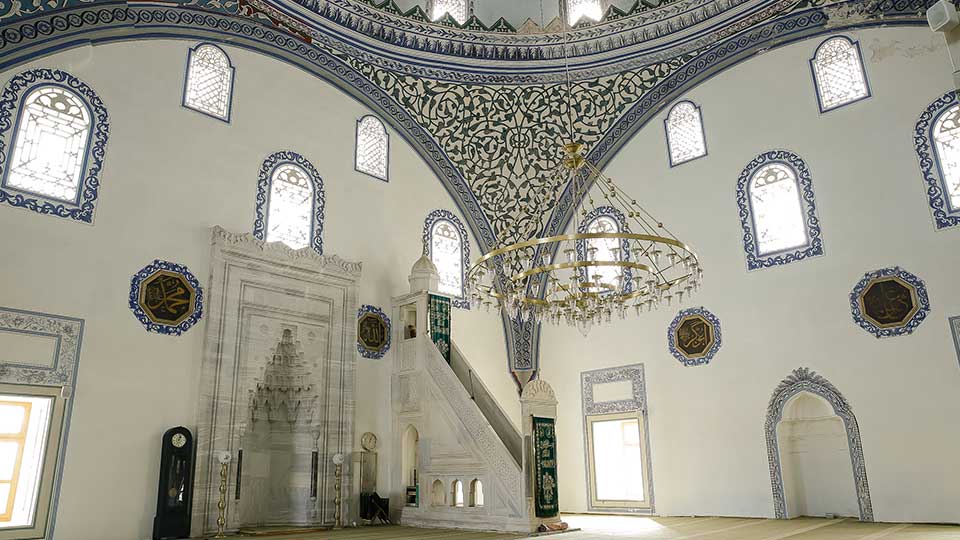
The Clock Tower is the first tower in the Ottoman Empire
The Clock Tower in the Old Skopje Bazaar dates from the middle of the 16th century, more precisely from the period from 1566 to 1572. It is considered to be the first clock tower in the Ottoman Empire, as part of the Sultan Murat’s Mosque. It is 40 meters high and consists of several parts ending with a dome. The clock was lost during the 1963 earthquake in Skopje, when the tower was seriously damaged. Today it attracts noticeable attention with its striking features.
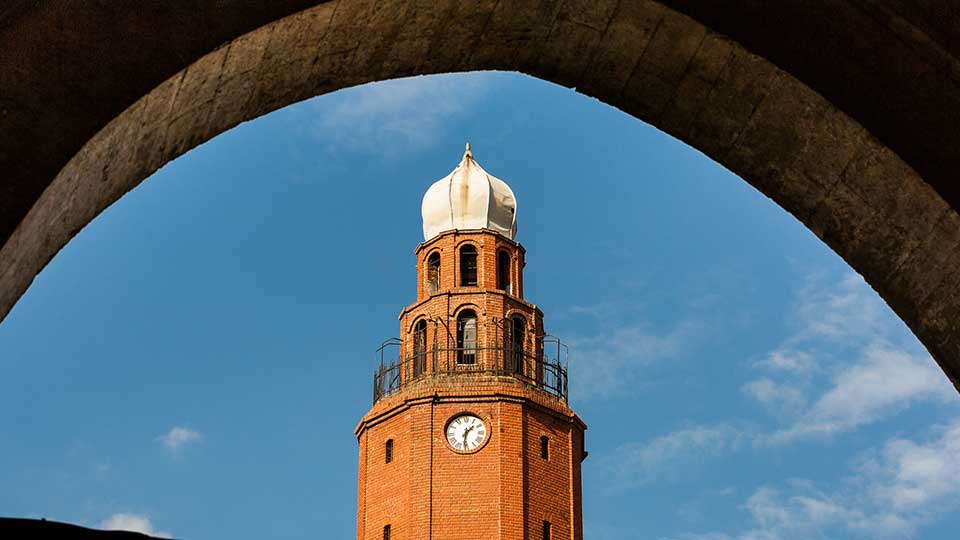
Skender Bey’s Monument
Gjergj Kastriot - Skender Bey (1405-1468) is a national hero from Albania, a fighter for freedom from the Ottoman slavery. As a work of the sculptor Toma Tomai Dema Bekir from Albania, the Skender Bey's monument was set in 2006. Skender Bey is considered a great leader who protected and defended the values of medieval Europe during the Ottoman conquests in the Balkans. The installation of the monument in Skopje is a confirmation of the traditional city spirit of unity.
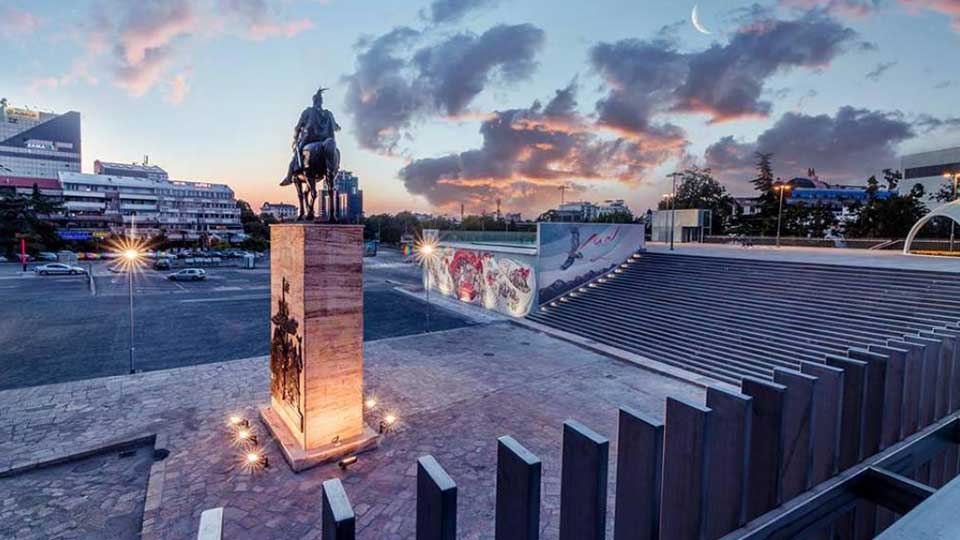
St. Spas one of the most beautiful Mijak carving works
The church St. Spas was built in the late 17th century and is one of the most important cultural monuments in Skopje. It is located right from the Kale fortress. It seems small and insignificant, but has great importance. Especially valuable is the iconostasis, which was created in a period of five years and was completed in 1824. It was made by the brothers Petre and Marko Filipovski from the village of Gari and Makarie Frchkovski from Galichnik. Although relatively modest in size, the iconostasis impresses with the craftsmanship of the performance, with the high artistic quality and richness of content, which puts it in the ranks of the top achievements of carving art. As a cultural monument protected by law, the church performs worship and religious rituals only for the patron’s holiday Spasovden.

Museum of Macedonia
It is located in the Old Bazaar, near the Skopje Fortress. The first Archaeological Museum in Macedonia was established in 1924, and in 1945 the National Museum of Macedonia was established. In 1949 the special departments at the National Museum were transferred into the Archaeological Museum and the Ethnological Museum. The beginnings of the Historical Department date back to 1952. Today's museum complex was built in 1976. On an area of over 10,000 m2, one can see systematic collections of the cultural and historical heritage of Macedonia from the prehistory to the present.
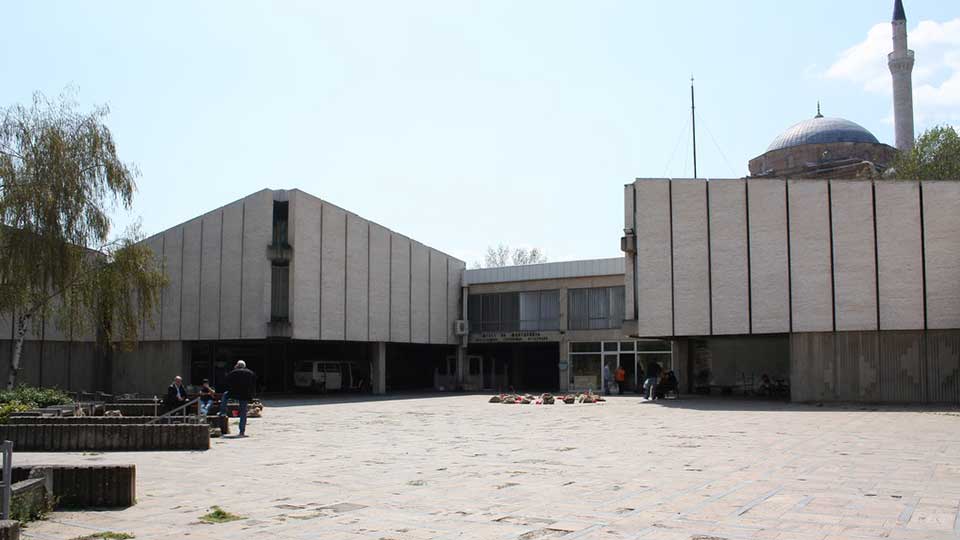
Museum of the City of Skopje - from the Neolithic to the present
The museum is housed in the adapted part of the Old Railway Station, destroyed in the 1963 earthquake. The relatively-preserved part of the building today is in function of the museum, which has a space of 4,500 m2, of which 2,000 m2 is exposing space. The museum owns a fund of about 22,000 museum objects from the Skopje region, distributed in segments of archaeology, history, ethnology and art history. "Walk through the past" is a permanent feature of the museum, which covers the period from the prehistory to the beginning of the 20th century for Skopje with its surroundings.
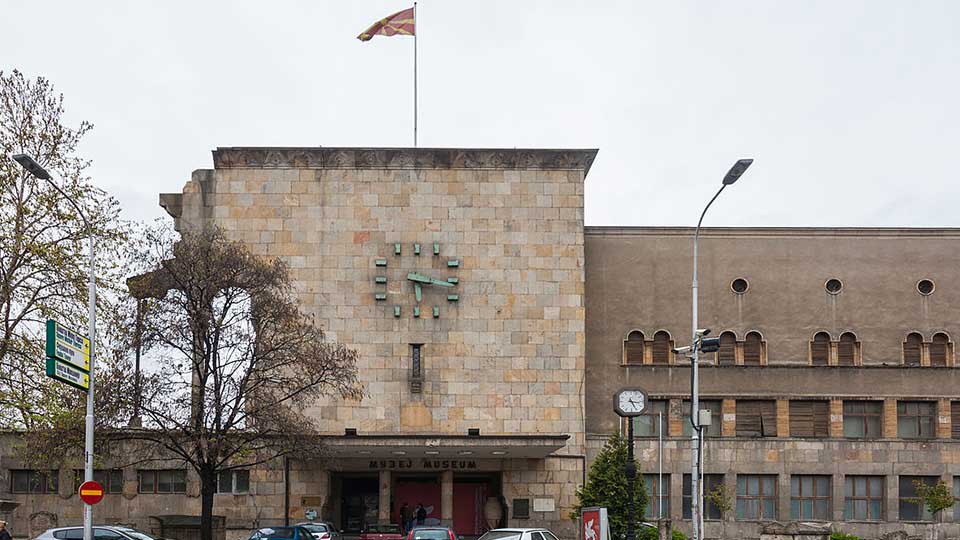
Museum of the Macedonian Struggle
It is located next to the Stone Bridge, on the left bank of Vardar. It was built in the period from 2008 to 2011, and officially opened on September 8, 2011. It consists of 13 units, in which chronologically presents the history of the Macedonian people from the period of the aidutstvo to the period of socialism. At the very entrance to the Museum, the original Macedonian Declaration of Independence is placed. The museum contains 109 wax figures of personalities from Macedonian history, a large number of samples of original weapons and furniture, mass scenes, documents.
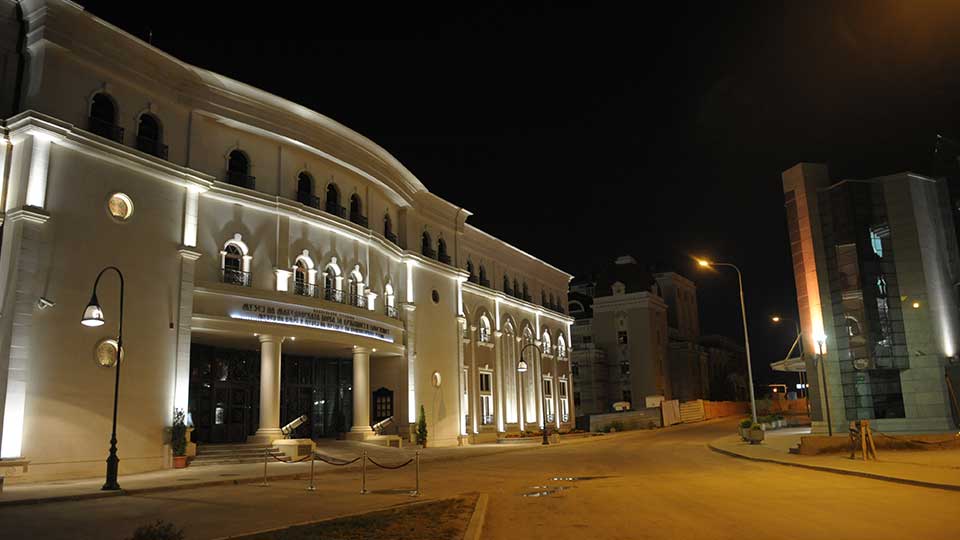
Memorial centre of the Holocaust of the Jews from Macedonia
The Holocaust Museum is a newly built facility on the site of the former Jewish neighbourhood, near the Stone Bridge, as one of the four such museums in the world, despite the museums in Jerusalem, Washington and Berlin. It is dedicated to Macedonian Jews (7,148 people) deported to the Treblinka death camp in Poland during the Second World War. There is a permanent exhibition of the life of the Jews in Macedonia and wider in the Balkans in this museum.
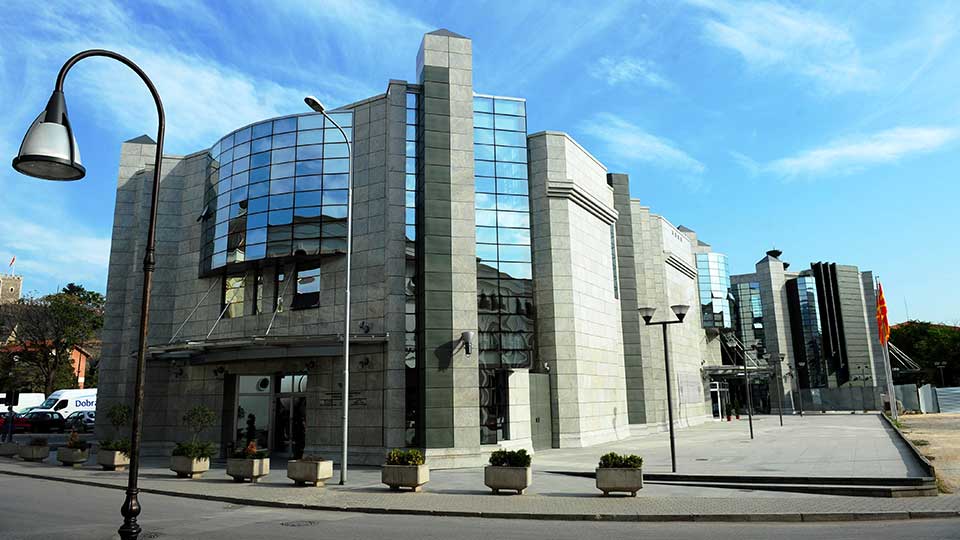
Museum of Contemporary Art in Skopje
The Museum of Contemporary Art is located in Skopje's Kale. It was built in 1970 as a donation from the Polish government, following the 1963 earthquake in Skopje. It covers an area of 5,000 m2 in three interconnected wings. They include the space for the permanent exhibition, temporary exhibition halls, lecture hall, film and video projections, library and archive, conservation workshop, depots, administration and other auxiliary services. It possesses a valuable international collection and provides a representative insight into the Macedonian contemporary art.
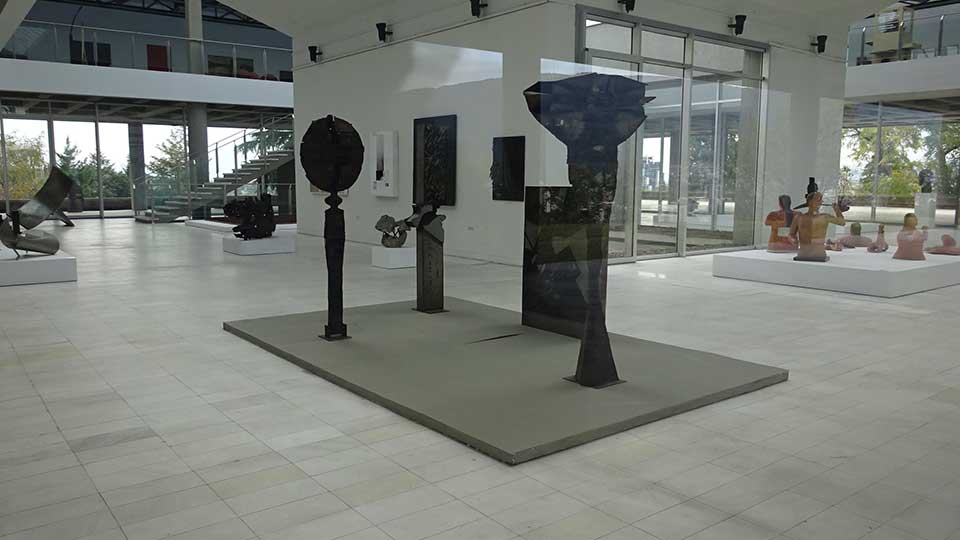
Vodno
Vodno is a mountain site that rises above Skopje to 1,061 metres above sea level. There is the Millennium Cross, the monastery Complex St. Pantelejmon, and Vodno also has a park - forest, mountaineering homes, several catering facilities with arranged hiking trails, car parks and wide panoramic views. From Vodno, you can see almost the entire Skopje valley and the city of Skopje. Therefore, Vodno is one of the most visited sites in the vicinity of Skopje.
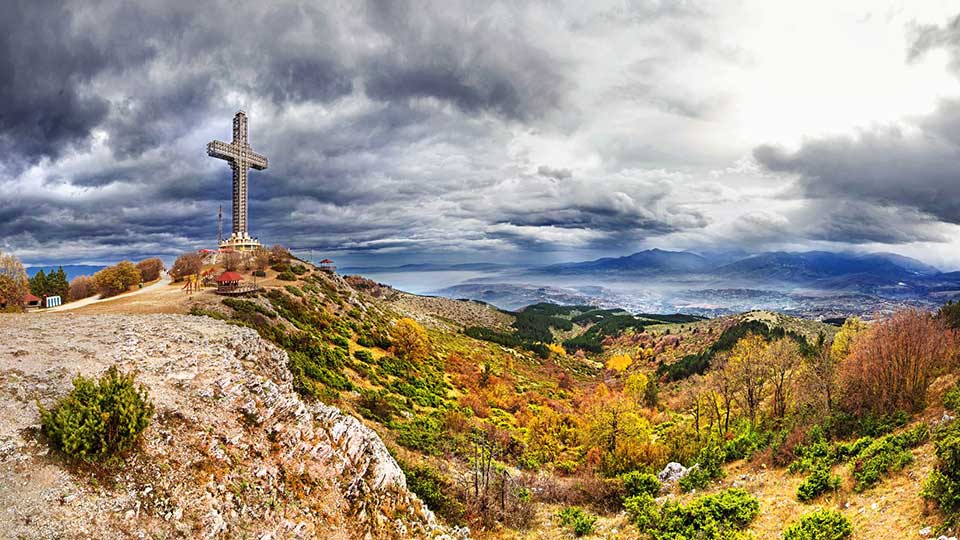
In June 2011, a cable car from Sredno Vodno to the Millennium Cross was put into operation, the alignment of which is 1,750 meters long and climbs from 570 to 1,068 metres above sea level. The cable car has 28 cabins with a load of 640 kg and capacity for eight people, as well as two cabins for four people. The gondolas on the outside are fitted with bicycle holders.
Millennium Cross
With a height of 66 metres this is the highest facility in Macedonia. The Millennium Cross was built in 2000 at the peak Krstovar (1,061 metres above sea level) in Vodno, in the immediate vicinity of Skopje, on the occasion of the passage of the second in the third millennium.
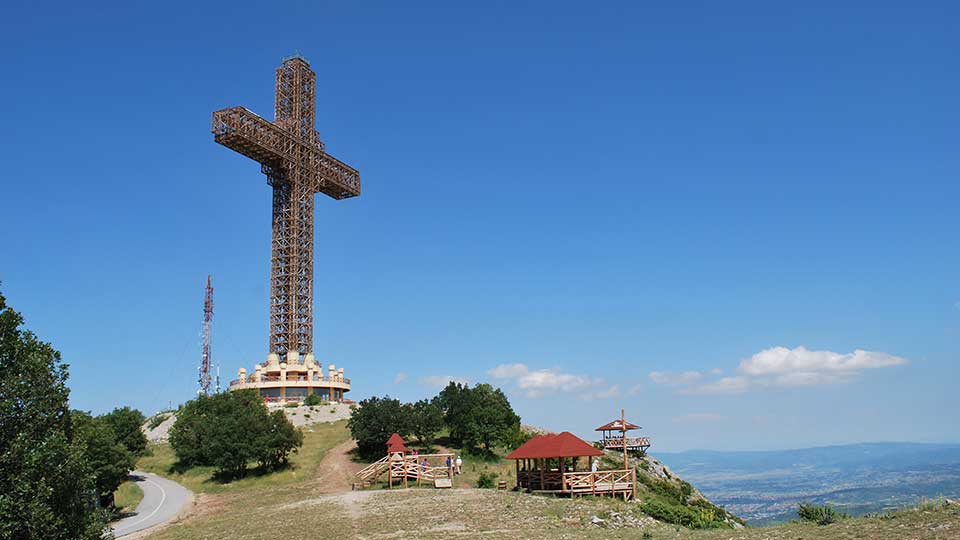
Monastery St. Pantelejmon, Gorno Nerezi (12th century)
This monastery possesses the most important fresco-paint value in Macedonia and one of the most valuable works of European church painting. In this monastery, the Renaissance in the fresco painting begins, almost a century and a half before the appearance of the renaissance in Italy of Giotto. The monastery was built in 1164, during the Byzantine Komnenos dynasty’s rule. This was written on the marble plate, placed above the front door. The best masters and painters of their time have done their best work. It was built with stone and brick, in the form of an inscribed cross in a rectangular space and five domes.
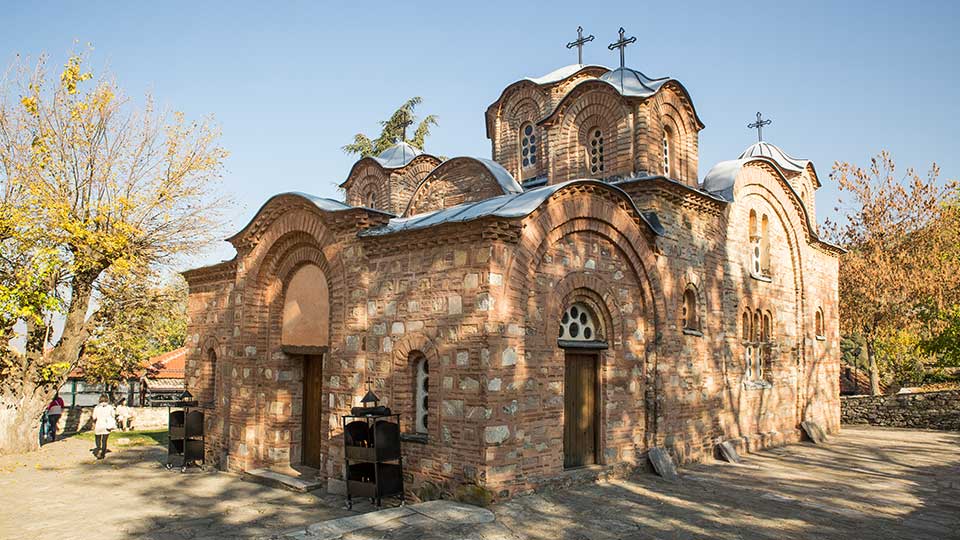
The monastery survived a fire, earthquake, ruin and robbery, but remained a witness to the rich church and cultural life in the 12th century and a church metropolitan centre in Skopje. This monastery is part of all the significant encyclopaedias for culture and art in the world. The 12th century frescoes represent the holy warriors and hermits (first zone), the great holidays (the second zone), and the most important are the frescoes of the Lamentation of Christ and the removal from the cross. The compositions of the Assumption of the Mother of God, The Sorrow, the Mother of God with Christ and Saint Panteleimon are also delightful.
Matka
It is the valley of the butterflies, it is a very characteristic locality in the immediate vicinity of Skopje. It is located northwest of Skopje, at the exit of the river Treska from the long Sishevska Ravine. Matka is a complex of deep, incised canyon, in which the first artificial accumulation on the Balkan Peninsula was built in 1938. There are several caves, an alpine training centre, a regulated flow of Treska for rafting, a complex of several monasteries, a mountain lodge, restaurants, catering facilities, a picturesque nature with rich vegetation and animal life. The accumulation itself covers an area of 0.25 km2. It is 5.9 km long, with a useful volume of 2.6 million m3. It is intended for the production of electricity in Skopje.
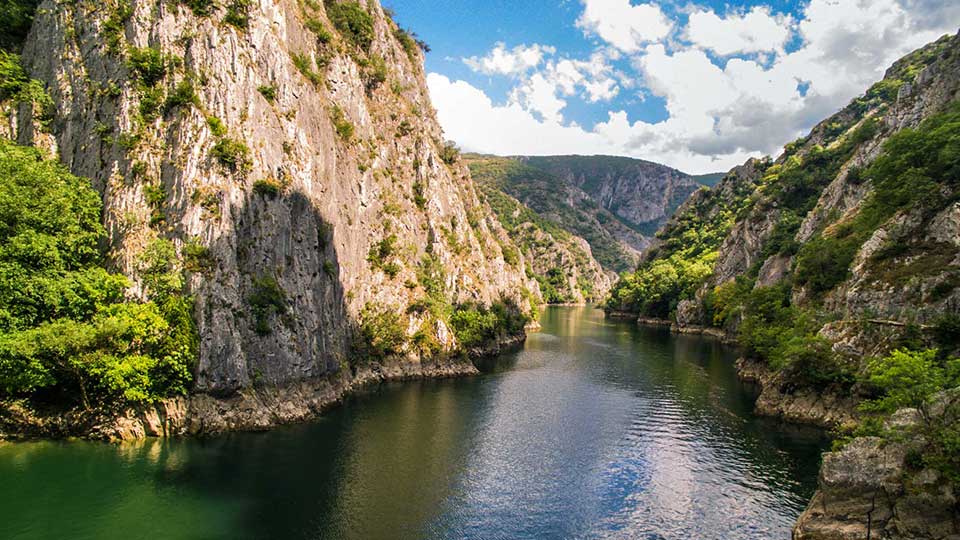
Monastery St. Andrej, Matka ( 1389 )
It was built on the canyon of the river Treska. It was built by Andreja, the second son of King Volkashin, in 1389. It has the form of an elongated trikonhos, with a central dome. Metropolitan Jovan and monk Gregorij, who worked in the monastery Sveto Preobrazenie in Zrze, are also fresco-painters of the monastery.
The frescoes in St. Andrej are a novelty in the Macedonian medieval painting and a mark of the new style at that time with the emergence of hesychasm in monastic life. In three zones, frescoes of the holy warriors Gjorgi, Dimitrij, Teodor, Tiron and Teodor Stratilat are presented in full size, as well as frescoes with scenes from the life of the Lord Jesus Christ. The inscriptions are written in Greek and in the Church Slavonic script.
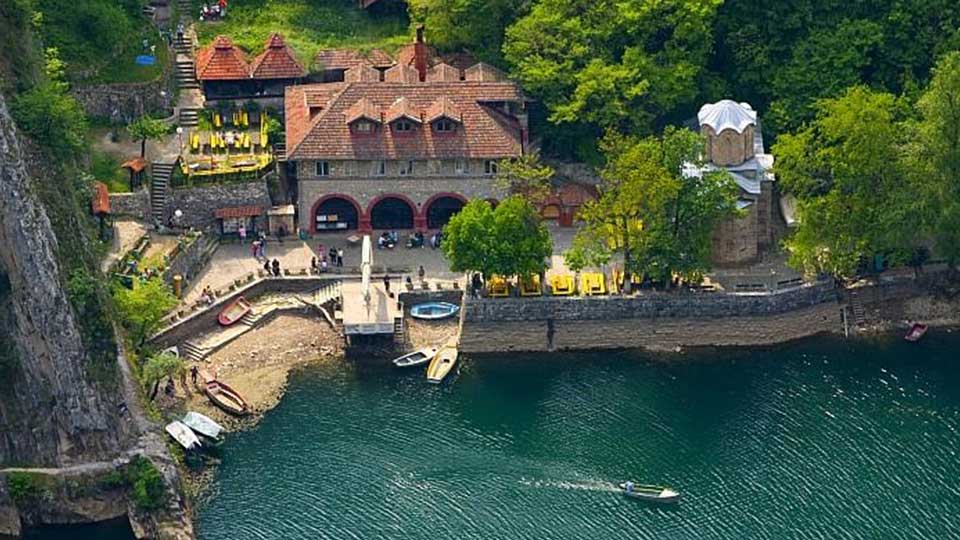
Neolithic village Tumba Madzari
The site is located in the current settlement of Chento and is the most important settlement in the Skopje valley from the Neolithic period - the early stone age. Life here existed continuously between 6000 and 4300 BC, economic prosperity and cultural prosperity in the Middle Neolithic (5800-500 BC). A number of ceramic findings, exhibited at the Museum of Macedonia, have been found here.
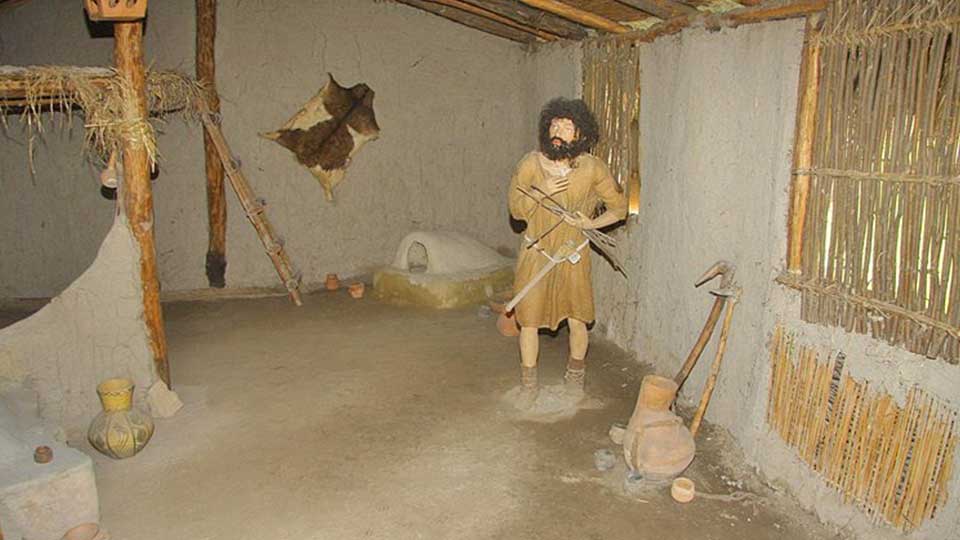
From 2008 to 2010, several houses were built in the spirit of Neolithic architecture, featuring a different inventory, in order to reconstruct the life of the Neolithic human. The houses are made of timber, cane, straw, clad with mud and built according to Neolithic traditions. The layout of the discovered objects on the site indicates a meaningful organization, closely related to the significance and role of the sanctuary.
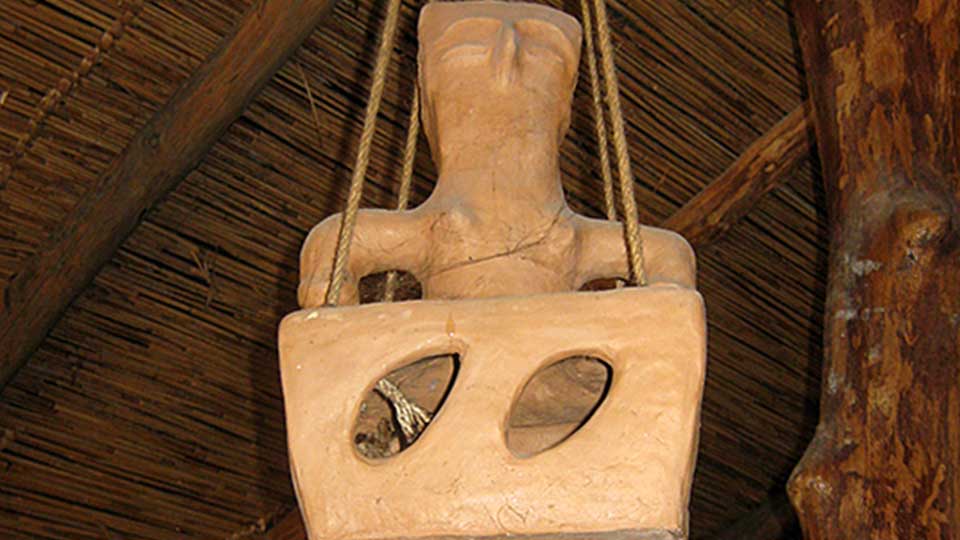
The great mother - goddess of fertility
In Tumba Madzari, for the first time a terracotta presentation of the Great Mother was discovered, represented in an unknown way among the Neolithic cultures from other Balkan regions. The impressive dimensions of 39 centimetres height, a classical calm posture of vigilance over the house hearth, make this terracotta exquisite. The lower part of the figure represents the home protected by her. The Macedonian Neolith is characterized by a cult towards the Great Mother. Such types of figures are found in all Neolithic sites in Macedonia, but perhaps the most beautiful is the Great Mother of Tumba Madzari.
Skupi - a city of Roman and late-ancient times
Archaeological site, located five kilometres northwest of Skopje, in the immediate vicinity of the village of Zlokukani. Archaeological researches from 1966 to the present day are carried out by the Museum of the City of Skopje. So far, the walls, the theatre, the civil basilica, the city villa, the city bath, the cardo street, the Christian basilica, and parts of the eastern and western necropolis have been explored.

This Roman city was probably established in the period from the 12th to the 11th century BC. During the 2nd century Skupi received a representative character, with the monumental theatre occupying a central place. In 518, Skupi was demolished by a devastating earthquake, after which its urban life ceased, although there are indications that life in the form of a small Slavic rural settlement continued until the 10th and 11th century.
Aqueduct in SKopje
It is located two kilometres north of Skopje. It was built of stone and bricks and today it has 55 arcs leaning on massive columns. Although connected with Skupi, due to the similarity of the construction with Kursumli an, it is thought to have been built in the 15th century, when Skopje began to increase with the new Islamic buildings, for the construction and operation of which large quantities of pure water were needed. The quantity of water was constant and with guaranteed supply throughout the year.
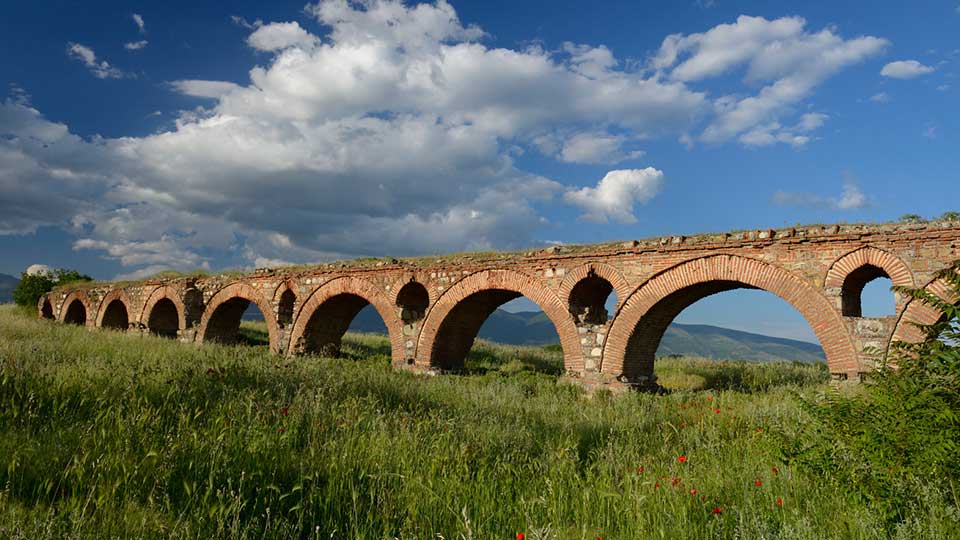
Katlanovo Spa
The spa is located about 25 km from Skopje, in the vicinity of Katlanovo, on the right bank of the Pchinja River, at 230 metres above sea level. There are many sources. The main source is with 15l/sec. The water temperature is around 50 C. According to the chemical composition, the waters are alkaline, earth alkaline and sulfur hyperthermal. They are suitable for the treatment of the liver and gall bladder system, the nasal system of metabolism, abdominal bowel tract, heart-blood disease, and the like. The spa complex is equipped with tourist-catering and health facilities, with features for combined tourism types: healing, recreational, sports, fishing, hunting.
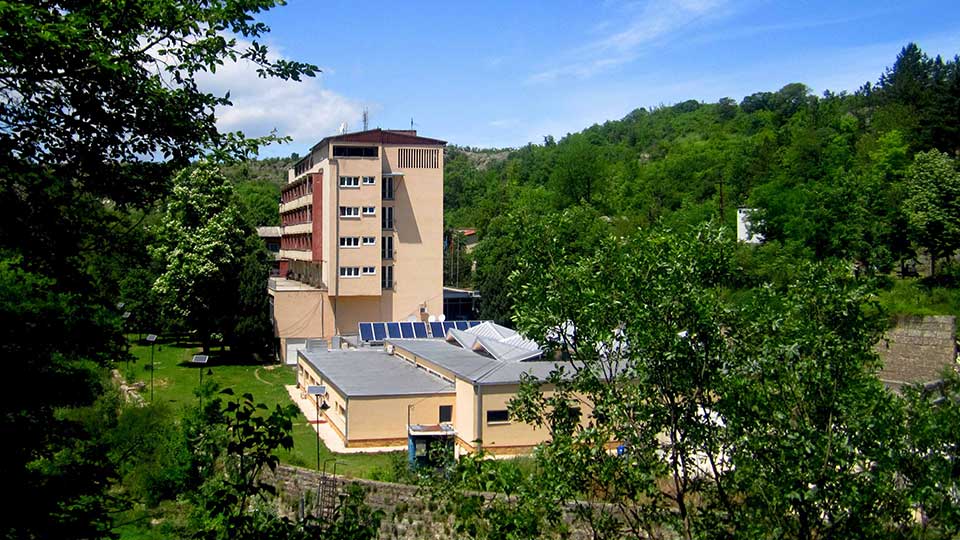
Marko’s monastery - St. Dimitrij, v. Sushica (14th century)
At about 20 km from Skopje, near Markova Reka in the vicinity of the village of Susica, there is Marko's monastery, named after the founders - King Vukashin and his son Marko. The data on the construction of the monastery church (1345) and the monastery's patrons are provided in the inscription of the south entrance, inside the church. The church is in the form of an inscribed cross, built of stone and brick. The frescoes are from the 14th century. These are rich illustrations from the Virgin Akathist, the miracles of Christ, the great feasts, and several individual figures of saints, angels, prophets, hermits and warriors. The most famous fresco of this monastery is the Lamentation of Rahil, where a heavy human drama presented through the killing of children in Bethlehem.
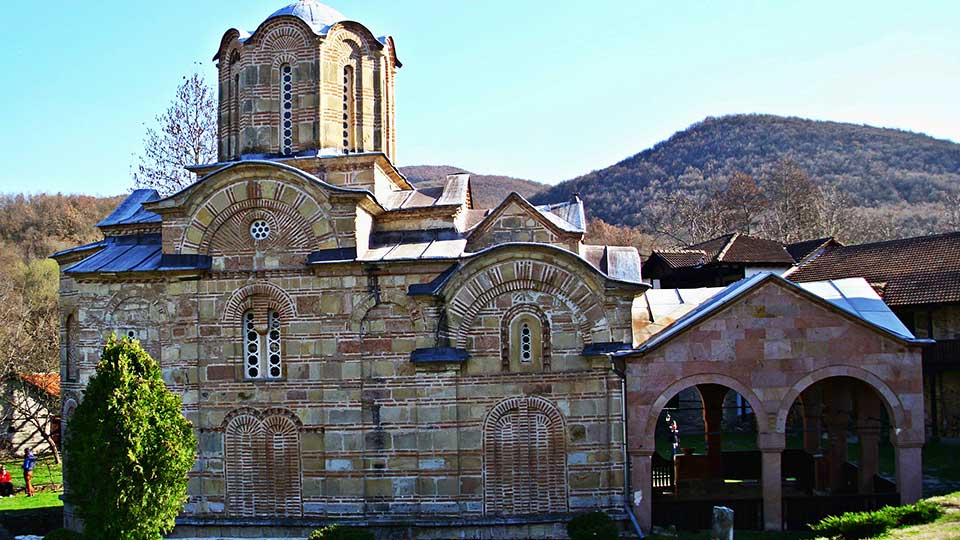
The monastery has a great church and cultural-historical treasure: icons, manuscripts and books, church objects and relics. An intense monastic life, copying and educational activity took place here. In the 19th century the abbot of the monastery was the Macedonian revivalist and writer Kiril Pejcinovic, who founded a school in the monastery, and here he also wrote his famous book Mirror.
Sports Centre Boris Trajkovski
The most complex sports facility in Macedonia. The larger hall has a capacity of 8,000 spectators for basketball competitions and 10,000 for concerts and other cultural events. It has a swimming pool, a hall for hockey, table tennis, a fitness room, a bowling alley, a sauna. The 2008 European Women Handball Championship was held here.
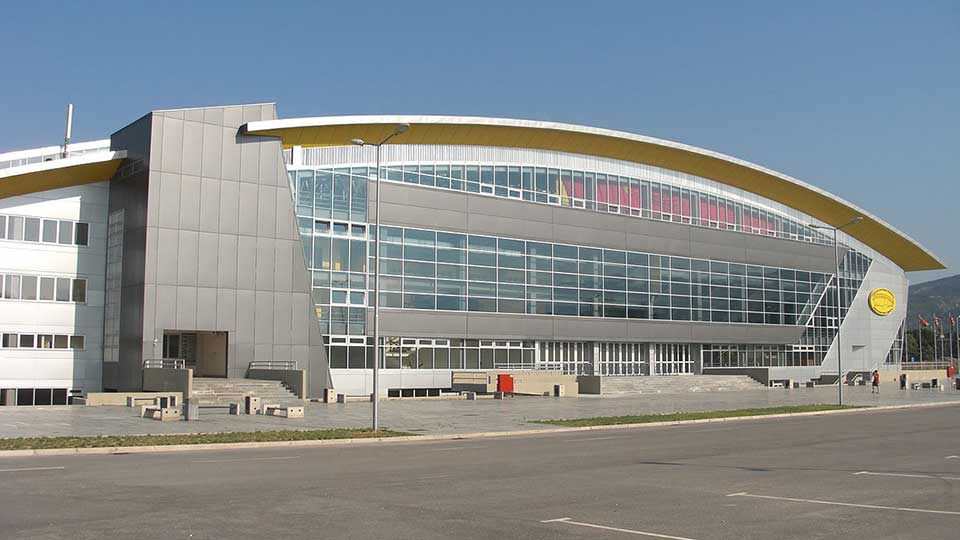
National Arena Philip II of Macedonia
A multi-purpose stadium, most commonly used for football competitions, with a maximum capacity of 36,400 spectators. It is used by the football clubs Rabotnicki and Vardar, as well as the football team of Macedonia. The construction of the City Stadium began in 1978 with the construction of the southern platform. In 2008, the old northern platform was demolished and a new one, according to the highest FIFA standards, was built. After the reconstruction of the south in 2011, the eastern and western platform were put into operation.
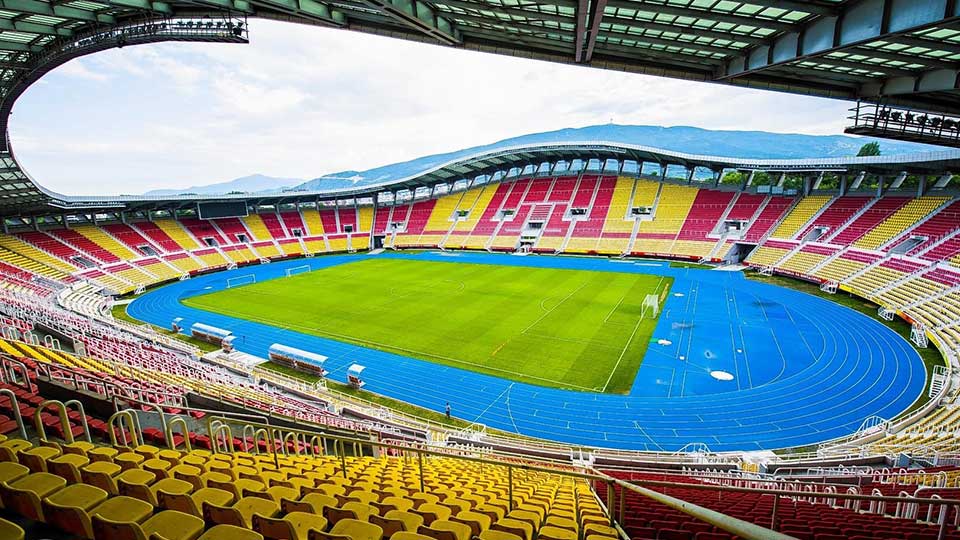
Manifestations
Skopsko Leto (21 June – 31 July, Skopje)
Since 1980, the conception of the manifestation includes music concerts, opera, ballet and drama performances, art and photo exhibitions, film programmes, performances and multimedia projects, as well as its own production and numerous visits from abroad. Open stages at the Skopje Fortress, the Old Bazaar, Kurshumli an, Vardar Quay, the City Park, the halls of the Skopje theatres and the art galleries pulsate at thirty different localities of Skopsko Leto.

Majski Operski Veceri (May Opera Evenings) 9 – 31 May, Skopje
With a tradition since 1972, the festival is one of the most visited events in Skopje. The stage of the Macedonian Opera and Ballet is a host of the programme, which consists of opera performances, but also ballet, concert and symphonic performances. Regular participants at the May Opera Evenings are opera and ballet artists from the neighbouring countries and the world, as well as the ensembles of the Macedonian Opera and Ballet.
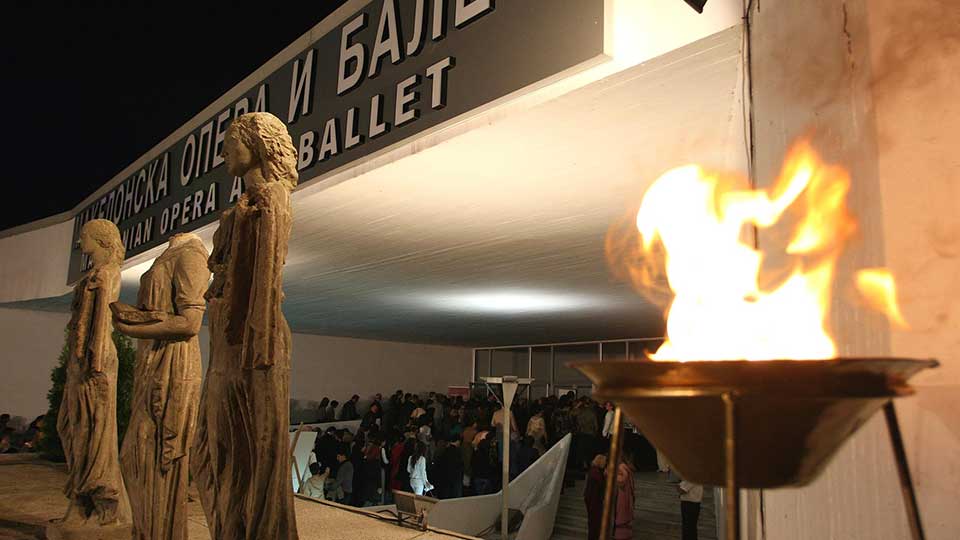
Baskerfest (May – June, Skopje)
International Street Artist Festival, held at several locations in Skopje. This is a free festival for the whole family, which does not charge tickets - the only price is a contribution put in the artists' hats. Spectacular carnival parade composed of numerous acrobats, clowns, comedians, stilt walkers, magicians, jugglers, breakers, puppeteers, caricaturists, pantomimists, national dancers, musicians, complemented by various masks, costumes and music.
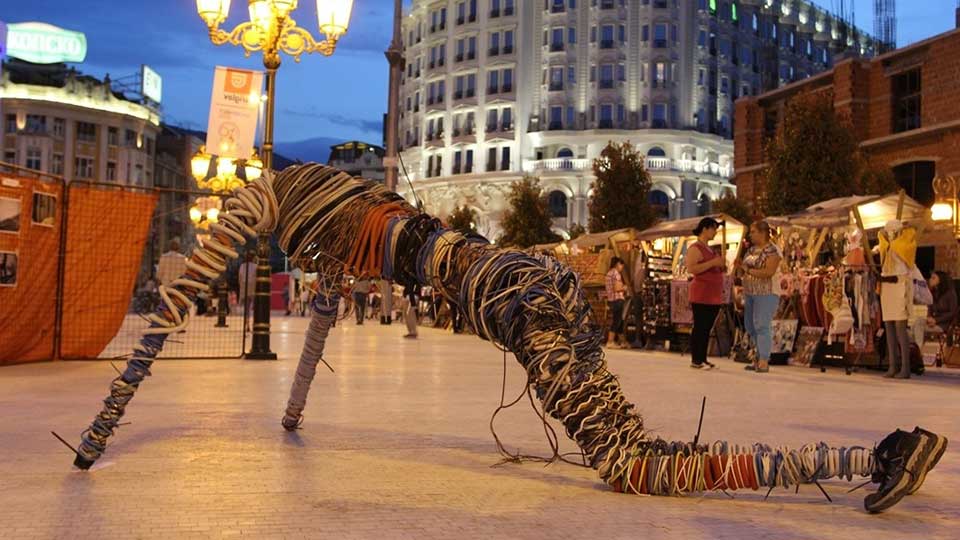
Pivolend in September
With about 300,000 visitors, the festival is the destination of quality entertainment and presentation of beer producers, accompanied by fantastic foods from local restaurants, animation of visitors with music.
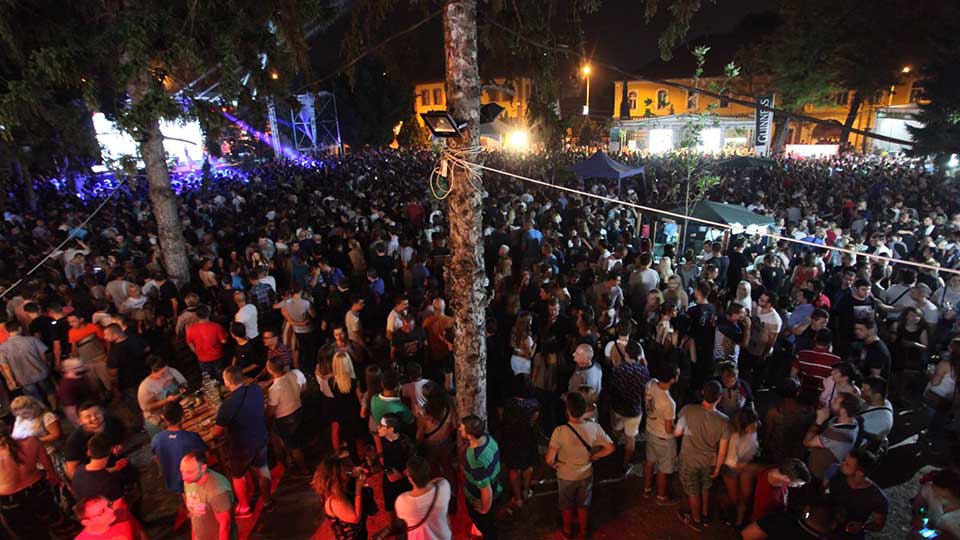
More information about Skopje can be found on this website.
Brajcino
The centuries-old village of Brajcino
You will never find out how crystal clear, fresh, and easy can be the air until you visit the centuries-old village of Brajcino. You are accommodated in the bosom of Mount Baba, at an altitude of 1000 meters, along the valley of the pure Brajcino River. The river covers the landscape of the village and divides it into two picturesque parts, which abound with rich flora and fauna. The forest and the shy diverse wildlife hidden in it are around you. Above you rise several mountain peaks, and from a distance you see the tranquil blueness of Prespa Lake. Due to the proximity to Lake Prespa, for lovers of water and birds, interesting destinations are the island Golem Grad and the ornithological reserve Ezerani, as well as Podmocani, where the museum with the most numerous collection of folk costumes is located.
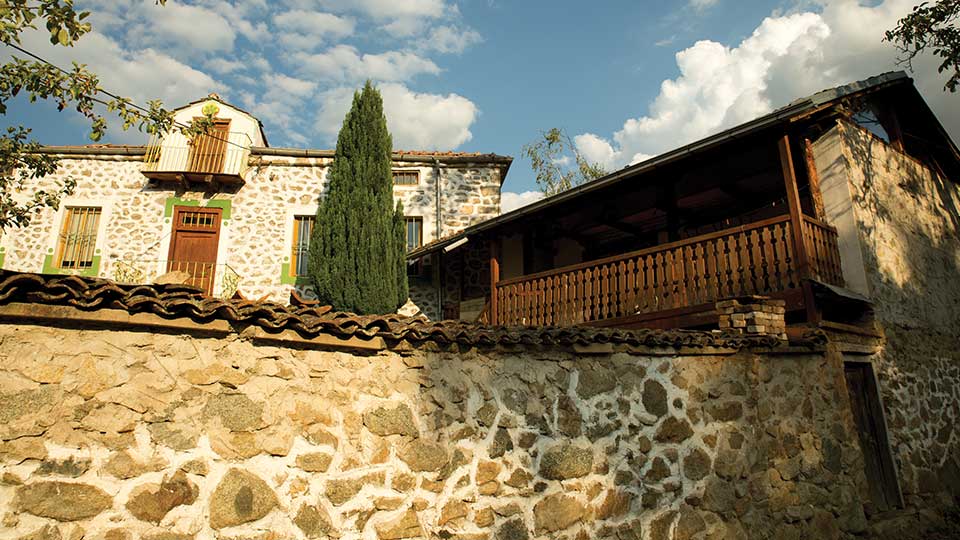
Mountain beauty in the village Brajcino which offers recreation
Breathe in and fill your chest with the tempting scent of forest fruits, get to know the beautiful surroundings through hiking, mountain and biking trails, and realize that you've come to a place where silence rests, as well. You feel the freedom that can only be understood by migratory birds that choose Brajcino each year as a station for rest and food. The village abounds with springs and rapid watercourses. In Brajcino River one of the oldest trout species is found, and the fir forest has the highest annual growth rate in Europe.
The mountain slopes around Brajcino are abundant with thick beech and oak forests, and from the village itself, starting from the width of the playground in front of the upper Maalo, there are several marked mountain paths. Through the thick beech, oak and walnut forest rich in springs, the paths lead to the peak Pelister (3 hours) and the Great Lake from the Pelister Eyes (6 hours); they continue to the mountaineering homes Neolica and Kopanki and the village Nizhepole in the Bitola region, which are marked with road sign boards and mountain marking.

The charm of traditional living in Brajcino
The old village houses are decorated with authentic architecture dating from the 19th century, but there are also many modern homes. Many people can say that Brajcino is an urban village with regard to the style of living and the appearance of the buildings. It is not surprising, since at the beginning of the 20th century there were balls in this village and in the surrounding area. At the end of the long walk, it is inevitable that you taste the irresistibly delicious marmalade, confiture or stewed fruit, prepared by the inhabitants of the village Brajcino, who are top masters of the culinary arts, and you can warm your soul with a few sips of the unique forest fruit liqueur. Be sure to take a walk to the monastery St. Petka and the five churches in the village - St. Nikola, H. Mother of God, St. Ilija, St. Arangel and St. Atanas. Brajcino is officially listed among the tourist destinations that foster ecological tourism.
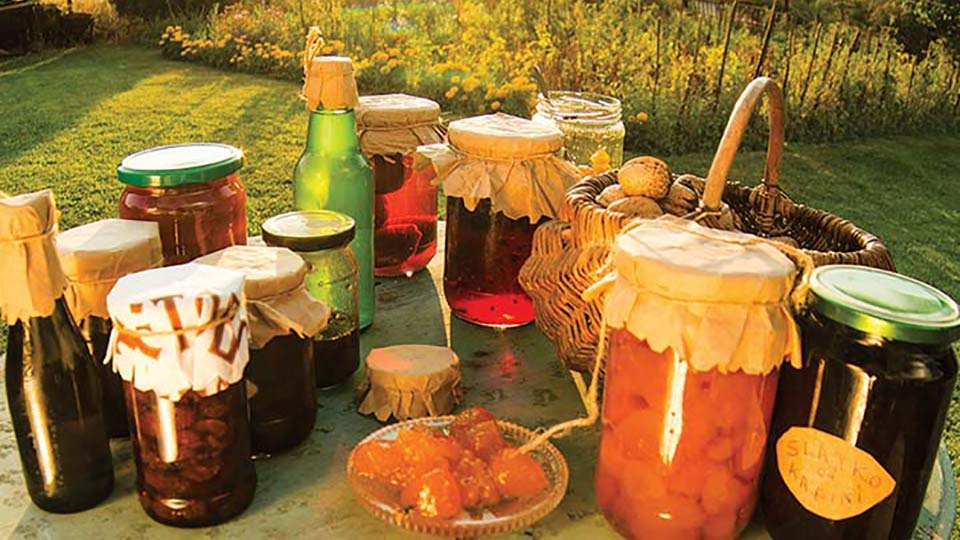
More information about Brajcino can be found on this website.
Galicnik
"If Macedonia is a biblical country, then Galichnik is its last relic!" - Petre M. Andreevski
Galichnik is a tourist attraction because of its authentic architecture, rich cultural heritage and admirable landscapes, and is one of the most beautiful mountain villages, famous for its rich pastures, beautiful yellow cheese and white cheese, as well as for its outstanding constructors and builders.

It is located about 10 km to the Mavrovo Lake and the ski center Zare Lazareski. It lies on the slopes of Bistra, in the heart of the Miyak district. The interesting location of Galichnik, at an altitude of about 1400 meters, is complemented by the authentic appearance of the houses. The building skill of the inhabitants from this region is also known in European metropolises, where the masters proved their craft. The village archetypation in Galichnik is preserved, the old stone houses are restored, and new buildings are built in the spirit of tradition. The houses consist of two and three storey heights, and their present appearance dates back to the late 19th and early 20th centuries.
Historically, the oldest information about Galichnik dates back to the 10th century. It is thought that it was formerly a settlement made by cattle-breeders. It was precisely the livestock production that was the main activity in the village. However, today Galichnik is filled with people only during the summer days, when displaced inhabitants return to avoid summer heat. In July the traditional Galicnik wedding is held. The Galichnik Wedding is held every year on Petrovden (the second week of July). Today, the wedding has a great cultural significance and is a kind of traditional cultural manifestation.
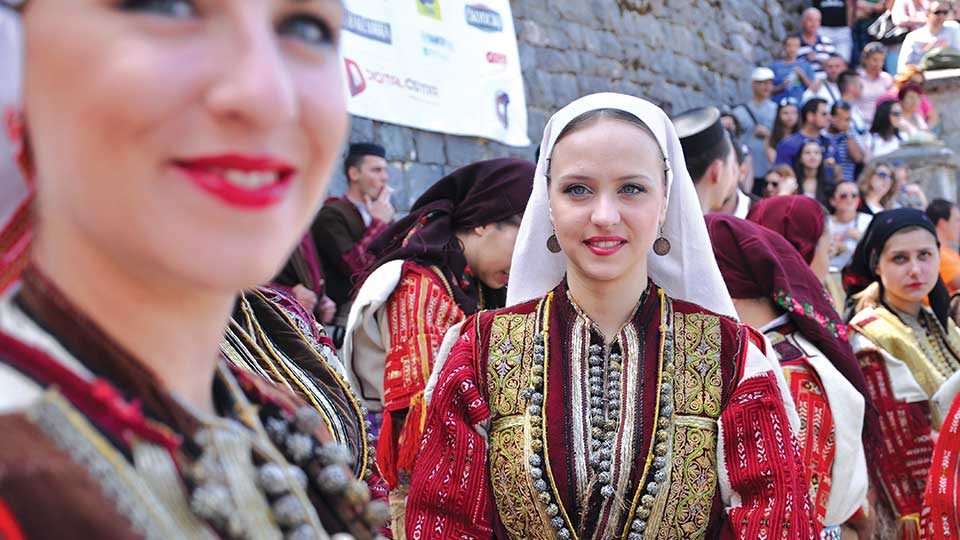
Galicnik folk costume
The Galicnik folk costume, especially the female Galicnik costume, is one of the most famous in Macedonia. It features an unusual wealth of detail. It is extremely similar to other Miyak costumes from the Reka region (Lazaropole, Tresonce, Susica, Gari, etc.). In the female folk costume the white (yellowish) and red prevail. White fabric clothes, decorated with black cords, are the main features of the male costume. This is conditioned by the climate and economic conditions in which they lived (live), as cattle-breeders in the mountainous regions of Mount Bistra, Stogovo, Krchin and Korab.
More information about Galicnik can be found on this website.
Krklino
Krklino for fans of riding sports
In the western part of Pelagonia, 5 km from Bitola, is the village of Krklino. In the east there is a flat plateau, and the Oblakovska Mountain rises to the west of the village. According to one legend, the name of Krklino comes from the beautiful girl Ilina, who in the surrounding villages was known under the name Krklina. In the village of Krklino, there is a church dedicated to St. Todor, the church Holy Mother of God, and especially interesting is the monastery St. Ilija, situated on a hill next to the village. It is a favorite location for visiting by the locals, primarily because of the wonderful panoramas, which from this place open to Pelagonija and Pelister.
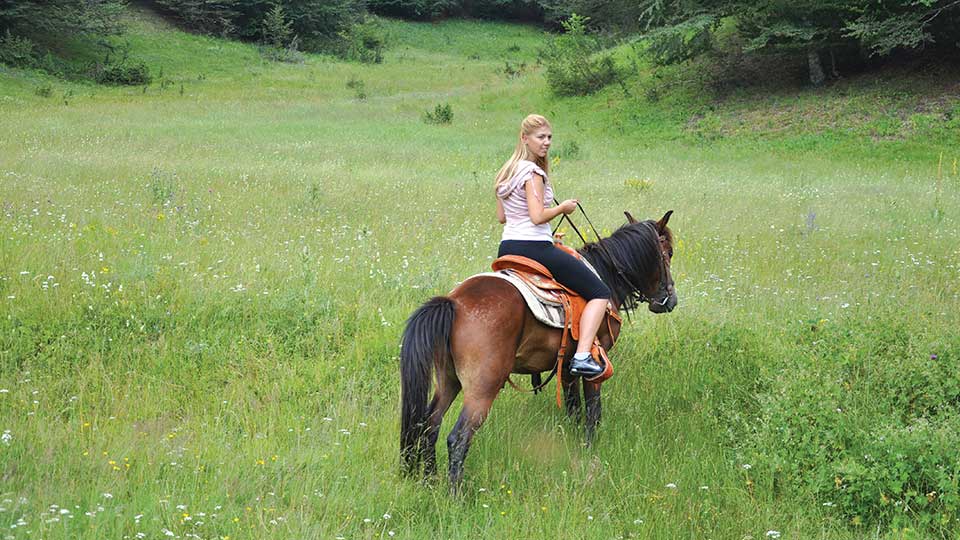
If you are a fan of riding sports, you can visit the Hippodrome in the village where there is a paddock of bred horses. This complex offers beautiful conditions for a true enjoyment of horse riding in nature.
The auto-ethno museum in Krklino
Krklino is the only village in Macedonia that owns a "motor show" - more precisely a collection of repaired vehicles and motorcycles. It is an auto-ethno museum in private ownership, which consists of two floors. In the first one there are several old-timers and several motorcycle models. The oldest car is Citroen since 1925. On the upper floor of the museum there are several rooms: village, city, Jewish room and antique shop. In every room you can see objects from the past, from the everyday utensils, to weapons, such as an Austrian short rifle, swords or knives, but also musical instruments, including organs over 200 years old, as well as Bitola folk costumes.
The auto-ethno museum is a unique place with a rare treasure in a traditional rural setting - an unusual contrast that you must feel. In the village there is an archaeological site called Krklino. The site is a lone iron-time finding. In 1957 a bronze sword of the type "Erbbenhein" was purchased, which originated from a site in the area of the village.
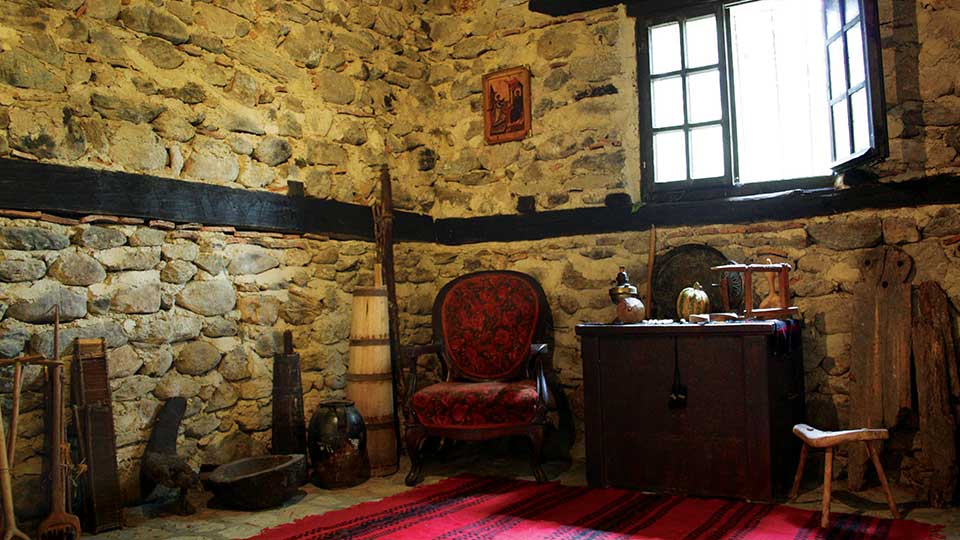
More information about Krklino can be found on this website.
Manastir and Vitolista
Mariovo one of the most picturesque areas in Macedonia
Mariovo is a historically, culturally and naturally rich region. It is one of the most picturesque areas in Macedonia. Rural region with incredible landscapes of priceless natural beauty. The most famous is the Mariovo (female) costume, which is among the colorfully richest Macedonian folk costumes. Interesting is the fact that the bride’s Mariovo costume weighs 48 kilograms! Mariovo as an area abounds with folk arts especially with folk songs, myths, legends and tales. A great number of them are recorded in the books of Marko Cepenkov. Mariovo is also a tourist attraction, which attracts with the great abundance of myths in which it is described. Mariovo is an area that is famous for folk tales. According to folk tales allegedly in Mariovo lived Itar Pejo, a great wise man. It is the work of the Macedonian writer Marko Cepenkov.
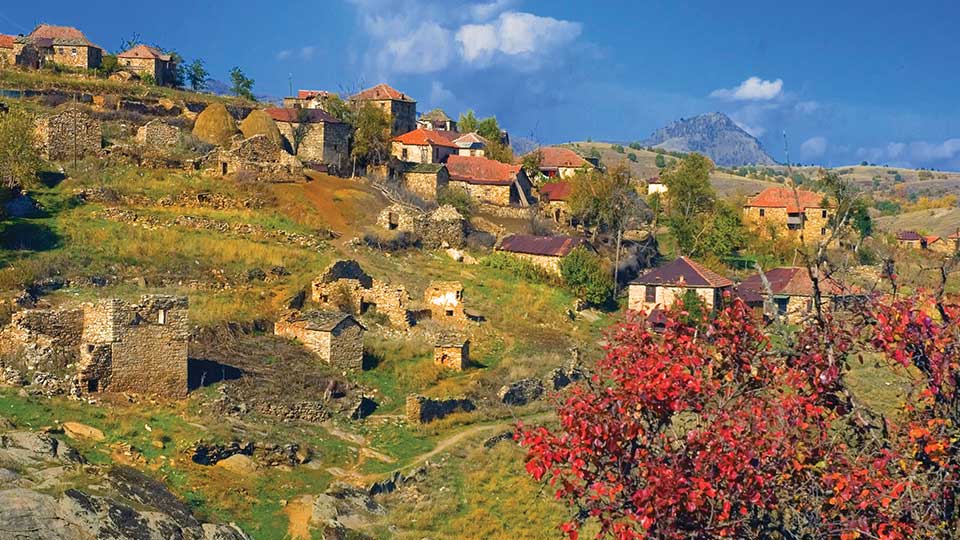
Manastir and Vitolista
The village of Vitolista is located at a distance of 46 km from the city of Prilep. It is at a height of 830 meters. This village was described by one of the most famous Macedonian writers, Stale Popov, who was born in this village. Vitolista is located on the mountain Kozjak. It is distinguished by numerous cultural and historical monuments, churches and monasteries rich in frescoes and rich cultural tradition. The church "St. Ilija" within the monastery church of the Vitolishte Monastery, built in 1872, is characterized by an extremely rich fresco painting created by the famous painter Avram Dichov, the son of Dicho Zograf. The village is recognizable even after the famous Mariovo beaten and white cheese.
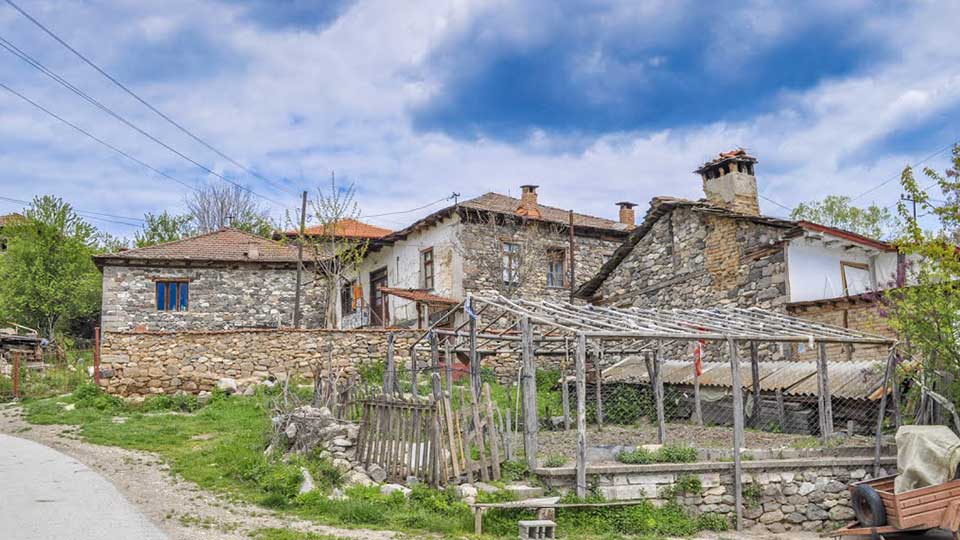
Manastir is located in the central part of Mariovo, along the valley on the right side of Crna Reka. The village is hilly and is located at an altitude of 690 meters. Most of the area belongs to the pastures, and there are almost no forests. Near the picturesque canyons of Crna Reka, there is the monastery "St. Nikola ", dating back to the end of the 11th century. The Mariovo Rural Region is one of the most specific in the country - it deserves that you see why it is the case.

More information about Manastir and Vitolista in Mariovo can be found on this website.
Ethno city festival
The "Krushevo ethno city" festival is one of Macedonia's prime tourist attractions. It is held every summer in July-August, in celebration of the traditions and customs of Krushevo. The "Krushevo ethno city" festival held for 10 days every summer is great way to preserve many old customs and traditions by the natives of Krushevo.
In the middle of the summer, this unique event includes hundreds of participants dressed in traditional costumes as insurgents and Ottomans, parading around Krushevo, in commemoration of the anniversary of the Ilinden uprising that took place on 2nd of August, 1903. Apart from the main procession, there's also other events happening at the same time during this unique festival, such as art exhibitions, concerts and other cultural and sport performances.
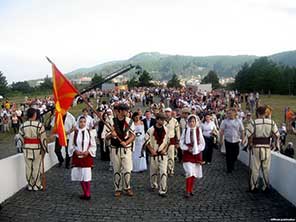
Ethno city festival
The "Krushevo ethno city" festival is one of Macedonia's prime tourist attractions. It is held every summer in July-August, in celebration of the traditions and customs of Krushevo. The "Krushevo ethno city" festival held for 10 days every summer is great way to preserve many old customs and traditions by the natives of Krushevo.
In the middle of the summer, this unique event includes hundreds of participants dressed in traditional costumes as insurgents and Ottomans, parading around Krushevo, in commemoration of the anniversary of the Ilinden uprising that took place on 2nd of August, 1903. Apart from the main procession, there's also other events happening at the same time during this unique festival, such as art exhibitions, concerts and other cultural and sport performances.

Memorial house of Petar Pop Arsov
Permanent Еthnological Exhibition in the Memorial House of Petar Pop Arsov - Municipality of Caska
A memorial house in the village of Bogomila is the birthplace of the Macedonian revolutionary Petar Pop Arsov, one of the founders of the Macedonian Revolutionary Organization. The house was donated to the Republic of Macedonia by Stamen Pop-Arsov. In 1986 the house was declared a cultural heritage of Macedonia. Over several decades, this memorial house has been visited by thousands of visitors.
This ethnological display is composed of ethnological objects that represent the material and spiritual culture of the population from the Azot area, Chaska Municipality. The objects are made of wood, ceramics, textiles, glass, metal.
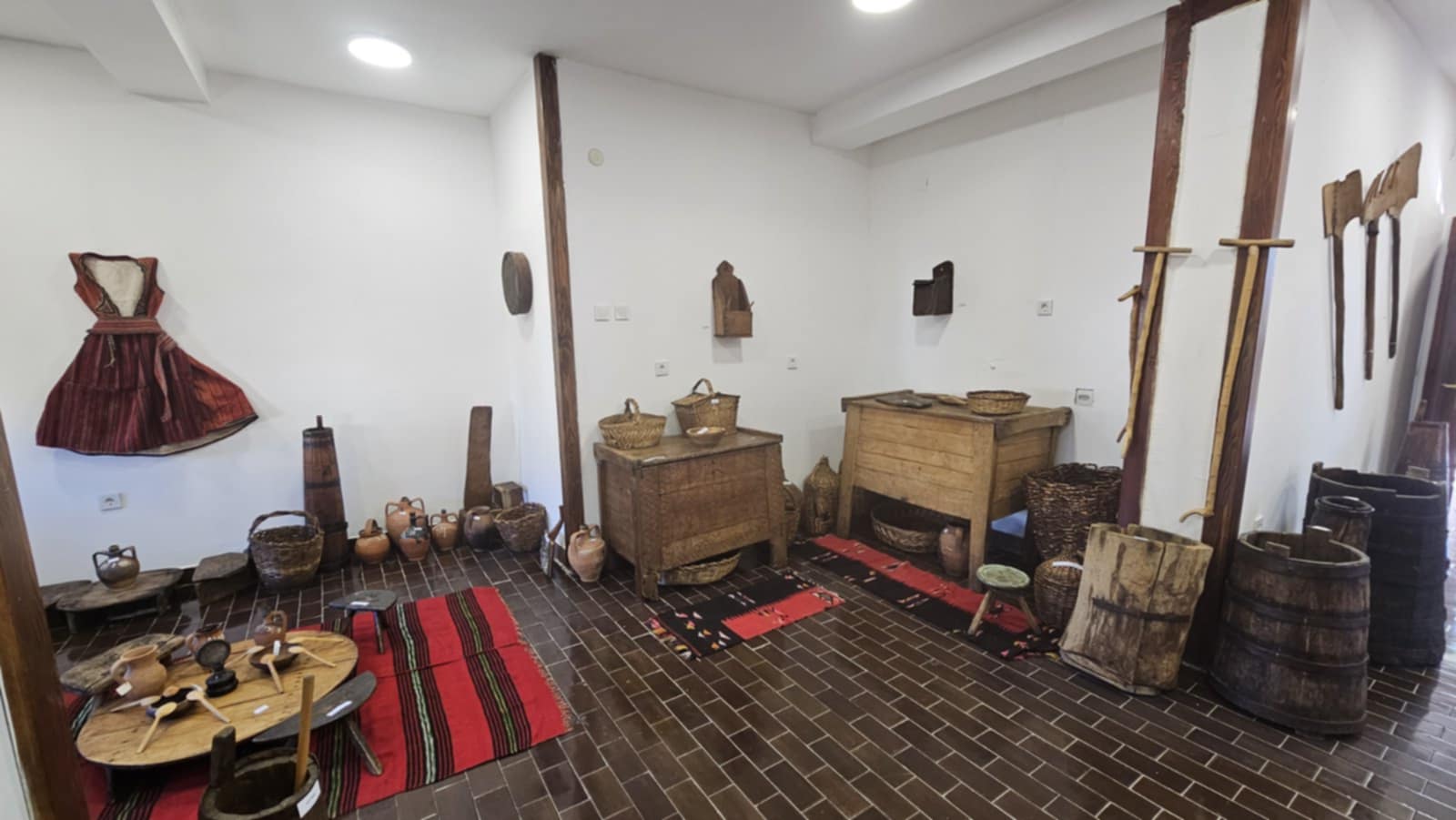
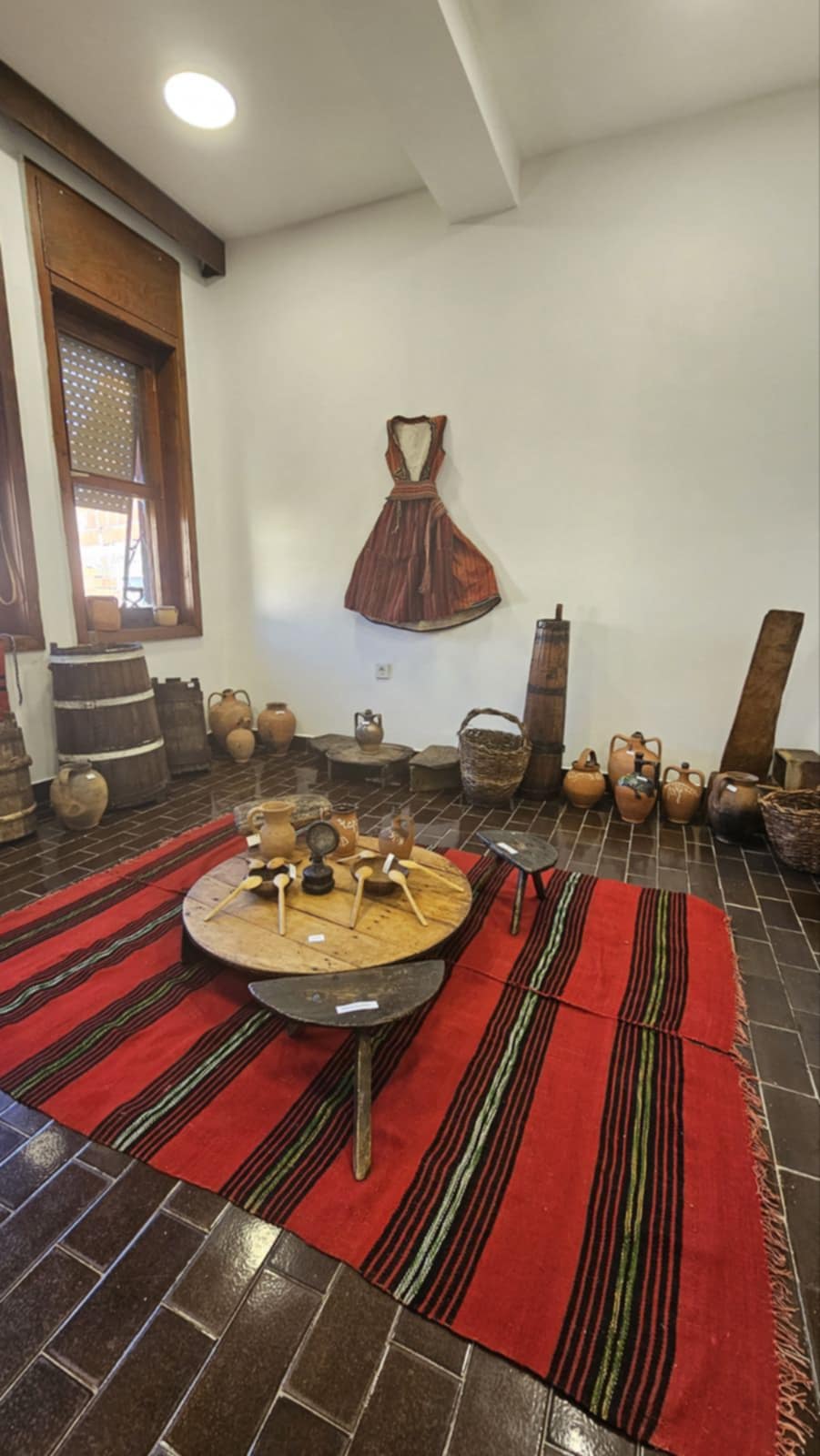
On display are traditional metal, wooden, textile and ceramic household items that were used in the household, such as cauldrons, jugs, pitchers, mudguards, pots, troughs, coffins, looms, etc. Traditional wooden and metal objects and tools that were used in the folk economy such as plow, plow, yoke, drill, pitchfork, sickle, basket, etc. Traditional textile items such as folk costume, bovchi (skutina), carpets, etc. All these ethnological items are one of the most representative items from the Azot region, through which the ethnic situation of the population is shown.
This ethnological exhibition was made in order to present the fund of ethnological objects to the wider domestic and international public, and also for the visitors to get acquainted with the traditional way of living of the population of the Azot region, through the objects that were used to perform various customs. , traditions and rituals that are the hallmark of Azot.
mac+1 day Macedonian Evening tour
Macedonia has five significant features that make it known to tourists – long history, beautiful nature, hospitality, food/drinks and folklore. The purpose of this program is to introduce the guests to the traditions of the Macedonian population, particularly from the perspective of gastronomy, old dances and music. In a wonderful ambiance, surrounded by nature, entertained by the ensemble members, you will have a unique opportunity to learn some basics of the dance, known by every citizen of this small country. Above all, the Macedonian evening will offer you an opportunity to taste the delicious specialties of the old cuisine.

Macedonia is the land of peppers – with approximately 2,000 recipes including peppers, beans, cabbage, water melon, grapes, cherries and apples. Macedonia is proud to have the best eggplant in the world and the purest, ecological yellow cheese. In addition, Macedonia has a renowned wine region, which provides the guests with an opportunity to taste various sorts of wine and rakija (grape brandy). The guests will also be able to enjoy in and learn about instruments typically played in this region – zurla, drum, bagpipe, accordion, violin, flute, tambourine. Members of the folk dances ensemble, dressedin traditional costumes will perform dances to the well-known Macedonian measure 7/8, 9/8, 11/8, 13/8. At the end, the dancers will offer assistance to every guest to take the opportunity and learn the oro – Macedonian dance, or the so called crab walk (three steps forward, one backward).
Tour Organizes by:
Tel: +389 46 250 745
E-mail: [email protected]
mac+1 day Macedonian Evening tour
Macedonia has five significant features that make it known to tourists – long history, beautiful nature, hospitality, food/drinks and folklore. The purpose of this program is to introduce the guests to the traditions of the Macedonian population, particularly from the perspective of gastronomy, old dances and music. In a wonderful ambiance, surrounded by nature, entertained by the ensemble members, you will have a unique opportunity to learn some basics of the dance, known by every citizen of this small country. Above all, the Macedonian evening will offer you an opportunity to taste the delicious specialties of the old cuisine.

Macedonia is the land of peppers – with approximately 2,000 recipes including peppers, beans, cabbage, water melon, grapes, cherries and apples. Macedonia is proud to have the best eggplant in the world and the purest, ecological yellow cheese. In addition, Macedonia has a renowned wine region, which provides the guests with an opportunity to taste various sorts of wine and rakija (grape brandy). The guests will also be able to enjoy in and learn about instruments typically played in this region – zurla, drum, bagpipe, accordion, violin, flute, tambourine. Members of the folk dances ensemble, dressedin traditional costumes will perform dances to the well-known Macedonian measure 7/8, 9/8, 11/8, 13/8. At the end, the dancers will offer assistance to every guest to take the opportunity and learn the oro – Macedonian dance, or the so called crab walk (three steps forward, one backward).
Tour Organizes by:
Tel: +389 46 250 745
E-mail: [email protected]
mac+1day Macedonian Evening tour
Macedonia has five significant features that make it known to tourists – long history, beautiful nature, hospitality, food/drinks and folklore. The purpose of this program is to introduce the guests to the traditions of the Macedonian population, particularly from the perspective of gastronomy, old dances and music. In a wonderful ambiance, surrounded by nature, entertained by the ensemble members, you will have a unique opportunity to learn some basics of the dance, known by every citizen of this small country. Above all, the Macedonian evening will offer you an opportunity to taste the delicious specialties of the old cuisine.

Macedonia is the land of peppers – with approximately 2,000 recipes including peppers, beans, cabbage, water melon, grapes, cherries and apples. Macedonia is proud to have the best eggplant in the world and the purest, ecological yellow cheese. In addition, Macedonia has a renowned wine region, which provides the guests with an opportunity to taste various sorts of wine and rakija (grape brandy). The guests will also be able to enjoy in and learn about instruments typically played in this region – zurla, drum, bagpipe, accordion, violin, flute, tambourine. Members of the folk dances ensemble, dressedin traditional costumes will perform dances to the well-known Macedonian measure 7/8, 9/8, 11/8, 13/8. At the end, the dancers will offer assistance to every guest to take the opportunity and learn the oro – Macedonian dance, or the so called crab walk (three steps forward, one backward).
Tour Organizes by:
Tel: +389 46 250 745
E-mail: [email protected]
mac+1 day Bitola - The city of Consuls tour
The old name of Bitola is Monastir – a place to stay overnight. This is a city of long history, witnesses of which are the remains of Heraclea Lyncestis situated on the ancient Roman road Via Egnatia. Over the centuries, it has always been an important commercial center. During the Ottoman Empire era this city becomes an important administrative and diplomatic center with quite a few European consuls. Bitola reached its peak of prosperity in the 19 century, and today it is an important city of about 100,000 population, situated in the southwest of Macedonia.
Departure from the hotel after breakfast (you will be notified about the exact time by our agent/host and it will also be posted on our info-board). Full day excursion.
Program
The road to Bitola will take us through the villages of Leskoec, Kosel through the city of Resen, along the way we are going to have break for coffee and refreshments. When we arrive in Bitola, first we are going to visit the ancient city of Heraclea built by the Macedonian Emperor Philip II, father of Alexander the Great. This is a special opportunity to see one of the mosaics in this part of the world, as well as the ancient theater, many Roman statues, Early Christian basilicas etc.

Then we go to the center of Bitola where we are going to see the archaeological finds at the National Museum, where a separate room is dedicated to Mustafa Kemal Ataturk – 1881 - 1938, father of modern Turkey. His family was of Macedonian origin. Lunch will be served at a traditional Macedonian restaurant and will take about an hour. We then continue through the center of Bitola, along the celebrated Shirok Sokak (Broad Alley), which will bring us back in time, when the city was part of the Ottoman Empire. Many building will rightfully capture our attention, such as the old Turkish Shopping Street, Isak Pasha Mosque, Yeni (New) Mosque and the Clock Tower, the church of St. Dimitrija, the Catholic Church. We depart from Bitola and head towards Lake Prespa. The asphalt road will take us through sensational nature, to the village of Podmocani, where you will be able to visit the Ethnological Museum that has 120 types of folk costumes in its possession.

Following the visit to the Museum, we set off for the village of Stenje where we will have an opportunity to take a few photos and see the place where pelicans nest. After the short break, we continue towards the top of Mount Galicica, from where you can admire the Lake Prespa and the surrounding magnificent nature. We are going to take a short break for photography and then we cross the highest point on our road and the wonderful view of Lake Ohrid and its surroundings opens out broadly in front of us.
We are stopping briefly at the highest road bend where you have a view of Lake Ohrid – something that will leave you speechless, then the National Park Galicica and Lake Prespa – an ecological lake shared by three countries. We return to the hotel once the program is completed.
Tour Organized by:
Tel: +389 46 250 745
E-mail: [email protected]
srb+1 day Macedonian Evening tour
Macedonia has five significant features that make it known to tourists – long history, beautiful nature, hospitality, food/drinks and folklore. The purpose of this program is to introduce the guests to the traditions of the Macedonian population, particularly from the perspective of gastronomy, old dances and music. In a wonderful ambiance, surrounded by nature, entertained by the ensemble members, you will have a unique opportunity to learn some basics of the dance, known by every citizen of this small country. Above all, the Macedonian evening will offer you an opportunity to taste the delicious specialties of the old cuisine.

Macedonia is the land of peppers – with approximately 2,000 recipes including peppers, beans, cabbage, water melon, grapes, cherries and apples. Macedonia is proud to have the best eggplant in the world and the purest, ecological yellow cheese. In addition, Macedonia has a renowned wine region, which provides the guests with an opportunity to taste various sorts of wine and rakija (grape brandy). The guests will also be able to enjoy in and learn about instruments typically played in this region – zurla, drum, bagpipe, accordion, violin, flute, tambourine. Members of the folk dances ensemble, dressedin traditional costumes will perform dances to the well-known Macedonian measure 7/8, 9/8, 11/8, 13/8. At the end, the dancers will offer assistance to every guest to take the opportunity and learn the oro – Macedonian dance, or the so called crab walk (three steps forward, one backward).
Tour Organizes by:
Tel: +389 46 250 745
E-mail: [email protected]
srb+1 day Macedonian Evening tour
Macedonia has five significant features that make it known to tourists – long history, beautiful nature, hospitality, food/drinks and folklore. The purpose of this program is to introduce the guests to the traditions of the Macedonian population, particularly from the perspective of gastronomy, old dances and music. In a wonderful ambiance, surrounded by nature, entertained by the ensemble members, you will have a unique opportunity to learn some basics of the dance, known by every citizen of this small country. Above all, the Macedonian evening will offer you an opportunity to taste the delicious specialties of the old cuisine.

Macedonia is the land of peppers – with approximately 2,000 recipes including peppers, beans, cabbage, water melon, grapes, cherries and apples. Macedonia is proud to have the best eggplant in the world and the purest, ecological yellow cheese. In addition, Macedonia has a renowned wine region, which provides the guests with an opportunity to taste various sorts of wine and rakija (grape brandy). The guests will also be able to enjoy in and learn about instruments typically played in this region – zurla, drum, bagpipe, accordion, violin, flute, tambourine. Members of the folk dances ensemble, dressedin traditional costumes will perform dances to the well-known Macedonian measure 7/8, 9/8, 11/8, 13/8. At the end, the dancers will offer assistance to every guest to take the opportunity and learn the oro – Macedonian dance, or the so called crab walk (three steps forward, one backward).
Tour Organizes by:
Tel: +389 46 250 745
E-mail: [email protected]
srb+1day Macedonian Evening tour
Macedonia has five significant features that make it known to tourists – long history, beautiful nature, hospitality, food/drinks and folklore. The purpose of this program is to introduce the guests to the traditions of the Macedonian population, particularly from the perspective of gastronomy, old dances and music. In a wonderful ambiance, surrounded by nature, entertained by the ensemble members, you will have a unique opportunity to learn some basics of the dance, known by every citizen of this small country. Above all, the Macedonian evening will offer you an opportunity to taste the delicious specialties of the old cuisine.

Macedonia is the land of peppers – with approximately 2,000 recipes including peppers, beans, cabbage, water melon, grapes, cherries and apples. Macedonia is proud to have the best eggplant in the world and the purest, ecological yellow cheese. In addition, Macedonia has a renowned wine region, which provides the guests with an opportunity to taste various sorts of wine and rakija (grape brandy). The guests will also be able to enjoy in and learn about instruments typically played in this region – zurla, drum, bagpipe, accordion, violin, flute, tambourine. Members of the folk dances ensemble, dressedin traditional costumes will perform dances to the well-known Macedonian measure 7/8, 9/8, 11/8, 13/8. At the end, the dancers will offer assistance to every guest to take the opportunity and learn the oro – Macedonian dance, or the so called crab walk (three steps forward, one backward).
Tour Organizes by:
Tel: +389 46 250 745
E-mail: [email protected]
srb+1 day Bitola - The city of Consuls tour
The old name of Bitola is Monastir – a place to stay overnight. This is a city of long history, witnesses of which are the remains of Heraclea Lyncestis situated on the ancient Roman road Via Egnatia. Over the centuries, it has always been an important commercial center. During the Ottoman Empire era this city becomes an important administrative and diplomatic center with quite a few European consuls. Bitola reached its peak of prosperity in the 19 century, and today it is an important city of about 100,000 population, situated in the southwest of Macedonia.
Departure from the hotel after breakfast (you will be notified about the exact time by our agent/host and it will also be posted on our info-board). Full day excursion.
Program
The road to Bitola will take us through the villages of Leskoec, Kosel through the city of Resen, along the way we are going to have break for coffee and refreshments. When we arrive in Bitola, first we are going to visit the ancient city of Heraclea built by the Macedonian Emperor Philip II, father of Alexander the Great. This is a special opportunity to see one of the mosaics in this part of the world, as well as the ancient theater, many Roman statues, Early Christian basilicas etc.

Then we go to the center of Bitola where we are going to see the archaeological finds at the National Museum, where a separate room is dedicated to Mustafa Kemal Ataturk – 1881 - 1938, father of modern Turkey. His family was of Macedonian origin. Lunch will be served at a traditional Macedonian restaurant and will take about an hour. We then continue through the center of Bitola, along the celebrated Shirok Sokak (Broad Alley), which will bring us back in time, when the city was part of the Ottoman Empire. Many building will rightfully capture our attention, such as the old Turkish Shopping Street, Isak Pasha Mosque, Yeni (New) Mosque and the Clock Tower, the church of St. Dimitrija, the Catholic Church. We depart from Bitola and head towards Lake Prespa. The asphalt road will take us through sensational nature, to the village of Podmocani, where you will be able to visit the Ethnological Museum that has 120 types of folk costumes in its possession.

Following the visit to the Museum, we set off for the village of Stenje where we will have an opportunity to take a few photos and see the place where pelicans nest. After the short break, we continue towards the top of Mount Galicica, from where you can admire the Lake Prespa and the surrounding magnificent nature. We are going to take a short break for photography and then we cross the highest point on our road and the wonderful view of Lake Ohrid and its surroundings opens out broadly in front of us.
We are stopping briefly at the highest road bend where you have a view of Lake Ohrid – something that will leave you speechless, then the National Park Galicica and Lake Prespa – an ecological lake shared by three countries. We return to the hotel once the program is completed.
Tour Organized by:
Tel: +389 46 250 745
E-mail: [email protected]
ger+Traditional Macedonian Clothes
Always closely linked to their native land, the Macedonian people have mostly lived through centuries of tradition transmitting it from one generation to another, and thus creating an unusually rare material and spiritual culture which bears some patriarchal characteristics. True folklore cannot be bought or sold, but has to be learned through toil, sweat, tears, and, sometimes, even blood. Contrary to some who abuse its name for self-serving interests, it is not mere entertainment to amuse the throngs or to pander to an audience.
Rather, it should, as with all true art, stimulate, educate, irritate, and, hopefully, lead all who are touched by it to a new level of insight. At the same time, by its nature folklore is also accessible, not merely to an artistic elite, but to all who pursue it with passion. It will take all of your concentration, creativity, and passionate effort to capture its essence, to add to its richness, and to transmit it undiluted to the next generation so that they, Macedonians and others may yet know its sublime beauty and glory.
Folk costumes
Particular attention Macedonian had paid to the design and decoration of their clothes, so that national costumes and jewellery are the most expressive and the most numerous examples of the traditional creativity of the Macedonians. The national costumes in Macedonia (created over a long period of time), preserved the traces of old cultural influences, and in their way of development fit the elements of old Balkan, Slav and Oriental culture. Above all the product of domestic textile manufacture, the Macedonian national costumes are characterized by richness and ornamentation. Western Macedonia, especially divided into smaller regional units with different ethnic characteristics is a real mosaic of various beautiful national costumes, where the women's costumes are of special interest.
Decorative Macedonian embroidery, characteristic in the forms, technically complex and of picturesque colours give special expression and distinction to the national costumes. The women's gowns are especially decorative, and are the main bearer of this kind of traditional artistic creation. Embroidery is not only an artistic expression and the essential element but the most characteristic of the costumes of different regions. All of that is an historic heritage that makes Macedonia proud.


Most of Macedonia's colorful folklore consists of folktales and aphorisms (witty sayings). The following are typical aphorisms: "Falsehoods have short legs" (lies are soon found out); and "Begin a task, but always have its conclusion in mind" (finish what you start.) (Link do natinal quotes).
Macedonian folklore music
The ethnic Macedonian traditional music, which can be rural or urban (starogradska muzika), includes: lyric songs, epic songs, labour songs, ritual songs, humorous songs, circle dance ("oro"), the old urban style called Čalgija (not to be confused with chalga) etc.
Popular traditional songs are: Kaleš bre Angjo, Slušam kaj šumat šumite, Biljana platno beleše, Dafino vino crveno, Narode Makedonski, Zemjo Makedonska and many others. Often referenced oro dances are Teškoto from the village of Galičnik, Kalajdžiskoto, Komitskoto (The Dance of the freedom fighters) and others. An internationally acclaimed professional folklore association is the award winning “Tanec”.
Like its people Macedonia’s musical instruments have mixed origins. Many were brought to this land with the various invaders passing through over the centuries, while others are home grown. Playing traditional instruments is seeing a small revival in fusion music and in the revival of ethnic festivities.

ger+Bigorski
The Monastery is widely known for its iconostasis, made by Petre Filipovski - Garkata from the village Gari together with his brother Marko Filipov, Makarij Frchkoski from Galichnik and Avram Dichov with his sons, in the period from 1829 to 1835.
The iconostasis of the monastery is made of tiny, deep engraving, and one of the most beautiful, together with that one in the Holy Salvation church in Skopje.
The engraved iconostasis is full with flora and fauna ornaments.
There are wonderful figures of biblical scenes, but also a richness of birds, grapes clusters, branches of vine etc. In the scene of Decapitation of Saint John the Baptist, a woman dances dressed in a traditional costume from Miyak region.
The woodcarvers had also engraved their own faces in the iconostasis in order to be remembered by the future generations.
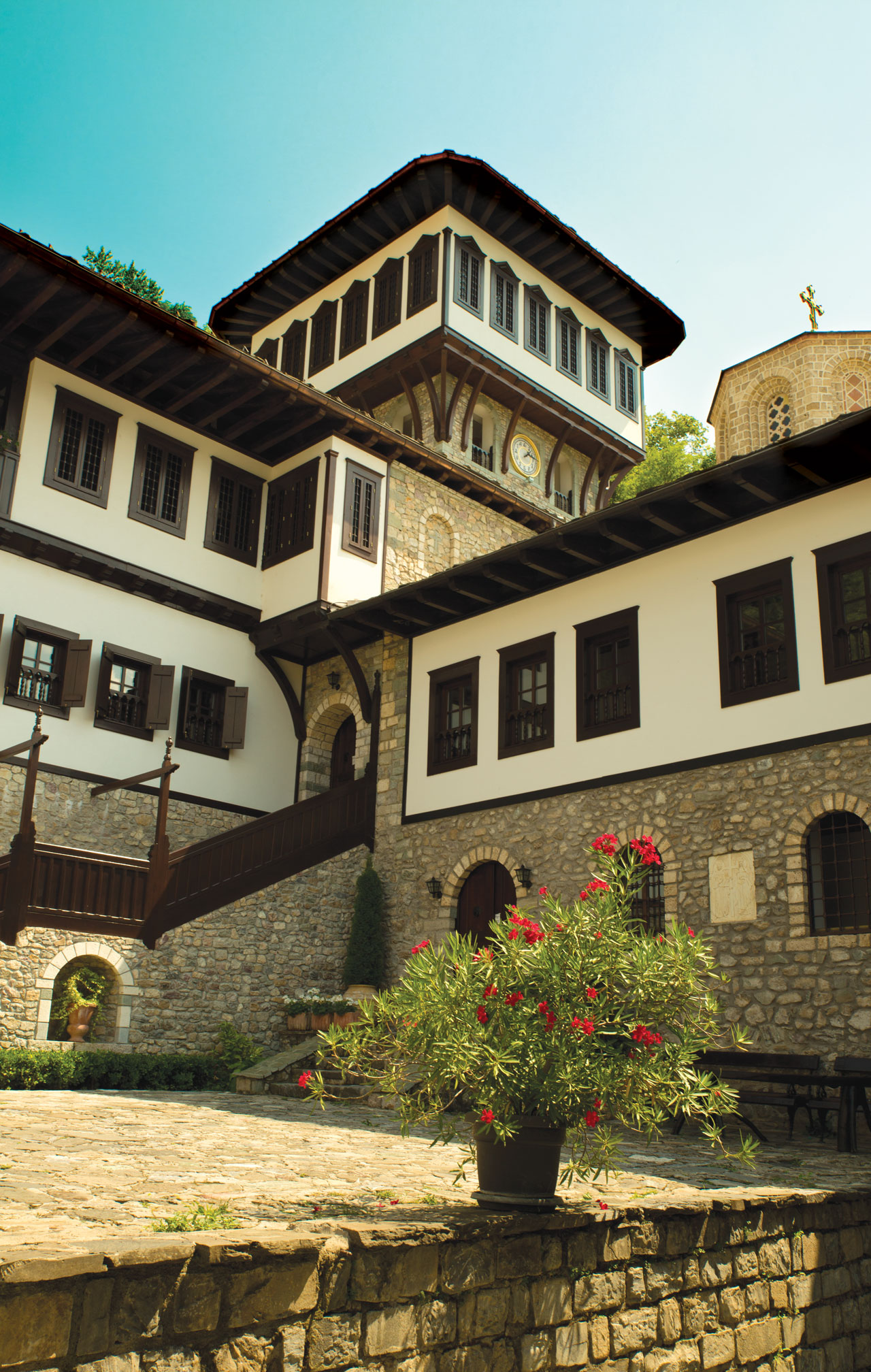
Saint Jovan (John) Bigorski Monastery (11th century) is on foundations of a basilica dating back to 1021, the monastery complex is built of travertine onto travertine rocks
The St. Jovan Bigorski Monastery is located by the road between Gostivar and Debar in the canyon of the River Radika, surrounded by the dense forests of Mountain Bistra.
The edifice is on foundations of a basilica dating back to 1021, and a testimony of it is the fresco-painting memorial book. The monastery was demolished by Ottoman Authorities in the 16th century, and only one little church was left from the entire complex. It was rebuilt in 1743, and it got its present look in the 19th century. The monastery complex is composed of a church, the charnel house, the defence tower, monks' quarters, and the newly built guest quarters. There is a bell tower built of travertine blocks as a part of the church complex. There is a Gallery of icons opened in the monastery complex, where around seventy icons dating back to the 17 th, 18th and 19th century are
displayed. There are remains of a church in the monastery, which dates back to the 16th century, i.e. 17th century and 18th century, and the big icons are preserved from it. Bigorski Monastery enchants with its beauty. Here is a fortune of frescoes, icons and a magnificent iconostasis with beautiful engraving, and other woodcut inventory: analogy (bookstands), pews, bishop's throne, amvon etc. The frescoes are work by the famous fresco-writer, Dicho Zoograf. Nowadays, the monastery is completely restored, besides the accidental fire in 2009 when the old quarters were burnt down completely as well as two dining rooms, a library and monks quarters. However, this monastery still pulsates spiritually due to numerous monk's brotherhood.
ger+Krklino
In the western part of Pelagonija, some 5 km from Bitola, is the village Krklino. Flatlands extend to the east, and Mt. Oblakovska rises to the west.
If you are a fan of equestrian sports, you can visit the Hippodrome in the village, where there is a paddock of racehorses. This resort offers beautiful conditions for the timeless pleasure of riding in nature.

Krklino is the only village in Macedonia that possesses an "Auto Salon" or a collection of repaired vehicles and engines. It is an Auto-Ethno Museum, which consists of two floors. On the first floor there are several old models, as well as a collection of motorcycles. The oldest car is a Citroën from 1925.
On the top floor of the museum there are rooms in various styles including rural, urban, and Jewish rooms and a shop offering antiques such as everyday household items, weapons including the Austrian short rifle, swords and knives, as well as musical instruments, like an organ that is over 200 years old, and folk costumes from Bitola.
The Auto-Ethno Museum is a rare treasure in a traditional rural setting – an unusual contrast that you must experience.
ger+Struga
Struga
The main characteristics of the tourism in the Municipality of Struga are: relatively favorable geographic positioning and relatively developed road infrastructure, mild continental climate with high level of sun insolation during the whole year, extraordinary fund of endemic species of flora and fauna, protected and preserved natural habitat, rich cultural and historic heritage with a considerable number of monuments and archeological sites, mountain ranges favorable for winter tourism, traditional welcome and folklore, healthy and traditional food consuming, unique cultural manifestations, Struga is situated in the southwestern part of the Republic of Macedonia, on the shorelines of the Lake Ohrid and alongside the banks of the River Black Drim that divides the city into two.
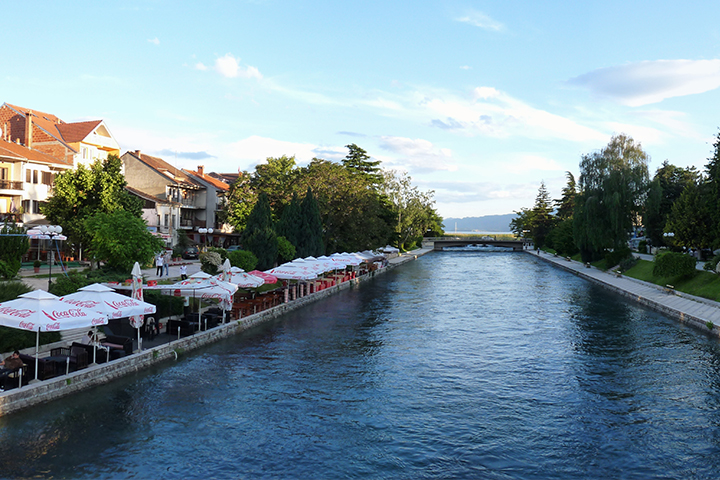
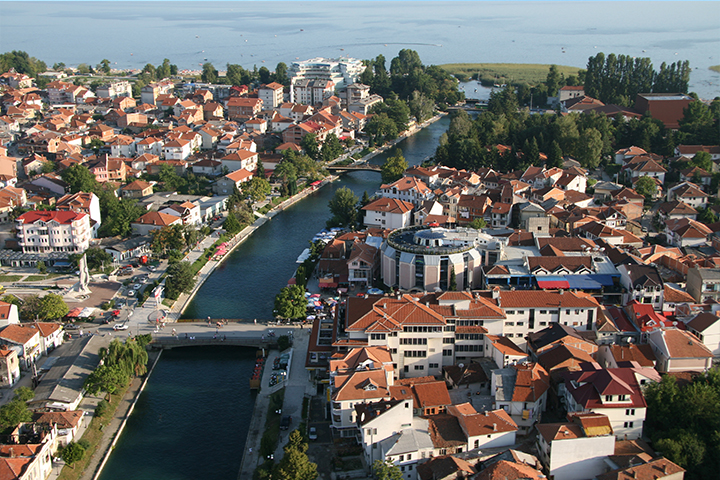
Struga is well linked and easily accessible with the neighboring regions: only 14 km away from the border with the Republic of Albania, 160 km with the Republic of Kosova (from Tetovo) or 190 km in the North (from Skopje), 100 km from the Republic of Greece, 290 km from the Republic of Bulgaria and 230 from the border with the Republic of Serbia. The International Airport only 9 km away connects Struga with the rest part of the world.
Struga has a surface of 573 km2and lies at 698 meters above sea level; there are 63376 inhabitants, 130 inhabitants/ km2, in 50 settlements. Maximum average temperatures reach 27 degrees centigrade in July and August, but in the warmest days of the summer they reach out to 35-40 degrees centigrade. Average temperature of the water of the lake Ohrid in summer is 26 degrees centigrade, while the temperature throughout the year reaches up to around 12 degrees centigrade. In the winter, average temperature is above 0 degrees centigrade, making thus a comfortable and pleasant environment to be accommodated and stay in this time of the season. The average days with relatively high temperatures reach to 80 days in the year, accompanied by intensively high temperatures in July and August. The insolation in Struga is very high, with 2,200 hours of insolation, Struga is one of brightest places in the Republic of Macedonia.
NATURAL RICHIES OF STRUGA
The Lake of Ohrid lies at an altitude of 695 meters above sea level and occupies an area of 348,2 km², from which 230 km² are on the side of the Republic of Macedonia and the rest of 118,2 km² belong to the Republic of Albania. The cost line of the lake is 87,5 km long. The average depth of the lake is 164 meters and the maximum depth of the lake is 289 meters, with a high transparency that reaches up to 24 meters. The Lake is characterized with a very unique ecosystem consisted of a rich world of flora and fauna that is very rare. The biodiversity of the lake and the trails of very old settlements and prehistoric civilizations that have existed here made possible for Lake Ohrid to be listed and constantly protected by the UNESCO as a cultural heritage of planetary proportions.
The River Black Drim is the only exit of the lake’s water. As it flows in the north, the river creates the two artificial lakes: Lake Globochitza and Lake Shpile. The eels found in the Lake Ohrid, through the river, pass seas and oceans on their “honeymoon” to arrive to the Sargasso Sea, where they meet their partners and breed.
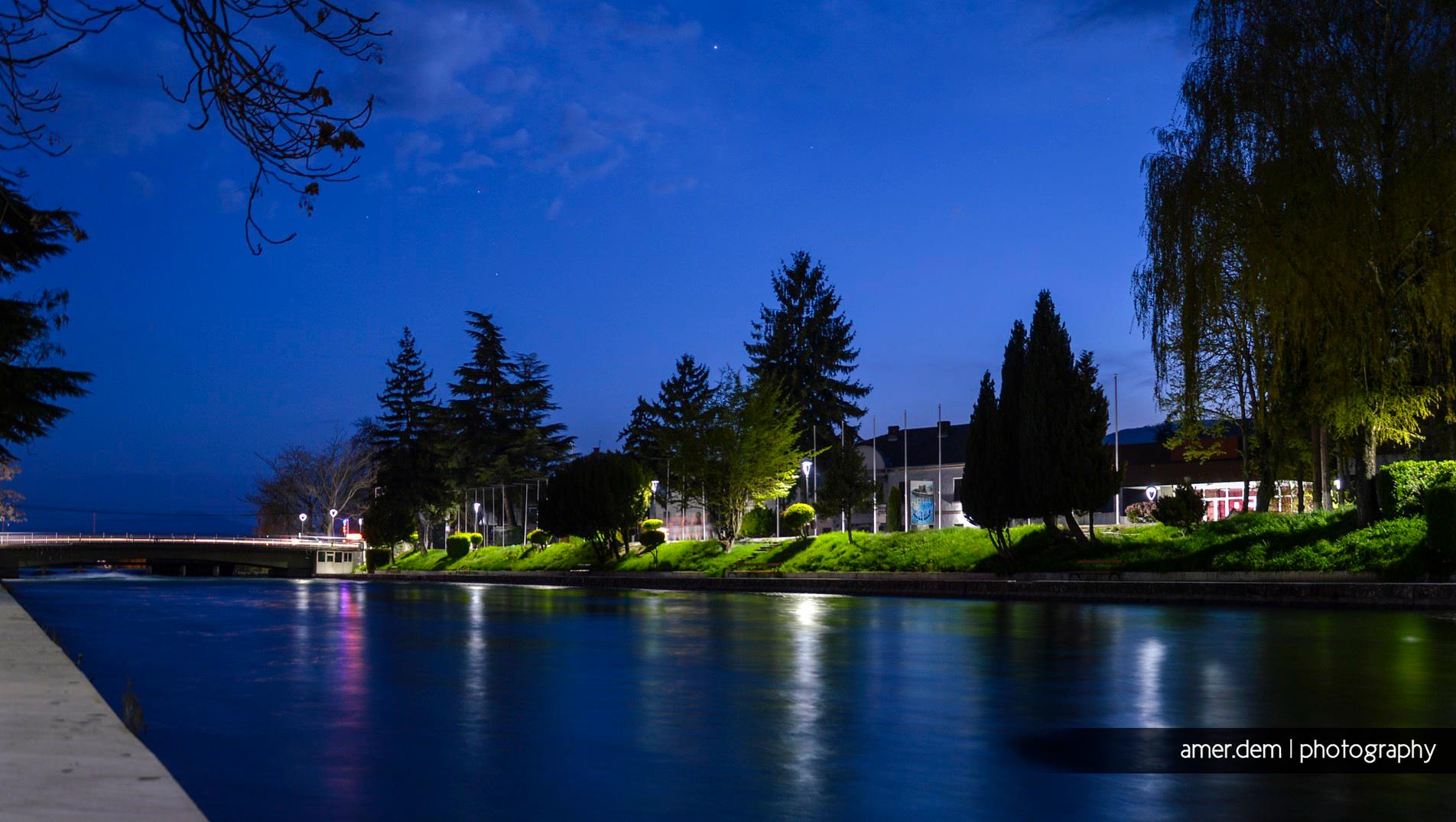
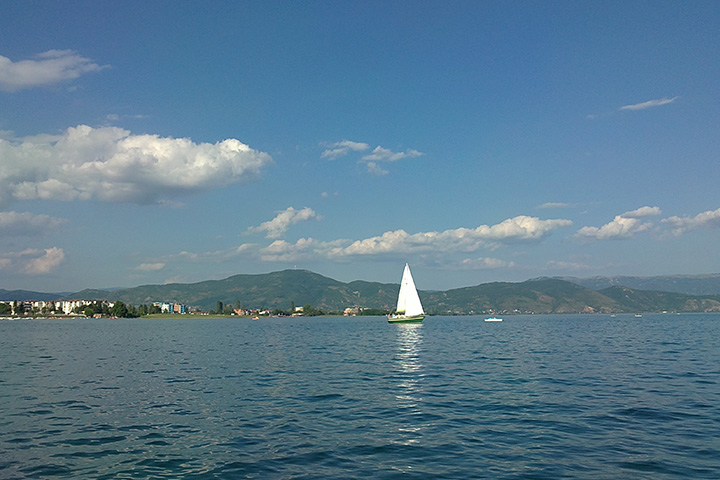
The Yablanitsa Mountain is one the most important mountain ranges in Macedonia because of the rich flora and fauna. On the slopes of this mountain lie panoramic villages. Today, there are some initiatives to declare the mountain range as a national park. Glacial lakes on the Yablanitsa Mountain are situated more than 2000 meters above sea level with breathtaking views of Struga and the Lake Ohrid. Artificial lake of Shum in situated in the village of Shum only 6 km away from the city of Struga. The uniqueness of this lake is the breeding of the Lake Ohrid trout.
Flora in the region of Struga is characterized with a unique and endemic living world that cannot be found in any other places in the world (lake reeds, oak hills and forests, beech, chestnuts, curative flora, ornamental flora and different mountain mushroom species). Fauna also is characterized with endemic forms of life and endangered species like mountain bears, wolves, dears, wild lynx, goats and lake swans, ducks and gooses.
The admirers of nature have the opportunity to visit the tourist villages of Vishni, Upper Belitza, Labunishta and Podgortsi to feel the breathtaking views of the Lake Ohrid in over 2000 meters above sea level, the glacial lakes, mountain springs and meadows during the winter season fulfilled with snow, in spring with flowers, in summer with green colors and in gilded autumns. The admirers of the deep blue color of Lake Ohrid can relax in the fishermen villages of Kalishta and Radozhda.
CULTURAL AND HISTORIC RICHIES OF STRUGA
As a result of the natural conditions and the strategic geo-politic position between West and East, Struga and its surroundings have been continuously populated and featured a cradle of ancient civilization. Archeological findings bear witness that near the mouth of the river Black Drim was established the ancient city of Enchalon.
The “Via Egnatia” penetrated in the region of Struga, more precisely, passed through the village of Radozhda, Struga. Inside the church of St. George in Struga was found a millennium stone “Egnatia” on which is written the name of the Roman emperor Karakalus (211-217 B.C.) and the distance of 12 km dividing Struga from Ohrid.
The most known temples of the Christian religion are: the church of St. George of the city of Struga, the church complex near Kalishta, from the XV century, the church of St. Spas inside a cave in the village of Vishni, from the XV century, the church of St. Archangel Michael in Radozhda, from the XI century.
The most representative temples of the Islamic religion in Struga are the mosques and a teke: the Mosque of Suleiman Arap built in 1583, near the river Black Drim, the Mosque of Mustafa Celebi near the city centre, built in the late XV century, the Teke of Helveti, built by Baba Hasan in the XVIII century and the Hamam of Mustafa as a representative of the rarest Turkish monuments built in the years when the Ottomans came to Struga.
The Natural Scientific Museum “Dr. Nikolla Nezllobinski” in Struga is one of the oldest institutions in Macedonia and represents a complex institution consisted of several departments as: the Biological Department, Preparatory Lab, Department of Archeology and Figurative Art and the Department of History and Ethnology. In the Museum there is an exhibition of 9,381 specimens of flora and fauna founded in the shores of the Lake Ohrid, about 2,576 items that originate from pre-history, the ancientness, medieval era and items from the contemporary period.

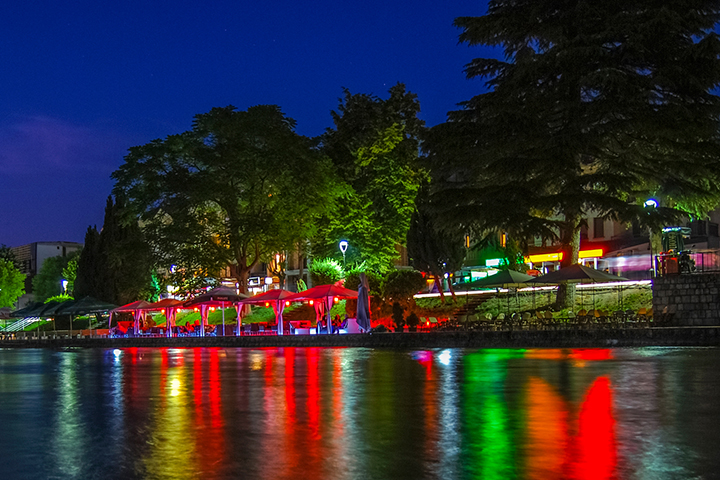
A very important part of the Museum is the art gallery “Vangel Kodzoman” consisted of 35 paintings, a true collection of this artist from Struga. His paintings reflect the dynamic of the living and life in Struga, together with motives from the old city architecture.
The city architecture of the XIX century and the beginning of the XX century in Struga can be noticed from the old houses. The accent should be put to the fact that most of the houses and other buildings of this period are characterized with an architectural harmony and functional emplacement of the interior and exterior elements.
The Festival of refined and styled folk songs and dances “Këngë jeho” takes place in Struga every year in the end of July and in the beginning of August. The festival, established in 1992, for many years has revealed the true cultural and artistic values of the ethnic Albanian soul and the colors of the traditional costumes and dances. The festival presents the traditional values of the cultural artistic associations from Macedonia, Albania, and Kosovo and all over the world.
The “Struga Poetry Evenings”
The “Struga Poetry Evenings” as an international event began in 1966. As a result, the international poetry award “The Golden Wreath” was established, and is awarded to the best poet. For the years passed away, Struga has welcomed and hosted over 4,000 poets, essayists, and well-known critics from 95 different countries all over the world.
“The Review of Folk Costumes” is one of the most important cultural and touristic manifestations that traditionally takes place in Struga in the beginning of August, since 1971. This cultural event aims at presenting the cultural wealth of folk costumes and embroidery from the tradition coming from the tradition of all ethnic communities living in the Struga region. The parade of the participants in the streets of Struga and along the river Black Drim is a special moment and an extraordinary happening for the visitors.
The citizens of Struga can be very proud of the many and old crafts. According to this, we can point out the manufacturers of silver jewelry, hand-made filigree, old-style loom weaving, decorative wood-carving, pottery and many other handicraft shops that are located mainly in the old city bazaar.
The traditional cuisine cherished for centuries in Struga invites you to taste the deliciously prepared eel and trout a lá Struga, fli or dzomleze (national pie) under hot iron pan, pie and beans cooked in earthen pan, baklava and other sweeties.
The accommodation capacities in the Municipality of Struga are: 25 hotels with 4500 rooms and approximately 6000 beds, 10 motels with a capacity of 100 rooms with 250 beds and 200 private guest houses and apartments with 2000 rooms or 4000 beds. Thus, in Struga can be accommodated almost 10.000 tourists a day. In the Municipality of Struga there are 60 restaurants with a traditional and modern cuisine, 50 fast-food and 60 cafés for everybody’s preferences as well as 20 travel agencies that organize the trips for the tourists.
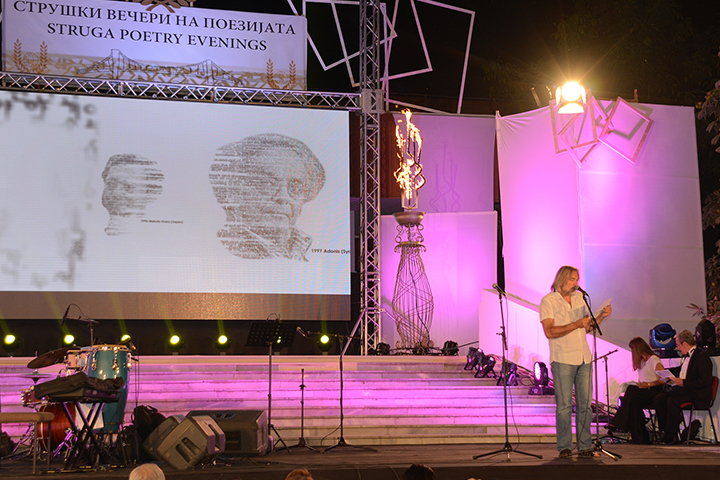
Click here to see Accomodation in Struga
ger+1 day Macedonian Evening tour
Macedonia has five significant features that make it known to tourists – long history, beautiful nature, hospitality, food/drinks and folklore. The purpose of this program is to introduce the guests to the traditions of the Macedonian population, particularly from the perspective of gastronomy, old dances and music. In a wonderful ambiance, surrounded by nature, entertained by the ensemble members, you will have a unique opportunity to learn some basics of the dance, known by every citizen of this small country. Above all, the Macedonian evening will offer you an opportunity to taste the delicious specialties of the old cuisine.

Macedonia is the land of peppers – with approximately 2,000 recipes including peppers, beans, cabbage, water melon, grapes, cherries and apples. Macedonia is proud to have the best eggplant in the world and the purest, ecological yellow cheese. In addition, Macedonia has a renowned wine region, which provides the guests with an opportunity to taste various sorts of wine and rakija (grape brandy). The guests will also be able to enjoy in and learn about instruments typically played in this region – zurla, drum, bagpipe, accordion, violin, flute, tambourine. Members of the folk dances ensemble, dressedin traditional costumes will perform dances to the well-known Macedonian measure 7/8, 9/8, 11/8, 13/8. At the end, the dancers will offer assistance to every guest to take the opportunity and learn the oro – Macedonian dance, or the so called crab walk (three steps forward, one backward).
Tour Organizes by:
Tel: +389 46 250 745
E-mail: [email protected]
ger+1 day Macedonian Evening tour
Macedonia has five significant features that make it known to tourists – long history, beautiful nature, hospitality, food/drinks and folklore. The purpose of this program is to introduce the guests to the traditions of the Macedonian population, particularly from the perspective of gastronomy, old dances and music. In a wonderful ambiance, surrounded by nature, entertained by the ensemble members, you will have a unique opportunity to learn some basics of the dance, known by every citizen of this small country. Above all, the Macedonian evening will offer you an opportunity to taste the delicious specialties of the old cuisine.

Macedonia is the land of peppers – with approximately 2,000 recipes including peppers, beans, cabbage, water melon, grapes, cherries and apples. Macedonia is proud to have the best eggplant in the world and the purest, ecological yellow cheese. In addition, Macedonia has a renowned wine region, which provides the guests with an opportunity to taste various sorts of wine and rakija (grape brandy). The guests will also be able to enjoy in and learn about instruments typically played in this region – zurla, drum, bagpipe, accordion, violin, flute, tambourine. Members of the folk dances ensemble, dressedin traditional costumes will perform dances to the well-known Macedonian measure 7/8, 9/8, 11/8, 13/8. At the end, the dancers will offer assistance to every guest to take the opportunity and learn the oro – Macedonian dance, or the so called crab walk (three steps forward, one backward).
Tour Organizes by:
Tel: +389 46 250 745
E-mail: [email protected]
ger+1day Macedonian Evening tour
Macedonia has five significant features that make it known to tourists – long history, beautiful nature, hospitality, food/drinks and folklore. The purpose of this program is to introduce the guests to the traditions of the Macedonian population, particularly from the perspective of gastronomy, old dances and music. In a wonderful ambiance, surrounded by nature, entertained by the ensemble members, you will have a unique opportunity to learn some basics of the dance, known by every citizen of this small country. Above all, the Macedonian evening will offer you an opportunity to taste the delicious specialties of the old cuisine.

Macedonia is the land of peppers – with approximately 2,000 recipes including peppers, beans, cabbage, water melon, grapes, cherries and apples. Macedonia is proud to have the best eggplant in the world and the purest, ecological yellow cheese. In addition, Macedonia has a renowned wine region, which provides the guests with an opportunity to taste various sorts of wine and rakija (grape brandy). The guests will also be able to enjoy in and learn about instruments typically played in this region – zurla, drum, bagpipe, accordion, violin, flute, tambourine. Members of the folk dances ensemble, dressedin traditional costumes will perform dances to the well-known Macedonian measure 7/8, 9/8, 11/8, 13/8. At the end, the dancers will offer assistance to every guest to take the opportunity and learn the oro – Macedonian dance, or the so called crab walk (three steps forward, one backward).
Tour Organizes by:
Tel: +389 46 250 745
E-mail: [email protected]
ger+1 day Bitola - The city of Consuls tour
The old name of Bitola is Monastir – a place to stay overnight. This is a city of long history, witnesses of which are the remains of Heraclea Lyncestis situated on the ancient Roman road Via Egnatia. Over the centuries, it has always been an important commercial center. During the Ottoman Empire era this city becomes an important administrative and diplomatic center with quite a few European consuls. Bitola reached its peak of prosperity in the 19 century, and today it is an important city of about 100,000 population, situated in the southwest of Macedonia.
Departure from the hotel after breakfast (you will be notified about the exact time by our agent/host and it will also be posted on our info-board). Full day excursion.
Program
The road to Bitola will take us through the villages of Leskoec, Kosel through the city of Resen, along the way we are going to have break for coffee and refreshments. When we arrive in Bitola, first we are going to visit the ancient city of Heraclea built by the Macedonian Emperor Philip II, father of Alexander the Great. This is a special opportunity to see one of the mosaics in this part of the world, as well as the ancient theater, many Roman statues, Early Christian basilicas etc.

Then we go to the center of Bitola where we are going to see the archaeological finds at the National Museum, where a separate room is dedicated to Mustafa Kemal Ataturk – 1881 - 1938, father of modern Turkey. His family was of Macedonian origin. Lunch will be served at a traditional Macedonian restaurant and will take about an hour. We then continue through the center of Bitola, along the celebrated Shirok Sokak (Broad Alley), which will bring us back in time, when the city was part of the Ottoman Empire. Many building will rightfully capture our attention, such as the old Turkish Shopping Street, Isak Pasha Mosque, Yeni (New) Mosque and the Clock Tower, the church of St. Dimitrija, the Catholic Church. We depart from Bitola and head towards Lake Prespa. The asphalt road will take us through sensational nature, to the village of Podmocani, where you will be able to visit the Ethnological Museum that has 120 types of folk costumes in its possession.

Following the visit to the Museum, we set off for the village of Stenje where we will have an opportunity to take a few photos and see the place where pelicans nest. After the short break, we continue towards the top of Mount Galicica, from where you can admire the Lake Prespa and the surrounding magnificent nature. We are going to take a short break for photography and then we cross the highest point on our road and the wonderful view of Lake Ohrid and its surroundings opens out broadly in front of us.
We are stopping briefly at the highest road bend where you have a view of Lake Ohrid – something that will leave you speechless, then the National Park Galicica and Lake Prespa – an ecological lake shared by three countries. We return to the hotel once the program is completed.
Tour Organized by:
Tel: +389 46 250 745
E-mail: [email protected]
ger+Ethno city festival July 20th - August 15th
The "Krushevo ethno city" festival is one of Macedonia's prime tourist attractions. It is held every summer in July-August, in celebration of the traditions and customs of Krushevo.

The "Krushevo ethno city" festival held for 10 days every summer is great way to preserve many old customs and traditions by the natives of Krushevo. In the middle of the summer, this unique event includes hundreds of participants dressed in traditional costumes as insurgents and Ottomans, parading around Krushevo, in commemoration of the anniversary of the Ilinden uprising that took place on 2nd of August, 1903. Apart from the main procession, there's also other events happening at the same time during this unique festival, such as art exhibitions, concerts and other cultural and sport performances.
ger+Ethno city festival July 20th - August 15th
The "Krushevo ethno city" festival is one of Macedonia's prime tourist attractions. It is held every summer in July-August, in celebration of the traditions and customs of Krushevo.

The "Krushevo ethno city" festival held for 10 days every summer is great way to preserve many old customs and traditions by the natives of Krushevo. In the middle of the summer, this unique event includes hundreds of participants dressed in traditional costumes as insurgents and Ottomans, parading around Krushevo, in commemoration of the anniversary of the Ilinden uprising that took place on 2nd of August, 1903. Apart from the main procession, there's also other events happening at the same time during this unique festival, such as art exhibitions, concerts and other cultural and sport performances.
Vêtements traditionnelle macédonienne
Toujours étroitement liée à leur terre natale, le peuple macédonien ont surtout vécu des siècles de tradition transmettre d'une génération à l'autre, et créant ainsi un matériau exceptionnellement rare et la culture spirituelle qui porte certaines caractéristiques patriarcales. Vrai folklore ne peut pas être acheté ou vendu, mais doit être appris par le labeur, la sueur, les larmes, et, parfois, même le sang. Contrairement à certains qui abusent de son nom pour des intérêts égoïstes, il est pas un simple divertissement pour amuser les foules ou de se plier à un auditoire.
Plutôt, il devrait, comme tout art véritable, stimuler, éduquer, irriter, et, espérons-le, conduit tous ceux qui sont touchés par elle à un nouveau niveau de compréhension. Dans le même temps, de par sa nature folklore est également accessible, pas seulement à une élite artistique, mais à tous ceux qui la poursuivent avec passion. Il faudra toute votre concentration, la créativité et l'effort passionné pour capturer son essence, à ajouter à sa richesse, et de le transmettre non dilué à la prochaine génération afin qu'ils, les Macédoniens et les autres peuvent encore connaître sa beauté sublime et la gloire.
Costumes folkloriques
Une attention particulière macédonienne avait payé à la conception et la décoration de leurs vêtements, de sorte que les costumes nationaux et les bijoux sont les plus expressives et les plus nombreux exemples de la créativité traditionnelle des Macédoniens. Les costumes nationaux en Macédoine (créés sur une longue période de temps), conserve les traces d'anciennes influences culturelles, et dans leur façon de développement intègrent les éléments de la vieille balkanique, slave et la culture orientale. Surtout, le produit de la fabrication de textiles domestiques, les costumes nationaux macédoniens sont caractérisées par la richesse et de l'ornementation. Macédoine occidentale, en particulier divisé en unités régionales plus petites avec des caractéristiques différentes ethniques est une véritable mosaïque de divers beaux costumes nationaux, où les costumes des femmes sont d'un intérêt particulier.
Broderie macédonienne décoratif, caractéristique dans les formes, techniquement complexes et de couleurs pittoresques donner une expression particulière et de distinction pour les costumes nationaux. Les robes des femmes sont particulièrement décoratif, et sont le porteur principal de ce genre de création artistique traditionnelle. La broderie est non seulement une expression artistique et l'élément essentiel, mais le plus caractéristique des costumes de différentes régions. Tout cela est un patrimoine historique qui rend la Macédoine fiers.


Most of Macedonia's colorful folklore consists of folktales and aphorisms (witty sayings). The following are typical aphorisms: "Falsehoods have short legs" (lies are soon found out); and "Begin a task, but always have its conclusion in mind" (finish what you start.) (Link do natinal quotes).
Macedonian folklore music
The ethnic Macedonian traditional music, which can be rural or urban (starogradska muzika), includes: lyric songs, epic songs, labour songs, ritual songs, humorous songs, circle dance ("oro"), the old urban style called Čalgija (not to be confused with chalga) etc.
Popular traditional songs are: Kaleš bre Angjo, Slušam kaj šumat šumite, Biljana platno beleše, Dafino vino crveno, Narode Makedonski, Zemjo Makedonska and many others. Often referenced oro dances are Teškoto from the village of Galičnik, Kalajdžiskoto, Komitskoto (The Dance of the freedom fighters) and others. An internationally acclaimed professional folklore association is the award winning “Tanec”.
Like its people Macedonia’s musical instruments have mixed origins. Many were brought to this land with the various invaders passing through over the centuries, while others are home grown. Playing traditional instruments is seeing a small revival in fusion music and in the revival of ethnic festivities.

Galičnik mariage
Galichnik Wedding
La réunion de deux âmes a toujours suscité un sentiment de pleinitude et de grâce, et en Macédoine un tel événement est toujours suivi d’une grande fête. L’un des plus beaux témoignages de la richesse de la tradition macédonienne, est le Mariage de Galičnik. Dans ce village, les mariages avaient traditionnellement lieu le jour de Petrovden (Saint Pierre) le 12 juillet.
Depuis 1963 à ce jour, et dans le but de sauvegarder cette tradition, on célèbre le jour de la fête de Petrovden, en orgnisant un mariage avec toutes les coutumes et les rituels du village de Galičnik. Chaque année, on choisit un couple qui dignement et fièrement, participe à ce célèbre mariage.

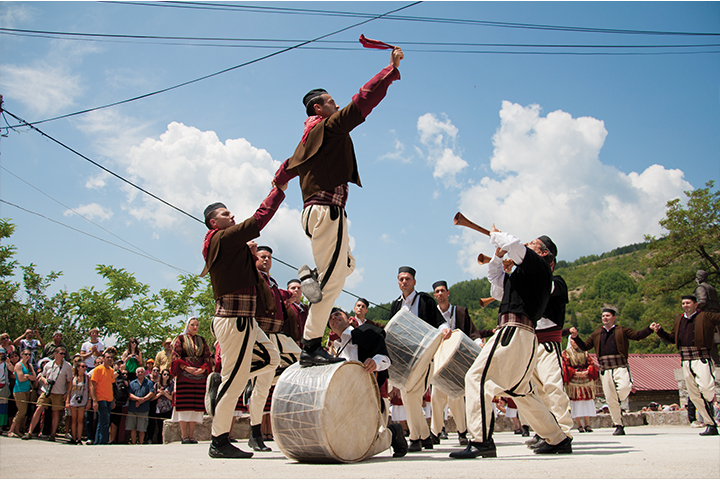
Pendant la cérémonie, le bruit des tapani (caisses) et des zurli (hautbois à large pavillon muni d’un disque de buttée pour appuyer les lèvres) résonnent dans les montagnes alentours, on chante de vieilles chansons traditionnelles, on danse des rondes macédoniennes populaires dont la plus belle et la plus émouvante est la danse du teškoto.
Le costume traditionnel des jeunes mariés, comme ceux des invités sont minutieusement élaborés, avec une précision d’horloger, par les mains habiles des terzii (tailleurs de l’époque). Ces très précieux costumes sont souvent laissés en héritage aux générations futures. Prenez part, vous aussi, à l’un des mariages les plus connus dans le monde, le Mariage de Galičnik. C’est un mariage inédit, accompagné de coutumes et de rites anciens, comme il n’y en a nulle part dans le monde.
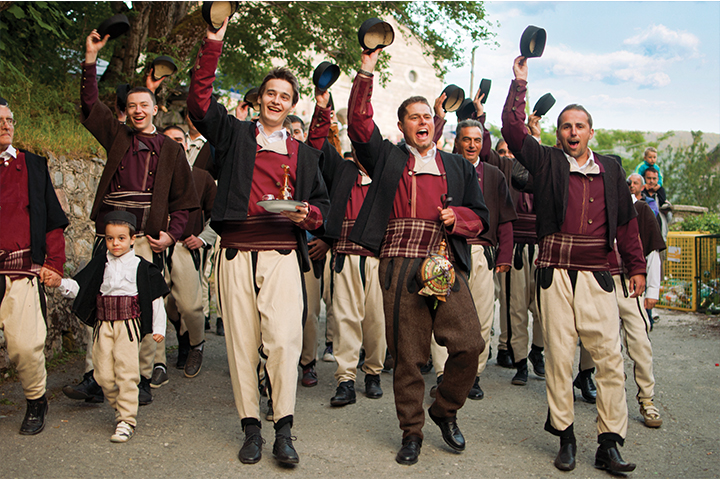
Struga
Struga
The main characteristics of the tourism in the Municipality of Struga are: relatively favorable geographic positioning and relatively developed road infrastructure, mild continental climate with high level of sun insolation during the whole year, extraordinary fund of endemic species of flora and fauna, protected and preserved natural habitat, rich cultural and historic heritage with a considerable number of monuments and archeological sites, mountain ranges favorable for winter tourism, traditional welcome and folklore, healthy and traditional food consuming, unique cultural manifestations, Struga is situated in the southwestern part of the Republic of Macedonia, on the shorelines of the Lake Ohrid and alongside the banks of the River Black Drim that divides the city into two.


Struga is well linked and easily accessible with the neighboring regions: only 14 km away from the border with the Republic of Albania, 160 km with the Republic of Kosova (from Tetovo) or 190 km in the North (from Skopje), 100 km from the Republic of Greece, 290 km from the Republic of Bulgaria and 230 from the border with the Republic of Serbia. The International Airport only 9 km away connects Struga with the rest part of the world.
Struga has a surface of 573 km2and lies at 698 meters above sea level; there are 63376 inhabitants, 130 inhabitants/ km2, in 50 settlements. Maximum average temperatures reach 27 degrees centigrade in July and August, but in the warmest days of the summer they reach out to 35-40 degrees centigrade. Average temperature of the water of the lake Ohrid in summer is 26 degrees centigrade, while the temperature throughout the year reaches up to around 12 degrees centigrade. In the winter, average temperature is above 0 degrees centigrade, making thus a comfortable and pleasant environment to be accommodated and stay in this time of the season. The average days with relatively high temperatures reach to 80 days in the year, accompanied by intensively high temperatures in July and August. The insolation in Struga is very high, with 2,200 hours of insolation, Struga is one of brightest places in the Republic of Macedonia.
NATURAL RICHIES OF STRUGA
The Lake of Ohrid lies at an altitude of 695 meters above sea level and occupies an area of 348,2 km², from which 230 km² are on the side of the Republic of Macedonia and the rest of 118,2 km² belong to the Republic of Albania. The cost line of the lake is 87,5 km long. The average depth of the lake is 164 meters and the maximum depth of the lake is 289 meters, with a high transparency that reaches up to 24 meters. The Lake is characterized with a very unique ecosystem consisted of a rich world of flora and fauna that is very rare. The biodiversity of the lake and the trails of very old settlements and prehistoric civilizations that have existed here made possible for Lake Ohrid to be listed and constantly protected by the UNESCO as a cultural heritage of planetary proportions.
The River Black Drim is the only exit of the lake’s water. As it flows in the north, the river creates the two artificial lakes: Lake Globochitza and Lake Shpile. The eels found in the Lake Ohrid, through the river, pass seas and oceans on their “honeymoon” to arrive to the Sargasso Sea, where they meet their partners and breed.


The Yablanitsa Mountain is one the most important mountain ranges in Macedonia because of the rich flora and fauna. On the slopes of this mountain lie panoramic villages. Today, there are some initiatives to declare the mountain range as a national park. Glacial lakes on the Yablanitsa Mountain are situated more than 2000 meters above sea level with breathtaking views of Struga and the Lake Ohrid. Artificial lake of Shum in situated in the village of Shum only 6 km away from the city of Struga. The uniqueness of this lake is the breeding of the Lake Ohrid trout.
Flora in the region of Struga is characterized with a unique and endemic living world that cannot be found in any other places in the world (lake reeds, oak hills and forests, beech, chestnuts, curative flora, ornamental flora and different mountain mushroom species). Fauna also is characterized with endemic forms of life and endangered species like mountain bears, wolves, dears, wild lynx, goats and lake swans, ducks and gooses.
The admirers of nature have the opportunity to visit the tourist villages of Vishni, Upper Belitza, Labunishta and Podgortsi to feel the breathtaking views of the Lake Ohrid in over 2000 meters above sea level, the glacial lakes, mountain springs and meadows during the winter season fulfilled with snow, in spring with flowers, in summer with green colors and in gilded autumns. The admirers of the deep blue color of Lake Ohrid can relax in the fishermen villages of Kalishta and Radozhda.
CULTURAL AND HISTORIC RICHIES OF STRUGA
As a result of the natural conditions and the strategic geo-politic position between West and East, Struga and its surroundings have been continuously populated and featured a cradle of ancient civilization. Archeological findings bear witness that near the mouth of the river Black Drim was established the ancient city of Enchalon.
The “Via Egnatia” penetrated in the region of Struga, more precisely, passed through the village of Radozhda, Struga. Inside the church of St. George in Struga was found a millennium stone “Egnatia” on which is written the name of the Roman emperor Karakalus (211-217 B.C.) and the distance of 12 km dividing Struga from Ohrid.
The most known temples of the Christian religion are: the church of St. George of the city of Struga, the church complex near Kalishta, from the XV century, the church of St. Spas inside a cave in the village of Vishni, from the XV century, the church of St. Archangel Michael in Radozhda, from the XI century.
The most representative temples of the Islamic religion in Struga are the mosques and a teke: the Mosque of Suleiman Arap built in 1583, near the river Black Drim, the Mosque of Mustafa Celebi near the city centre, built in the late XV century, the Teke of Helveti, built by Baba Hasan in the XVIII century and the Hamam of Mustafa as a representative of the rarest Turkish monuments built in the years when the Ottomans came to Struga.
The Natural Scientific Museum “Dr. Nikolla Nezllobinski” in Struga is one of the oldest institutions in Macedonia and represents a complex institution consisted of several departments as: the Biological Department, Preparatory Lab, Department of Archeology and Figurative Art and the Department of History and Ethnology. In the Museum there is an exhibition of 9,381 specimens of flora and fauna founded in the shores of the Lake Ohrid, about 2,576 items that originate from pre-history, the ancientness, medieval era and items from the contemporary period.


A very important part of the Museum is the art gallery “Vangel Kodzoman” consisted of 35 paintings, a true collection of this artist from Struga. His paintings reflect the dynamic of the living and life in Struga, together with motives from the old city architecture.
The city architecture of the XIX century and the beginning of the XX century in Struga can be noticed from the old houses. The accent should be put to the fact that most of the houses and other buildings of this period are characterized with an architectural harmony and functional emplacement of the interior and exterior elements.
The Festival of refined and styled folk songs and dances “Këngë jeho” takes place in Struga every year in the end of July and in the beginning of August. The festival, established in 1992, for many years has revealed the true cultural and artistic values of the ethnic Albanian soul and the colors of the traditional costumes and dances. The festival presents the traditional values of the cultural artistic associations from Macedonia, Albania, and Kosovo and all over the world.
The “Struga Poetry Evenings”
The “Struga Poetry Evenings” as an international event began in 1966. As a result, the international poetry award “The Golden Wreath” was established, and is awarded to the best poet. For the years passed away, Struga has welcomed and hosted over 4,000 poets, essayists, and well-known critics from 95 different countries all over the world.
“The Review of Folk Costumes” is one of the most important cultural and touristic manifestations that traditionally takes place in Struga in the beginning of August, since 1971. This cultural event aims at presenting the cultural wealth of folk costumes and embroidery from the tradition coming from the tradition of all ethnic communities living in the Struga region. The parade of the participants in the streets of Struga and along the river Black Drim is a special moment and an extraordinary happening for the visitors.
The citizens of Struga can be very proud of the many and old crafts. According to this, we can point out the manufacturers of silver jewelry, hand-made filigree, old-style loom weaving, decorative wood-carving, pottery and many other handicraft shops that are located mainly in the old city bazaar.
The traditional cuisine cherished for centuries in Struga invites you to taste the deliciously prepared eel and trout a lá Struga, fli or dzomleze (national pie) under hot iron pan, pie and beans cooked in earthen pan, baklava and other sweeties.
The accommodation capacities in the Municipality of Struga are: 25 hotels with 4500 rooms and approximately 6000 beds, 10 motels with a capacity of 100 rooms with 250 beds and 200 private guest houses and apartments with 2000 rooms or 4000 beds. Thus, in Struga can be accommodated almost 10.000 tourists a day. In the Municipality of Struga there are 60 restaurants with a traditional and modern cuisine, 50 fast-food and 60 cafés for everybody’s preferences as well as 20 travel agencies that organize the trips for the tourists.

Click here to see Accomodation in Struga
Debar
Ville de Debar
Vers la fin du XIXème siècle il y avait 12.000 habitants dans la ville de Debar. En 1990, il y avait 15.000 habitants d’ethnies différentes. Avant le début des guerres des Balkans, il y avait environ 18.000 habitants dans la ville. Après les guerres des Balkans, après la première guerre mondiale et dans la période entre les deux guerres mondiales, une grande partie de la population musulmane s’est installée en Turquie. De cette manière, le nombre d’habitants a serieusement diminué. Après la deuxième guerre mondiale, la population de Debar augmente et la ville se développe économiquement.
De 1948 à 1994, la population augmente continuellement et la plus grande augmentation de la population est enregistrée de 1971 à 1981, en raison de la migration des village-ville et en raison de l’augmentation du taux de natalité. Aujourd’hui environ 15.000 personnes habitent la ville. Debar est un centre fonctionnel pour son entourage, mais ses activités secondaires sont faiblement développées.
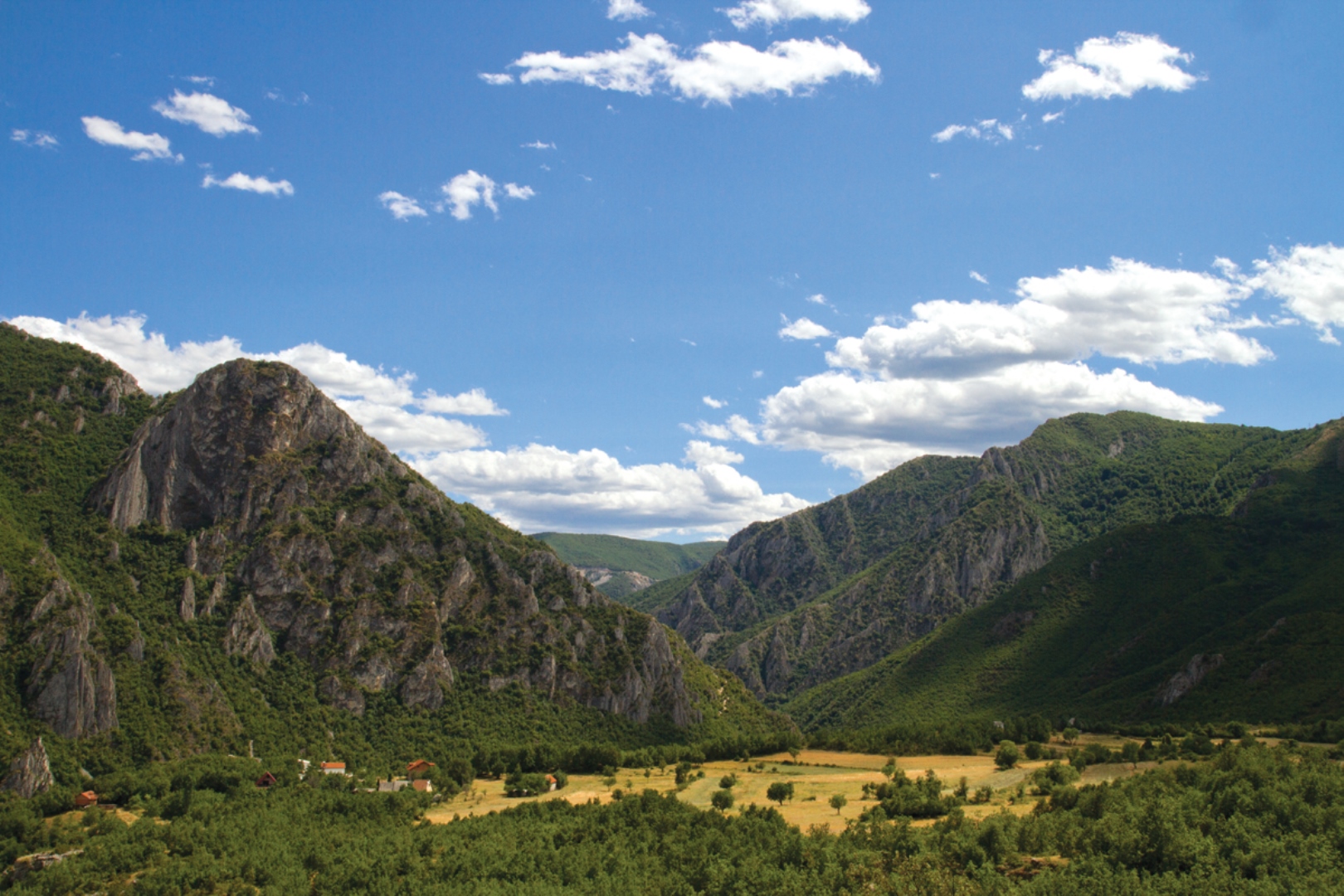
Le monastère Saint-Georges-le-Victorieux de Raytchitsa (XIème) siècle
La particularité des mitres fabriquées dans le monastère de Raytchitsa se trouve dans le secret du style et des broderies ottomannes, que les religieuses entretiennent comme une tradition
Le monastère se trouve dans le village de Raytchitsa à trois kilomètres de Debar. L’hôtellerie était construite en 1835, et l’église fut décorée de 1840 jusqu’en 1852. Aujourd’hui c’est un monastère féminin. Dans ce monastère sont gardés un fragment de la croix de Jésus Christ et une partie des ossements sacrés de Saint-Georges-le-Victorieux. Dans l’ hôtellerie du monastère il y a de la place pour une centaine d’invités qui, en dehors de la paix spirituelle, peuvent ressentir également la vie des religieuses, en commençant par leur alimentation jusqu’aux coutumes religieuses. Il y a plusieurs ateliers dans le complexe du monastère, où elles font très conscentieusement et très soigneusement des mitres (chapeaux de décoration qui sont portés par les épiscopes pendant les liturgies), des icônes, des chapelets et d’autres objets religieux. Les mitres qui sont fabriquées ici sont de très bonne qualité et sont demandées par les épiscopes. Depuis 2003, les religieuses ont fabriquées plus de 270 mitres uniques, que portent les hauts dignitaries de l’église orthodoxe macédonienne-l’archevêché d’Ohrid, ainsi que les églises orthodoxes en Amérique, en Afrique, en Russie, en Grèce, en Ukraine, en Bulgarie, en Roumanie, en Serbie, au Monténégro.
L’iconostase du monastère Saint-Jean Bigorski
Le monastère est surtout connu pour son iconostase, oeuvre de Petre Filipovski-Garkata, du village Gari, son frére Marko Filipov, Makariy Frtchkovski de Galitchnik et Avram Ditchov avec ses fils. L’iconostase a été sculpté de 1829 jusqu’en 1835. Elle a été faite dans des gravures fines et profondes. Cette iconostase avec celle de l’église Saint-Sauveur de Skopje est l’une des plus belles dans les monastères macédoniens.
L’iconostase gravée est remplie d’ornements de flore et de faune. Il y a de superbes figures de scènes bibliques, mais également une grande variété d’oiseaux, d’anges, de vignes, de branches de vignes cultivées. Dans la scène, Décapitation de la tête du saint Jean le Baptiste, est également représentée une femme portant les costumes traditionnels de la région de Miyak. Afin d’être honorés par les générations futures, les sculpteurs ont également gravés leurs visages dans l’iconostase.

Le lac de Debar
Les alentours du lac sont des paysages pittoresques qui sont complétées par plusieurs édifices.
Le lac de Debar, connu également comme l’accumulation Chpilje, est érigé sur la rivière Drin noir près de la frontière entre la Macédoine et l’Albanie. Il s’étend sur la vallée des rivières du Drin noir et de la Radika. L’accumulation a été remplie en 1969 et couvre une surface de 13,2 km2, , avec une superficie utilisable de 70x13,2km2. Ce barrage a un noyau de gravier et d’argile. Il est utilisé pour la production d’électricité et pour l’irrigation. 13 kilomètres du barrage longent la vallée du Drin noir et 8 kilomètres du barrage longent la vallée de la Radika. La ville de Debar, la station thermale Kosovrasti et Banjishte, le monastère à Raytchitsa, les sommets de montagnes environnant complètent les environs du lac. Le lac est connu également comme lieu de sports, de loisir et de tourisme.
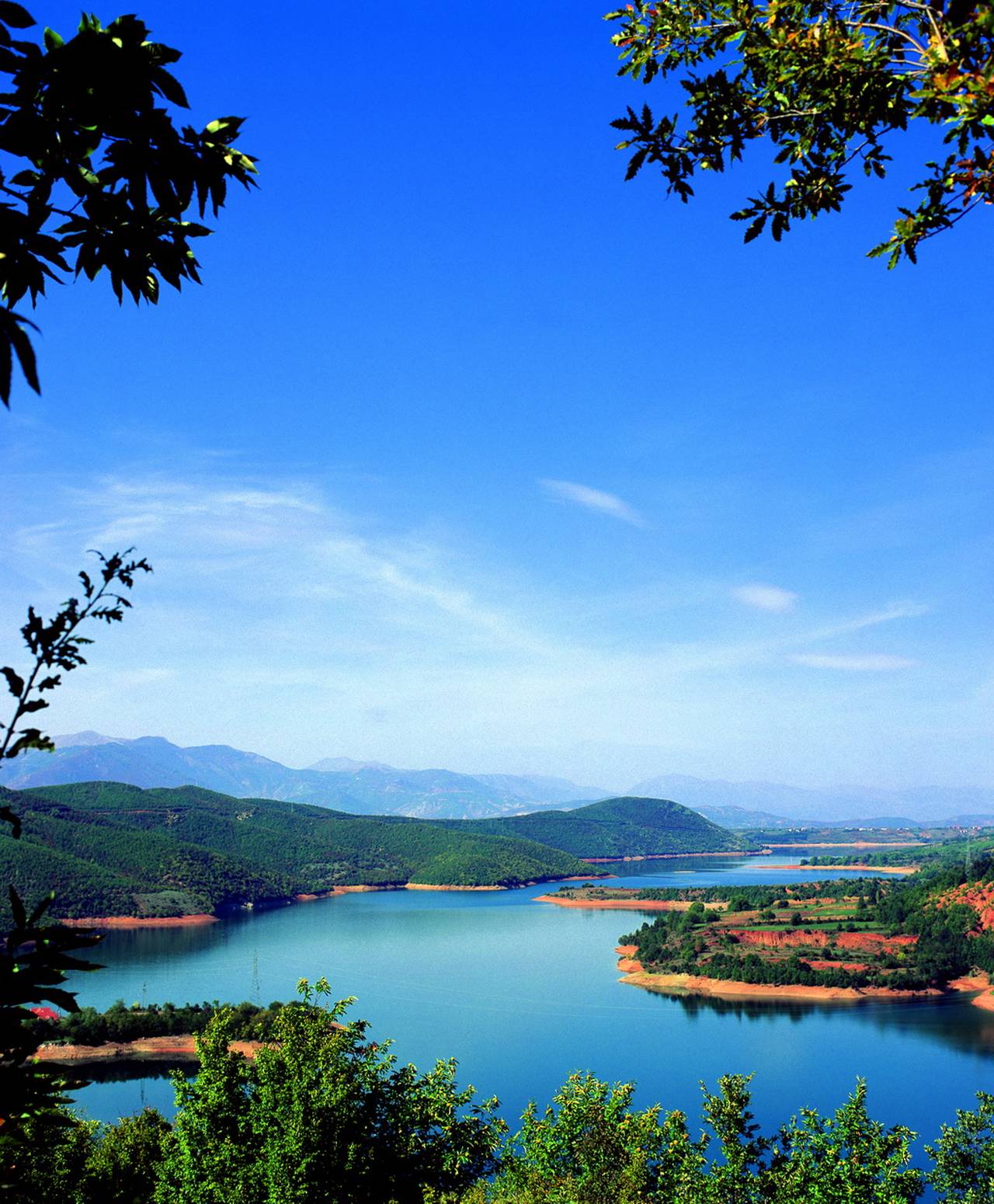
Les stations thermales de Debar
La station thermale Kosovrasti se trouve sur les contreforts de la montagne Krtchine, le long de Radika, tout près de Debar. La source a une capacité d’environ 60 l/seconde. Le température de l’eau est de 48˚C et de distingue comme une eau de soufre et de sulfure qui contient un degré élevé de radioactivité et la presence de bactéries de soufres et d’algues appropriées pour la guérison et pour des buts scientigiques (sur la photographie). Vu ces caractéristiques, l’eau est utilisée pour la guérison de la pression artérielle, des maladies rhumatismales, du diabète, des maladies de la peau, d’inflammation et organes de respiration.
La station thermale Banjishte se trouve sur les contreforts de la montagne Krtchine, au nord-ouest de Debar. Les sources ont une capacité d’environ 100 l/seconde. Le température de l’eau est entre 38˚C- 48˚C. L’eau a les mêmes caractéristiques de celle de la station thermale Kosovrasti. Elle a une location qui est particulièrement avantageuse puisque elle se situe à 650 mètres d’altitude. Les deux stations thermales offres des capacités d’hébergement.
Prilep
Prilep se trouve dans la partie est de Prilepsko Polé qui fait partie de la grande Vallée de Pélagonie. La ville est située entre la Citadelle de Marko au nord et la montagne Seletchka au sud. Prilep a une bonne situation géographique et une bonne connexion de circulation. Beaucoup de routes se croisent à Prilep, à travers lesquelles la partie ouest de la République de Macédoine communique avec la région de Povardarié et la Macédoine de l’est, et également il y a un chemin de fer qui connecte Bitola à Veles et Skopje.
La ville a été mentionnée en tant que fortification et un point important depuis le temps du tsar Samouïl. Au début du XIème siècle (1018), le roi byzantin Basil II la cite sous le nom de Prilapon. La ville a été également nommée Prilapos et Prilepon.
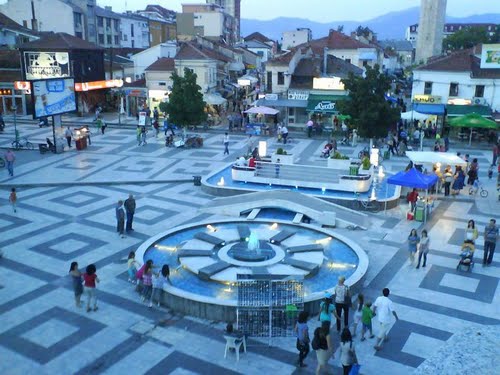
En 1366, elle devient le siège du joupan (prince) du tsar Dushan, Volkashin. Après sa mort dans la bataille de Maritsa, la ville est restée sous l’administration de son fils, le roi Marko. C’est d’après son prénom qu’a été nommée la citadelle au-dessus de Varosh, au nord de la ville.
Après 1394, Prilep tombe sous la domination ottomane. Les Turcs, ne voulant pas se mêler avec la population chrétienne, ont érigé une nouvelle ville dans la plaine à côté de la route vers Bitola, sur la place de Prilep d’aujourd’hui. La ville médiévale de Prilep se détériore et se résume au quartier actuel de Varosh. Aujourd’hui, Prilep et Varosh sont réunis dans une seule ville.
Pendant le règne turc, Prilep a souvent été mentionnée en tant que ville plus grande avec un quartier turc développé, alors qu’au XIXème siècle, il y a eu une foire connue dans la plupart de la Péninsule balkanique.
Après la Deuxième guerre mondiale, il y a un développement intense de la ville. Avec ses nouvelles fonctions administratives, politiques, économiques, culturelles et éducatives, Prilep se transforme en un centre économique fort et un récipient de la population des villages l’entourant.
Le nombre de la population à Prilep après la Deuxième guerre mondiale est en croissance constante (allant de 24 816 habitants en 1948 à 63 639 habitants en 1982, jusqu’à plus de 70 000 habitants en 2002).
Prilep représente le centre de production de tabac le plus développé dans le pays, avec une participation de plus de 25 %. Prilep et ses environs sont caractérisés par l’exploitation développée du marbre et la production de différents produits de marbre. Il y a également de l’industrie métallurgique, alimentaire, électronique et textile.
Parallèlement à l’architecture urbaine, les anciens volets, les façades et la charpenterie et la menuiserie typiques des boutiques dans l’ancien quartier de Prilep attirent l’attention avec leur apparence authentique et maintiennent l’esprit de l’architecture de la ville ancienne du XIXème et du XXème siècle, lorsque dans l’ancien quartier fonctionnaient environ 180 boutiques.
Les tours Markovi (les tours du Roi Marko) – Prilep
La citadelle a été considérée être parmi les cinq plus fortes et inattaquables forteresses sur les Balkans.

Les Tours Markovi (tours du roi Marko) sont situées au nord-ouest de Prilep en Macédoine, au dessus de Varosh, un règlement de Prilep. Le site les Tours Markovi se trouve dans l'un des plus pittoresques forteresses médiévales en Macédoine. Elle est installée sur une colline de 120-180 mètres d’altitude et est entourée par des pentes abruptes couvertes de pierres de granit épais. La partie supérieure de ce règlement peut être atteinte du nord et du sud.
Pendant les quatre décennies de recherche archéologique, les restants qui ont été découverts indiquent l'existence de l’ancien règlement Keramija. A l'époque romaine, ce petit règlement, s’est étendue vers la zone sud-ouest, un fait qui a été aperçu par plusieurs ornements de marbre d'une basilique paléochrétienne. Les fondations de ce domaine datent du XIIIe et XIVe siècle, et elles sont en bon état. Les murs sont d'environ un mètre d'épaisseur et sont faits du mortier de chaux inférieur et reposent sur les grands rochers de calcaire. Les murs intérieurs divisent l’Acropolis à petites parties. Le palais de Volkasin et Marko a été également situé dans cet endroit. La porte du nord a une base complexe et représente une preuve de la plupart d’extensions et reconstitutions de ce lieu. Selon certaines découvertes historiques, jusqu'à la seconde moitié du XIVe siècle et même plus tard, cette forteresse a été défendue par 40 soldats seulement. Le règlement a été situé au sud de la zone de l'Acropole à 3.6 hectares environ. Au nord il y a une porte double, et un grand poste des gardes entre les entrées. Sur le mur du sud il y a trois tours bien conservées. La zone la plus basse de la paroi consiste d’une série de murs courts tirés dans une ligne pointillée. Dans l'ouest il y a des tombes insérées dans la roche. Au XIVe siècle, cette région a servi de refuge temporaire pour la population locale pendant l'invasion turque.
Après la mort du roi Marko en 1395, ce règlement a été occupé par l'armée turque, c’est pourquoi la vie y a été complètement éteinte. Les habitants de ce quartier ont cherché refuge dans les environnements voisins. Par conséquent, au pied des tours Markovi, a été fondé un règlement avec une structure raréfiée. Il a été divisé en plusieurs quartiers, et chaque quartier avait sa propre église. Dans XIVe siècle ce nouveau règlement a été nommé Varosh et il existe même aujourd'hui.
L’église St Blagoveshtenié (Annonciation) - La Vieille église (1838)
L’accord pour sa construction par le sultan a été donné au bénéfacteur de Prilep, le pèlerin Risto Damjanovikj
L’église a été construite avec les fonds des artisans et des commerçants de Prilep sous forme de basilique de trois nefs avec trois absides semi-circulaires et des galeries. Quelque chose d’exceptionnel de la peinture de fresques est la représentation sur l’entrée centrale du côté ouest, le Seigneur Jésus Christ juge juste avec, de chaque côté, six apôtres, puis les fresques avec St Georges, St Nicolas, les Sts Cyrille et Méthode.
L’église a une iconostase magnifique, avec une longueur de 17 mètres, avec des motifs de la faune et de la flore. C’est l’œuvre de Dimitrié Stanishev, le beau-fils du célèbre sculpteur macédonien Petré Filiposki – Garkata. Le trône de l’archevêque, le trône honoraire pour le pèlerin Risto Damjanovikj et la chaire sont également son œuvre.
Monastère
Dormition de la Très Sainte Mère de Dieu
Treskavets (XIIIème siècle)
Depuis le monastère on peut voir les villes de Prilep, Bitola et Krushevo et toute la Vallée de Pélagonie
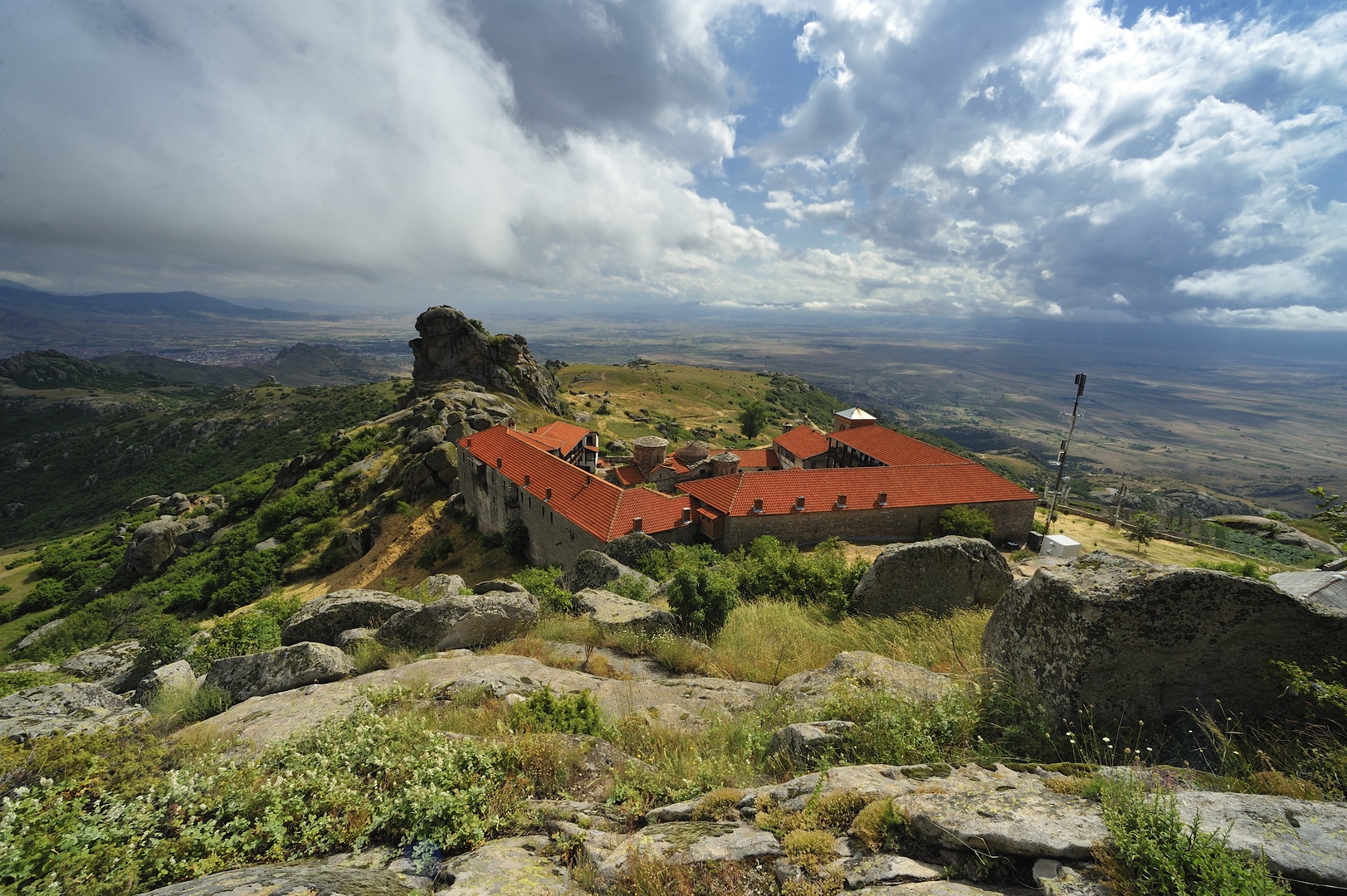
Sur l’inscription de l’entrée, il a été cité que le monastère date du XIIIème siècle. Il a connu plusieurs destructions et reconstructions. La reconstruction la plus connue est celle du XIVème siècle. Il est situé sous le sommet Zlatovrv, à dix kilomètres de Prilep. L’église comprend une nef avec une coupole centrale, alors que l’apside de l’autel a trois côtés. Du côté sud et nord, il y a des chapelles, alors qu’à l’ouest il y a un parvis avec deux tours à coupoles. Les fresques datent du XIVème et du XVème siècle. De nombreux saints ont été représentés dans leur taille originale, ainsi que des scènes des fêtes religieuses et des thèmes des évangiles. La cuisine et la salle à manger datant du XIVème siècle ont été préservées. Dans le passé, le monastère représentait un monument historique et culturel, alors qu’aujourd’hui il y a une vie monastique spirituelle. Un sentier de montagne mène au monastère à travers des roches et des herbes basses, ce qui représente un défi pour les randonneurs.
Le monastère St Preobrajenié (Transfiguration)
Zrzé (XIVème siècle)
Erigé sur une roche, le monastère est un lien architectural magnifique entre la nature et l’art
Entouré de tous les côtés par une forêt de chênes et avec une vue ouverte sur la plaine, le monastère dans le village de Zrzé se trouve dans la partie nord de Pélagonie, à 1 000 mètres d’altitude, au pied de la montagne Dautitsa. Il est éloigné de Prilep à environ 30 kilomètres. Auparavant, il s’était éteint à une superficie de 7 000 mètres carrés, beaucoup plus grande que celle d’aujourd’hui. Le complexe du monastère est composé de l’église St Preobrajenié (la partie la plus ancienne du complexe dont les origines sont probablement au XIVème siècle), le temple St Pierre et Paul du XVIIème siècle, le clocher, les logements des moines, des installations économiques et autres bâtiments auxiliaires. Les fresques datent du XIVème et du XVIème siècle, et la peinture d’icônes datant du XIXème siècle, bien que de qualité moins bonne, on peut distinguer un portrait d’un berger vêtu en costume traditionnel. D’où provient le nom populaire de cette époque – l’église des bergers. Selon les fouilles archéologiques les plus récentes, le début du monachisme à Zrzé date du IXème siècle. Un établissement de cellules d’ermites creusées dans les roches calcaires du complexe a été trouvé datant de cette période.
Le monastère St Archange Michel
Varosh (XIIème siècle)
Dans le monastère se trouve une inscription slave datant de 996, ce qui représente le deuxième texte cyrillique le plus ancien trouvé en Macédoine.
Le monastère date du XIIème siècle et contient des restes des fresques de cette époque avec des visages des archiprêtres, des portraits de dirigeants, ainsi que certaines reliques de saints dans la prothèse et le diaconicon. Les portraits du fondateur, le moine Jean, ont également été préservés. Les konaks (logements) du monastère ont été construits au XIXème siècle, en tant qu’expression de l’architecture urbaine macédonienne de l’époque. L’inscription slave avec des lettres cyrilliques de 996 est deuxième selon l’ancienneté, le premier ayant été trouvé à Prespa, sur la pierre tombale du tsar Samouïl datant de 993. L’église du monastère est mononef avec un porche ouvert et un clocher. Dans la cour du monastère, il y a une source, connue chez le peuple par son eau sainte, dédiée à la Très Sainte Mère de Dieu, et surtout dédiée à la fête Vendredi de la semaine radieuse (Balakliya), le premier vendredi après Pâques. Dans le monastère, il y a aujourd’hui une vie monastique active.
fra+1 day Macedonian Evening tour
Macedonia has five significant features that make it known to tourists – long history, beautiful nature, hospitality, food/drinks and folklore. The purpose of this program is to introduce the guests to the traditions of the Macedonian population, particularly from the perspective of gastronomy, old dances and music. In a wonderful ambiance, surrounded by nature, entertained by the ensemble members, you will have a unique opportunity to learn some basics of the dance, known by every citizen of this small country. Above all, the Macedonian evening will offer you an opportunity to taste the delicious specialties of the old cuisine.

Macedonia is the land of peppers – with approximately 2,000 recipes including peppers, beans, cabbage, water melon, grapes, cherries and apples. Macedonia is proud to have the best eggplant in the world and the purest, ecological yellow cheese. In addition, Macedonia has a renowned wine region, which provides the guests with an opportunity to taste various sorts of wine and rakija (grape brandy). The guests will also be able to enjoy in and learn about instruments typically played in this region – zurla, drum, bagpipe, accordion, violin, flute, tambourine. Members of the folk dances ensemble, dressedin traditional costumes will perform dances to the well-known Macedonian measure 7/8, 9/8, 11/8, 13/8. At the end, the dancers will offer assistance to every guest to take the opportunity and learn the oro – Macedonian dance, or the so called crab walk (three steps forward, one backward).
Tour Organizes by:
Tel: +389 46 250 745
E-mail: [email protected]
fra+1 day Macedonian Evening tour
Macedonia has five significant features that make it known to tourists – long history, beautiful nature, hospitality, food/drinks and folklore. The purpose of this program is to introduce the guests to the traditions of the Macedonian population, particularly from the perspective of gastronomy, old dances and music. In a wonderful ambiance, surrounded by nature, entertained by the ensemble members, you will have a unique opportunity to learn some basics of the dance, known by every citizen of this small country. Above all, the Macedonian evening will offer you an opportunity to taste the delicious specialties of the old cuisine.

Macedonia is the land of peppers – with approximately 2,000 recipes including peppers, beans, cabbage, water melon, grapes, cherries and apples. Macedonia is proud to have the best eggplant in the world and the purest, ecological yellow cheese. In addition, Macedonia has a renowned wine region, which provides the guests with an opportunity to taste various sorts of wine and rakija (grape brandy). The guests will also be able to enjoy in and learn about instruments typically played in this region – zurla, drum, bagpipe, accordion, violin, flute, tambourine. Members of the folk dances ensemble, dressedin traditional costumes will perform dances to the well-known Macedonian measure 7/8, 9/8, 11/8, 13/8. At the end, the dancers will offer assistance to every guest to take the opportunity and learn the oro – Macedonian dance, or the so called crab walk (three steps forward, one backward).
Tour Organizes by:
Tel: +389 46 250 745
E-mail: [email protected]
fra+1day Macedonian Evening tour
Macedonia has five significant features that make it known to tourists – long history, beautiful nature, hospitality, food/drinks and folklore. The purpose of this program is to introduce the guests to the traditions of the Macedonian population, particularly from the perspective of gastronomy, old dances and music. In a wonderful ambiance, surrounded by nature, entertained by the ensemble members, you will have a unique opportunity to learn some basics of the dance, known by every citizen of this small country. Above all, the Macedonian evening will offer you an opportunity to taste the delicious specialties of the old cuisine.

Macedonia is the land of peppers – with approximately 2,000 recipes including peppers, beans, cabbage, water melon, grapes, cherries and apples. Macedonia is proud to have the best eggplant in the world and the purest, ecological yellow cheese. In addition, Macedonia has a renowned wine region, which provides the guests with an opportunity to taste various sorts of wine and rakija (grape brandy). The guests will also be able to enjoy in and learn about instruments typically played in this region – zurla, drum, bagpipe, accordion, violin, flute, tambourine. Members of the folk dances ensemble, dressedin traditional costumes will perform dances to the well-known Macedonian measure 7/8, 9/8, 11/8, 13/8. At the end, the dancers will offer assistance to every guest to take the opportunity and learn the oro – Macedonian dance, or the so called crab walk (three steps forward, one backward).
Tour Organizes by:
Tel: +389 46 250 745
E-mail: [email protected]
fra+1 day Bitola - The city of Consuls tour
The old name of Bitola is Monastir – a place to stay overnight. This is a city of long history, witnesses of which are the remains of Heraclea Lyncestis situated on the ancient Roman road Via Egnatia. Over the centuries, it has always been an important commercial center. During the Ottoman Empire era this city becomes an important administrative and diplomatic center with quite a few European consuls. Bitola reached its peak of prosperity in the 19 century, and today it is an important city of about 100,000 population, situated in the southwest of Macedonia.
Departure from the hotel after breakfast (you will be notified about the exact time by our agent/host and it will also be posted on our info-board). Full day excursion.
Program
The road to Bitola will take us through the villages of Leskoec, Kosel through the city of Resen, along the way we are going to have break for coffee and refreshments. When we arrive in Bitola, first we are going to visit the ancient city of Heraclea built by the Macedonian Emperor Philip II, father of Alexander the Great. This is a special opportunity to see one of the mosaics in this part of the world, as well as the ancient theater, many Roman statues, Early Christian basilicas etc.

Then we go to the center of Bitola where we are going to see the archaeological finds at the National Museum, where a separate room is dedicated to Mustafa Kemal Ataturk – 1881 - 1938, father of modern Turkey. His family was of Macedonian origin. Lunch will be served at a traditional Macedonian restaurant and will take about an hour. We then continue through the center of Bitola, along the celebrated Shirok Sokak (Broad Alley), which will bring us back in time, when the city was part of the Ottoman Empire. Many building will rightfully capture our attention, such as the old Turkish Shopping Street, Isak Pasha Mosque, Yeni (New) Mosque and the Clock Tower, the church of St. Dimitrija, the Catholic Church. We depart from Bitola and head towards Lake Prespa. The asphalt road will take us through sensational nature, to the village of Podmocani, where you will be able to visit the Ethnological Museum that has 120 types of folk costumes in its possession.

Following the visit to the Museum, we set off for the village of Stenje where we will have an opportunity to take a few photos and see the place where pelicans nest. After the short break, we continue towards the top of Mount Galicica, from where you can admire the Lake Prespa and the surrounding magnificent nature. We are going to take a short break for photography and then we cross the highest point on our road and the wonderful view of Lake Ohrid and its surroundings opens out broadly in front of us.
We are stopping briefly at the highest road bend where you have a view of Lake Ohrid – something that will leave you speechless, then the National Park Galicica and Lake Prespa – an ecological lake shared by three countries. We return to the hotel once the program is completed.
Tour Organized by:
Tel: +389 46 250 745
E-mail: [email protected]
Ville Ethno Festival
Le festival "Krusevo etno ville" est l'un des principaux attraits touristiques de la Macédoine. Il se déroule chaque été en Juillet-Août, dans la célébration des traditions et coutumes de Krusevo.

Le "Krusevo etno ville" festival qui a lieu pendant 10 jours chaque été est un excellent moyen de préserver de nombreuses vieilles coutumes et traditions par les indigènes de Krusevo. Dans le milieu de l'été, cet événement unique comprend des centaines de participants habillés en costumes traditionnels que les insurgés et les Ottomans, parader Krusevo, en commémoration de l'anniversaire du soulèvement Ilinden qui a eu lieu le 2 Août, 1903. En dehors de la principale procession, il ya aussi d'autres événements qui se passent en même temps au cours de ce festival unique, tels que des expositions d'art, concerts et autres spectacles culturels et sportifs.
Ville Ethno Festival Juillet
Le festival "Krusevo etno ville" est l'un des principaux attraits touristiques de la Macédoine. Il se déroule chaque été en Juillet-Août, dans la célébration des traditions et coutumes de Krusevo.

Le "Krusevo etno ville" festival qui a lieu pendant 10 jours chaque été est un excellent moyen de préserver de nombreuses vieilles coutumes et traditions par les indigènes de Krusevo. Dans le milieu de l'été, cet événement unique comprend des centaines de participants habillés en costumes traditionnels que les insurgés et les Ottomans, parader Krusevo, en commémoration de l'anniversaire du soulèvement Ilinden qui a eu lieu le 2 Août, 1903. En dehors de la principale procession, il ya aussi d'autres événements qui se passent en même temps au cours de ce festival unique, tels que des expositions d'art, concerts et autres spectacles culturels et sportifs.
spa+Traditional Macedonian Clothes
Always closely linked to their native land, the Macedonian people have mostly lived through centuries of tradition transmitting it from one generation to another, and thus creating an unusually rare material and spiritual culture which bears some patriarchal characteristics. True folklore cannot be bought or sold, but has to be learned through toil, sweat, tears, and, sometimes, even blood. Contrary to some who abuse its name for self-serving interests, it is not mere entertainment to amuse the throngs or to pander to an audience.
Rather, it should, as with all true art, stimulate, educate, irritate, and, hopefully, lead all who are touched by it to a new level of insight. At the same time, by its nature folklore is also accessible, not merely to an artistic elite, but to all who pursue it with passion. It will take all of your concentration, creativity, and passionate effort to capture its essence, to add to its richness, and to transmit it undiluted to the next generation so that they, Macedonians and others may yet know its sublime beauty and glory.
Folk costumes
Particular attention Macedonian had paid to the design and decoration of their clothes, so that national costumes and jewellery are the most expressive and the most numerous examples of the traditional creativity of the Macedonians. The national costumes in Macedonia (created over a long period of time), preserved the traces of old cultural influences, and in their way of development fit the elements of old Balkan, Slav and Oriental culture. Above all the product of domestic textile manufacture, the Macedonian national costumes are characterized by richness and ornamentation. Western Macedonia, especially divided into smaller regional units with different ethnic characteristics is a real mosaic of various beautiful national costumes, where the women's costumes are of special interest.
Decorative Macedonian embroidery, characteristic in the forms, technically complex and of picturesque colours give special expression and distinction to the national costumes. The women's gowns are especially decorative, and are the main bearer of this kind of traditional artistic creation. Embroidery is not only an artistic expression and the essential element but the most characteristic of the costumes of different regions. All of that is an historic heritage that makes Macedonia proud.


Most of Macedonia's colorful folklore consists of folktales and aphorisms (witty sayings). The following are typical aphorisms: "Falsehoods have short legs" (lies are soon found out); and "Begin a task, but always have its conclusion in mind" (finish what you start.) (Link do natinal quotes).
Macedonian folklore music
The ethnic Macedonian traditional music, which can be rural or urban (starogradska muzika), includes: lyric songs, epic songs, labour songs, ritual songs, humorous songs, circle dance ("oro"), the old urban style called Čalgija (not to be confused with chalga) etc.
Popular traditional songs are: Kaleš bre Angjo, Slušam kaj šumat šumite, Biljana platno beleše, Dafino vino crveno, Narode Makedonski, Zemjo Makedonska and many others. Often referenced oro dances are Teškoto from the village of Galičnik, Kalajdžiskoto, Komitskoto (The Dance of the freedom fighters) and others. An internationally acclaimed professional folklore association is the award winning “Tanec”.
Like its people Macedonia’s musical instruments have mixed origins. Many were brought to this land with the various invaders passing through over the centuries, while others are home grown. Playing traditional instruments is seeing a small revival in fusion music and in the revival of ethnic festivities.

Struga
Struga “Como Struga no hay otra”
Bajo el nombre de Struga, el asentamiento se menciona a principios del siglo XI. Durante la Edad Media se conocía como asentamiento de pescadores, y durante un largo período es un pequeño asentamiento junto al lago, donde la población se dedica a la pesca, la agricultura y la agricultura.


A finales del siglo XVII, debido a la penetración de los austríacos en los Balcanes, el desarrollo se detuvo, pero debido a su buena ubicación en la Vía Egnatia, Struga logró mantenerse como la ciudad en la que el final del siglo XVII y principios del siglo XVIII llegó población albanesa de la parte occidental de las montañas Jablanitsa y el Monte Mokra.
A finales del siglo XVIII y principios del XIX era un objetivo frecuente de los saqueos de los Katchacs procedentes de Albania. La incertidumbre provocó la suspensión del comercio. A mediados del siglo XIX fue parado el descenso del asentamiento. Entonces hubo otra ola de migración de población albanesa y macedonia a la ciudad. La segunda mitad del siglo XIX fue el período más glorioso para Struga. Además del comercio de desarrollo y la artesanía, de la cual la alfarería es una de las más antiguas, también había muchos sastres, zapateros, panaderos y otros. La pesca era de gran importancia. A mediados del siglo XIX en la ciudad, además de la escuela primaria también había escuela secundaria, en la que estuvieron los hermanos Konstantin y Dimitar Miladinov.
Los bancos de Tsrn Drim
Ideales para un paseo tranquilo y disfrutar del hermoso paisaje al lado del agua, las orillas del Tsrn Drim tienen bancos y sombras y están interconectados con tres puentes. El banco en el lado este donde el río sale del lago se llama “Sergey Yesenin” y se encuentra en la entrada de la playa de la ciudad. En este banco al lado del busto de Yesenin, se encuentran los bustos de Adam Mickiewicz y Aco Shopov.
La salida de Tsrn Drim. El agua del Lago de Ohrid sale por el río Tsrn Drim, que luego pasa por el centro de la ciudad, sigue por Strushko Pole y el barranco continua a través de Albania desembocando en el Mar Adriático. Donde el agua sale del lago está el hotel Drim y representa una atracción especial para cualquier visitante de Struga.


La pesca era de gran importancia. A mediados del siglo XIX en la ciudad, además de la escuela primaria también había escuela secundaria, en la que estuvieron los hermanos Konstantin y Dimitar Miladinov. En este periodo Struga tenía 4.600 habitantes. En los principios del siglo XX la vida económica de Struga entra en declive. Especialmente inconveniente fue el ajuste de la frontera con Albania en 1912, estrechando así las oportunidades comerciales.
Después de la Segunda Guerra Mundial, la ciudad ha experimentado un crecimiento constante: en 1948 había 4923 habitantes y en el año 2002 cerca de 20.000 habitantes. Struga hoy es una ciudad con un aspecto moderno y actividades secundarias y terciarias desarrolladas. En la economía global de la ciudad destaca el desarrollo del turismo. Al noroeste a lo largo del río Tsrn Drim va la carretera para Debar y la vecina Albania, al noreste se conecta con Kichevo, Gostivar y Tetovo, y vía Ohrid se conecta con Resen, Bitola y Prilep.
Museo Nacional Dr. Nikola Nezlobinski - De una colección personal a un museo con exposiciones permanentes
El Museo Nacional de Struga fue fundado en 1928 por el Dr. Nikola Nezlobinski, inmigrante romano que llegó a Struga después de la revolución rusa en los años 20 del siglo pasado. Inicialmente fue abierto el departamento de ciencias naturales, con una colección zoológica permanente conteniendo ejemplares de su colección personal, que hoy se enriquece con varios insectos, aves, peces y animales de la región de Ohrid y Prespa.
The “Via Egnatia” penetrated in the region of Struga, more precisely, passed through the village of Radozhda, Struga. Inside the church of St. George in Struga was found a millennium stone “Egnatia” on which is written the name of the Roman emperor Karakalus (211-217 B.C.) and the distance of 12 km dividing Struga from Ohrid.
Nezlobinski y sus socios hicieron taxidermia de cientos de insectos, aves y animales que vivían en los pantanos cerca de Struga. Muchas de estas especies ya no existen. Más tarde, en 1961, el museo creó el departamento arqueológico, donde se encuentra una extensa colección de ejemplares desde la prehistoria hasta la Edad Media.
The most representative temples of the Islamic religion in Struga are the mosques and a teke: the Mosque of Suleiman Arap built in 1583, near the river Black Drim, the Mosque of Mustafa Celebi near the city centre, built in the late XV century, the Teke of Helveti, built by Baba Hasan in the XVIII century and the Hamam of Mustafa as a representative of the rarest Turkish monuments built in the years when the Ottomans came to Struga.
En 1974 se estableció la Galería de Arte Vangel Kodzoman, artista conocido de Struga, con una exposición de arte permanente. El Museo hace investigaciones y colecciona materiales de la historia, la arqueología, la etnología, la botánica y la zoología. Ha ganado varios premios en eventos profesionales y artísticos. El museo es un lugar de visita obligatoria para los turistas y los estudiantes.


Kalishta - A cinco kilómetros al suroeste de Struga, justo en la orilla del lago se encuentra el pueblo, famoso por sus antiguas iglesias y monasterios y especialidades de pescado. En Kalista, a la orilla del lago Ohrid, rodeada por un entorno natural de roca, está situado el monasterio de la Natividad de la Santísima Virgen María, popularmente conocido como monasterio Kalishki.
El complejo incluye una iglesia rupestre y una nueva iglesia dedicada a la Natividad de la Santísima Virgen María, la iglesia dedicada a los Santos Apóstoles Pedro y Pablo y la iglesia rupestre de San Atanasio. La nueva iglesia fue restaurada en 1977, y los cimientos se remontan al siglo XIII.El monasterio tiene vida activa.
The Festival of refined and styled folk songs and dances “Këngë jeho” takes place in Struga every year in the end of July and in the beginning of August. The festival, established in 1992, for many years has revealed the true cultural and artistic values of the ethnic Albanian soul and the colors of the traditional costumes and dances. The festival presents the traditional values of the cultural artistic associations from Macedonia, Albania, and Kosovo and all over the world.
Iglesia San Jorge (1835)
San Jorge es la Iglesia principal en el centro de la ciudad. Construido sobre los cimientos de una iglesia mucho más antigua que data del siglo XVI. Contiene frescos del siglo XIX, pero el verdadero tesoro es una pequeña galería de iconos del siglo XIII hasta el siglo XIX, entre ellos el famoso icono de San Jorge pintado en 1267.
Una larga inscripción en el fondo del icono significa "Struga es de Ohrid".

Haz click aquí para ver Alojamientos en Struga
Haga clic aquí para ver la lista de guías turísticas de Struga
Haga clic aquí para ver la ciudad de Struga
spa+Bigorski
The Monastery is widely known for its iconostasis, made by Petre Filipovski - Garkata from the village Gari together with his brother Marko Filipov, Makarij Frchkoski from Galichnik and Avram Dichov with his sons, in the period from 1829 to 1835.
The iconostasis of the monastery is made of tiny, deep engraving, and one of the most beautiful, together with that one in the Holy Salvation church in Skopje.
The engraved iconostasis is full with flora and fauna ornaments.
There are wonderful figures of biblical scenes, but also a richness of birds, grapes clusters, branches of vine etc. In the scene of Decapitation of Saint John the Baptist, a woman dances dressed in a traditional costume from Miyak region.
The woodcarvers had also engraved their own faces in the iconostasis in order to be remembered by the future generations.

Saint Jovan (John) Bigorski Monastery (11th century) is on foundations of a basilica dating back to 1021, the monastery complex is built of travertine onto travertine rocks
The St. Jovan Bigorski Monastery is located by the road between Gostivar and Debar in the canyon of the River Radika, surrounded by the dense forests of Mountain Bistra.
The edifice is on foundations of a basilica dating back to 1021, and a testimony of it is the fresco-painting memorial book. The monastery was demolished by Ottoman Authorities in the 16th century, and only one little church was left from the entire complex. It was rebuilt in 1743, and it got its present look in the 19th century. The monastery complex is composed of a church, the charnel house, the defence tower, monks' quarters, and the newly built guest quarters. There is a bell tower built of travertine blocks as a part of the church complex. There is a Gallery of icons opened in the monastery complex, where around seventy icons dating back to the 17 th, 18th and 19th century are
displayed. There are remains of a church in the monastery, which dates back to the 16th century, i.e. 17th century and 18th century, and the big icons are preserved from it. Bigorski Monastery enchants with its beauty. Here is a fortune of frescoes, icons and a magnificent iconostasis with beautiful engraving, and other woodcut inventory: analogy (bookstands), pews, bishop's throne, amvon etc. The frescoes are work by the famous fresco-writer, Dicho Zoograf. Nowadays, the monastery is completely restored, besides the accidental fire in 2009 when the old quarters were burnt down completely as well as two dining rooms, a library and monks quarters. However, this monastery still pulsates spiritually due to numerous monk's brotherhood.
spa+Krklino
In the western part of Pelagonija, some 5 km from Bitola, is the village Krklino. Flatlands extend to the east, and Mt. Oblakovska rises to the west.
If you are a fan of equestrian sports, you can visit the Hippodrome in the village, where there is a paddock of racehorses. This resort offers beautiful conditions for the timeless pleasure of riding in nature.

Krklino is the only village in Macedonia that possesses an "Auto Salon" or a collection of repaired vehicles and engines. It is an Auto-Ethno Museum, which consists of two floors. On the first floor there are several old models, as well as a collection of motorcycles. The oldest car is a Citroën from 1925.
On the top floor of the museum there are rooms in various styles including rural, urban, and Jewish rooms and a shop offering antiques such as everyday household items, weapons including the Austrian short rifle, swords and knives, as well as musical instruments, like an organ that is over 200 years old, and folk costumes from Bitola.
The Auto-Ethno Museum is a rare treasure in a traditional rural setting – an unusual contrast that you must experience.
spa+Struga
Struga
The main characteristics of the tourism in the Municipality of Struga are: relatively favorable geographic positioning and relatively developed road infrastructure, mild continental climate with high level of sun insolation during the whole year, extraordinary fund of endemic species of flora and fauna, protected and preserved natural habitat, rich cultural and historic heritage with a considerable number of monuments and archeological sites, mountain ranges favorable for winter tourism, traditional welcome and folklore, healthy and traditional food consuming, unique cultural manifestations, Struga is situated in the southwestern part of the Republic of Macedonia, on the shorelines of the Lake Ohrid and alongside the banks of the River Black Drim that divides the city into two.


Struga is well linked and easily accessible with the neighboring regions: only 14 km away from the border with the Republic of Albania, 160 km with the Republic of Kosova (from Tetovo) or 190 km in the North (from Skopje), 100 km from the Republic of Greece, 290 km from the Republic of Bulgaria and 230 from the border with the Republic of Serbia. The International Airport only 9 km away connects Struga with the rest part of the world.
Struga has a surface of 573 km2and lies at 698 meters above sea level; there are 63376 inhabitants, 130 inhabitants/ km2, in 50 settlements. Maximum average temperatures reach 27 degrees centigrade in July and August, but in the warmest days of the summer they reach out to 35-40 degrees centigrade. Average temperature of the water of the lake Ohrid in summer is 26 degrees centigrade, while the temperature throughout the year reaches up to around 12 degrees centigrade. In the winter, average temperature is above 0 degrees centigrade, making thus a comfortable and pleasant environment to be accommodated and stay in this time of the season. The average days with relatively high temperatures reach to 80 days in the year, accompanied by intensively high temperatures in July and August. The insolation in Struga is very high, with 2,200 hours of insolation, Struga is one of brightest places in the Republic of Macedonia.
NATURAL RICHIES OF STRUGA
The Lake of Ohrid lies at an altitude of 695 meters above sea level and occupies an area of 348,2 km², from which 230 km² are on the side of the Republic of Macedonia and the rest of 118,2 km² belong to the Republic of Albania. The cost line of the lake is 87,5 km long. The average depth of the lake is 164 meters and the maximum depth of the lake is 289 meters, with a high transparency that reaches up to 24 meters. The Lake is characterized with a very unique ecosystem consisted of a rich world of flora and fauna that is very rare. The biodiversity of the lake and the trails of very old settlements and prehistoric civilizations that have existed here made possible for Lake Ohrid to be listed and constantly protected by the UNESCO as a cultural heritage of planetary proportions.
The River Black Drim is the only exit of the lake’s water. As it flows in the north, the river creates the two artificial lakes: Lake Globochitza and Lake Shpile. The eels found in the Lake Ohrid, through the river, pass seas and oceans on their “honeymoon” to arrive to the Sargasso Sea, where they meet their partners and breed.


The Yablanitsa Mountain is one the most important mountain ranges in Macedonia because of the rich flora and fauna. On the slopes of this mountain lie panoramic villages. Today, there are some initiatives to declare the mountain range as a national park. Glacial lakes on the Yablanitsa Mountain are situated more than 2000 meters above sea level with breathtaking views of Struga and the Lake Ohrid. Artificial lake of Shum in situated in the village of Shum only 6 km away from the city of Struga. The uniqueness of this lake is the breeding of the Lake Ohrid trout.
Flora in the region of Struga is characterized with a unique and endemic living world that cannot be found in any other places in the world (lake reeds, oak hills and forests, beech, chestnuts, curative flora, ornamental flora and different mountain mushroom species). Fauna also is characterized with endemic forms of life and endangered species like mountain bears, wolves, dears, wild lynx, goats and lake swans, ducks and gooses.
The admirers of nature have the opportunity to visit the tourist villages of Vishni, Upper Belitza, Labunishta and Podgortsi to feel the breathtaking views of the Lake Ohrid in over 2000 meters above sea level, the glacial lakes, mountain springs and meadows during the winter season fulfilled with snow, in spring with flowers, in summer with green colors and in gilded autumns. The admirers of the deep blue color of Lake Ohrid can relax in the fishermen villages of Kalishta and Radozhda.
CULTURAL AND HISTORIC RICHIES OF STRUGA
As a result of the natural conditions and the strategic geo-politic position between West and East, Struga and its surroundings have been continuously populated and featured a cradle of ancient civilization. Archeological findings bear witness that near the mouth of the river Black Drim was established the ancient city of Enchalon.
The “Via Egnatia” penetrated in the region of Struga, more precisely, passed through the village of Radozhda, Struga. Inside the church of St. George in Struga was found a millennium stone “Egnatia” on which is written the name of the Roman emperor Karakalus (211-217 B.C.) and the distance of 12 km dividing Struga from Ohrid.
The most known temples of the Christian religion are: the church of St. George of the city of Struga, the church complex near Kalishta, from the XV century, the church of St. Spas inside a cave in the village of Vishni, from the XV century, the church of St. Archangel Michael in Radozhda, from the XI century.
The most representative temples of the Islamic religion in Struga are the mosques and a teke: the Mosque of Suleiman Arap built in 1583, near the river Black Drim, the Mosque of Mustafa Celebi near the city centre, built in the late XV century, the Teke of Helveti, built by Baba Hasan in the XVIII century and the Hamam of Mustafa as a representative of the rarest Turkish monuments built in the years when the Ottomans came to Struga.
The Natural Scientific Museum “Dr. Nikolla Nezllobinski” in Struga is one of the oldest institutions in Macedonia and represents a complex institution consisted of several departments as: the Biological Department, Preparatory Lab, Department of Archeology and Figurative Art and the Department of History and Ethnology. In the Museum there is an exhibition of 9,381 specimens of flora and fauna founded in the shores of the Lake Ohrid, about 2,576 items that originate from pre-history, the ancientness, medieval era and items from the contemporary period.


A very important part of the Museum is the art gallery “Vangel Kodzoman” consisted of 35 paintings, a true collection of this artist from Struga. His paintings reflect the dynamic of the living and life in Struga, together with motives from the old city architecture.
The city architecture of the XIX century and the beginning of the XX century in Struga can be noticed from the old houses. The accent should be put to the fact that most of the houses and other buildings of this period are characterized with an architectural harmony and functional emplacement of the interior and exterior elements.
The Festival of refined and styled folk songs and dances “Këngë jeho” takes place in Struga every year in the end of July and in the beginning of August. The festival, established in 1992, for many years has revealed the true cultural and artistic values of the ethnic Albanian soul and the colors of the traditional costumes and dances. The festival presents the traditional values of the cultural artistic associations from Macedonia, Albania, and Kosovo and all over the world.
The “Struga Poetry Evenings”
The “Struga Poetry Evenings” as an international event began in 1966. As a result, the international poetry award “The Golden Wreath” was established, and is awarded to the best poet. For the years passed away, Struga has welcomed and hosted over 4,000 poets, essayists, and well-known critics from 95 different countries all over the world.
“The Review of Folk Costumes” is one of the most important cultural and touristic manifestations that traditionally takes place in Struga in the beginning of August, since 1971. This cultural event aims at presenting the cultural wealth of folk costumes and embroidery from the tradition coming from the tradition of all ethnic communities living in the Struga region. The parade of the participants in the streets of Struga and along the river Black Drim is a special moment and an extraordinary happening for the visitors.
The citizens of Struga can be very proud of the many and old crafts. According to this, we can point out the manufacturers of silver jewelry, hand-made filigree, old-style loom weaving, decorative wood-carving, pottery and many other handicraft shops that are located mainly in the old city bazaar.
The traditional cuisine cherished for centuries in Struga invites you to taste the deliciously prepared eel and trout a lá Struga, fli or dzomleze (national pie) under hot iron pan, pie and beans cooked in earthen pan, baklava and other sweeties.
The accommodation capacities in the Municipality of Struga are: 25 hotels with 4500 rooms and approximately 6000 beds, 10 motels with a capacity of 100 rooms with 250 beds and 200 private guest houses and apartments with 2000 rooms or 4000 beds. Thus, in Struga can be accommodated almost 10.000 tourists a day. In the Municipality of Struga there are 60 restaurants with a traditional and modern cuisine, 50 fast-food and 60 cafés for everybody’s preferences as well as 20 travel agencies that organize the trips for the tourists.

Click here to see Accomodation in Struga
The MI City Museum of Negotino
The MI City Museum of Negotino is a museum of a general nature, i.e. it is multi-faceted and its work is organized through the following organizational units – departments: Department of Archaeology; Department of History; Department of Ethnology; Department of Fine Arts;
The museum was established in 1978. The first exhibition which was held featured the art works of the famous painter and artist, Dimche Protugjer. The Museum has a permanent exhibition space of 450 m2 and an additional 100 m2 for temporary exhibitions at its disposal. In 2008, an extra space of 200m2 was constructed.
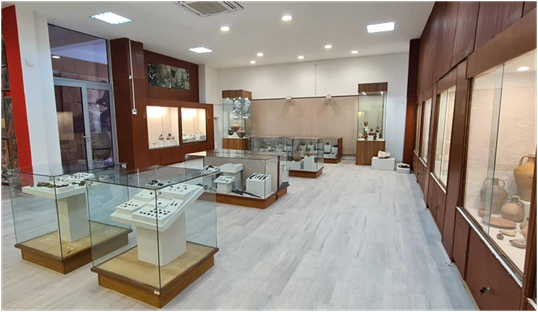

Today, this space houses the ethnological-wine exhibition, while the Lapidarium, containing part of the collection of plastic rocks of the MI City Museum of Negotino, is located in the bottom level of the museum.
THE ARCHAEOLOGICAL PERMANENT EXHIBITION covers an area of 200 m2, where archaeological objects which were found in archaeological sites in the municipality of Negotino are exhibited. They represent the period of prehistory, early antiquity, antiquity, late antiquity and the middle Ages through various objects which were made from ceramics, metal, glass, wood etc.
The ETHNOLOGICAL PERMANENT EXHIBITION displays the material and spiritual culture of the settlements in the municipality of Negotino and the city of Negotino, featuring numerous folk costumes, household items and agricultural artefacts present in this region, dating from the beginning of the 18th until the end of the 20th century.
This includes various items, some of which have been exhibited, such as various jugs, round baking trays, cauldron pots, small jugs, and spinning wheels, round floor tables, shears, calabash bowls, wide-mouth clay jugs, pitchers, mortars, three-legged stools, a sewing machine, carpets, fabrics and many other ethnological items.

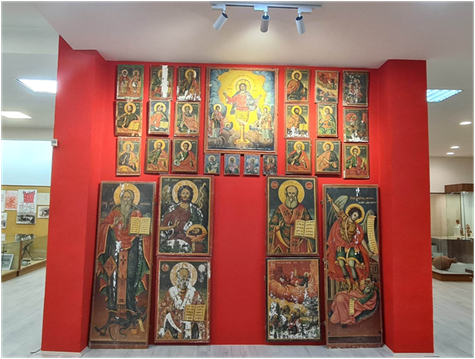
THE FINE ARTS EXHIBITION SALON... Throughout its work, the MI City Museum of Negotino has valorised a collection of art works, and in the future, the museum will continue to organize art exhibitions and enrich the collection of art works by renowned artists through their purchase.
THE GALLERY OF ICONS in the Museum of the city of Negotino consists of icons from the “Saint Prophet Ilija” Church in the village оf Veshe. They are displayed in the exhibition space for permanent exhibitions.
spa+1 day Macedonian Evening tour
Macedonia has five significant features that make it known to tourists – long history, beautiful nature, hospitality, food/drinks and folklore. The purpose of this program is to introduce the guests to the traditions of the Macedonian population, particularly from the perspective of gastronomy, old dances and music. In a wonderful ambiance, surrounded by nature, entertained by the ensemble members, you will have a unique opportunity to learn some basics of the dance, known by every citizen of this small country. Above all, the Macedonian evening will offer you an opportunity to taste the delicious specialties of the old cuisine.

Macedonia is the land of peppers – with approximately 2,000 recipes including peppers, beans, cabbage, water melon, grapes, cherries and apples. Macedonia is proud to have the best eggplant in the world and the purest, ecological yellow cheese. In addition, Macedonia has a renowned wine region, which provides the guests with an opportunity to taste various sorts of wine and rakija (grape brandy). The guests will also be able to enjoy in and learn about instruments typically played in this region – zurla, drum, bagpipe, accordion, violin, flute, tambourine. Members of the folk dances ensemble, dressedin traditional costumes will perform dances to the well-known Macedonian measure 7/8, 9/8, 11/8, 13/8. At the end, the dancers will offer assistance to every guest to take the opportunity and learn the oro – Macedonian dance, or the so called crab walk (three steps forward, one backward).
Tour Organizes by:
Tel: +389 46 250 745
E-mail: [email protected]
spa+1 day Macedonian Evening tour
Macedonia has five significant features that make it known to tourists – long history, beautiful nature, hospitality, food/drinks and folklore. The purpose of this program is to introduce the guests to the traditions of the Macedonian population, particularly from the perspective of gastronomy, old dances and music. In a wonderful ambiance, surrounded by nature, entertained by the ensemble members, you will have a unique opportunity to learn some basics of the dance, known by every citizen of this small country. Above all, the Macedonian evening will offer you an opportunity to taste the delicious specialties of the old cuisine.

Macedonia is the land of peppers – with approximately 2,000 recipes including peppers, beans, cabbage, water melon, grapes, cherries and apples. Macedonia is proud to have the best eggplant in the world and the purest, ecological yellow cheese. In addition, Macedonia has a renowned wine region, which provides the guests with an opportunity to taste various sorts of wine and rakija (grape brandy). The guests will also be able to enjoy in and learn about instruments typically played in this region – zurla, drum, bagpipe, accordion, violin, flute, tambourine. Members of the folk dances ensemble, dressedin traditional costumes will perform dances to the well-known Macedonian measure 7/8, 9/8, 11/8, 13/8. At the end, the dancers will offer assistance to every guest to take the opportunity and learn the oro – Macedonian dance, or the so called crab walk (three steps forward, one backward).
Tour Organizes by:
Tel: +389 46 250 745
E-mail: [email protected]
spa+1day Macedonian Evening tour
Macedonia has five significant features that make it known to tourists – long history, beautiful nature, hospitality, food/drinks and folklore. The purpose of this program is to introduce the guests to the traditions of the Macedonian population, particularly from the perspective of gastronomy, old dances and music. In a wonderful ambiance, surrounded by nature, entertained by the ensemble members, you will have a unique opportunity to learn some basics of the dance, known by every citizen of this small country. Above all, the Macedonian evening will offer you an opportunity to taste the delicious specialties of the old cuisine.

Macedonia is the land of peppers – with approximately 2,000 recipes including peppers, beans, cabbage, water melon, grapes, cherries and apples. Macedonia is proud to have the best eggplant in the world and the purest, ecological yellow cheese. In addition, Macedonia has a renowned wine region, which provides the guests with an opportunity to taste various sorts of wine and rakija (grape brandy). The guests will also be able to enjoy in and learn about instruments typically played in this region – zurla, drum, bagpipe, accordion, violin, flute, tambourine. Members of the folk dances ensemble, dressedin traditional costumes will perform dances to the well-known Macedonian measure 7/8, 9/8, 11/8, 13/8. At the end, the dancers will offer assistance to every guest to take the opportunity and learn the oro – Macedonian dance, or the so called crab walk (three steps forward, one backward).
Tour Organizes by:
Tel: +389 46 250 745
E-mail: [email protected]
spa+1 day Bitola - The city of Consuls tour
The old name of Bitola is Monastir – a place to stay overnight. This is a city of long history, witnesses of which are the remains of Heraclea Lyncestis situated on the ancient Roman road Via Egnatia. Over the centuries, it has always been an important commercial center. During the Ottoman Empire era this city becomes an important administrative and diplomatic center with quite a few European consuls. Bitola reached its peak of prosperity in the 19 century, and today it is an important city of about 100,000 population, situated in the southwest of Macedonia.
Departure from the hotel after breakfast (you will be notified about the exact time by our agent/host and it will also be posted on our info-board). Full day excursion.
Program
The road to Bitola will take us through the villages of Leskoec, Kosel through the city of Resen, along the way we are going to have break for coffee and refreshments. When we arrive in Bitola, first we are going to visit the ancient city of Heraclea built by the Macedonian Emperor Philip II, father of Alexander the Great. This is a special opportunity to see one of the mosaics in this part of the world, as well as the ancient theater, many Roman statues, Early Christian basilicas etc.

Then we go to the center of Bitola where we are going to see the archaeological finds at the National Museum, where a separate room is dedicated to Mustafa Kemal Ataturk – 1881 - 1938, father of modern Turkey. His family was of Macedonian origin. Lunch will be served at a traditional Macedonian restaurant and will take about an hour. We then continue through the center of Bitola, along the celebrated Shirok Sokak (Broad Alley), which will bring us back in time, when the city was part of the Ottoman Empire. Many building will rightfully capture our attention, such as the old Turkish Shopping Street, Isak Pasha Mosque, Yeni (New) Mosque and the Clock Tower, the church of St. Dimitrija, the Catholic Church. We depart from Bitola and head towards Lake Prespa. The asphalt road will take us through sensational nature, to the village of Podmocani, where you will be able to visit the Ethnological Museum that has 120 types of folk costumes in its possession.

Following the visit to the Museum, we set off for the village of Stenje where we will have an opportunity to take a few photos and see the place where pelicans nest. After the short break, we continue towards the top of Mount Galicica, from where you can admire the Lake Prespa and the surrounding magnificent nature. We are going to take a short break for photography and then we cross the highest point on our road and the wonderful view of Lake Ohrid and its surroundings opens out broadly in front of us.
We are stopping briefly at the highest road bend where you have a view of Lake Ohrid – something that will leave you speechless, then the National Park Galicica and Lake Prespa – an ecological lake shared by three countries. We return to the hotel once the program is completed.
Tour Organized by:
Tel: +389 46 250 745
E-mail: [email protected]
spa+Ethno city festival July 20th - August 15th
The "Krushevo ethno city" festival is one of Macedonia's prime tourist attractions. It is held every summer in July-August, in celebration of the traditions and customs of Krushevo.

The "Krushevo ethno city" festival held for 10 days every summer is great way to preserve many old customs and traditions by the natives of Krushevo. In the middle of the summer, this unique event includes hundreds of participants dressed in traditional costumes as insurgents and Ottomans, parading around Krushevo, in commemoration of the anniversary of the Ilinden uprising that took place on 2nd of August, 1903. Apart from the main procession, there's also other events happening at the same time during this unique festival, such as art exhibitions, concerts and other cultural and sport performances.
spa+Ethno city festival July 20th - August 15th
The "Krushevo ethno city" festival is one of Macedonia's prime tourist attractions. It is held every summer in July-August, in celebration of the traditions and customs of Krushevo.

The "Krushevo ethno city" festival held for 10 days every summer is great way to preserve many old customs and traditions by the natives of Krushevo. In the middle of the summer, this unique event includes hundreds of participants dressed in traditional costumes as insurgents and Ottomans, parading around Krushevo, in commemoration of the anniversary of the Ilinden uprising that took place on 2nd of August, 1903. Apart from the main procession, there's also other events happening at the same time during this unique festival, such as art exhibitions, concerts and other cultural and sport performances.
bug+1 day Bitola - The city of Consuls tour
The old name of Bitola is Monastir – a place to stay overnight. This is a city of long history, witnesses of which are the remains of Heraclea Lyncestis situated on the ancient Roman road Via Egnatia. Over the centuries, it has always been an important commercial center. During the Ottoman Empire era this city becomes an important administrative and diplomatic center with quite a few European consuls. Bitola reached its peak of prosperity in the 19 century, and today it is an important city of about 100,000 population, situated in the southwest of Macedonia.
Departure from the hotel after breakfast (you will be notified about the exact time by our agent/host and it will also be posted on our info-board). Full day excursion.
Program
The road to Bitola will take us through the villages of Leskoec, Kosel through the city of Resen, along the way we are going to have break for coffee and refreshments. When we arrive in Bitola, first we are going to visit the ancient city of Heraclea built by the Macedonian Emperor Philip II, father of Alexander the Great. This is a special opportunity to see one of the mosaics in this part of the world, as well as the ancient theater, many Roman statues, Early Christian basilicas etc.

Then we go to the center of Bitola where we are going to see the archaeological finds at the National Museum, where a separate room is dedicated to Mustafa Kemal Ataturk – 1881 - 1938, father of modern Turkey. His family was of Macedonian origin. Lunch will be served at a traditional Macedonian restaurant and will take about an hour. We then continue through the center of Bitola, along the celebrated Shirok Sokak (Broad Alley), which will bring us back in time, when the city was part of the Ottoman Empire. Many building will rightfully capture our attention, such as the old Turkish Shopping Street, Isak Pasha Mosque, Yeni (New) Mosque and the Clock Tower, the church of St. Dimitrija, the Catholic Church. We depart from Bitola and head towards Lake Prespa. The asphalt road will take us through sensational nature, to the village of Podmocani, where you will be able to visit the Ethnological Museum that has 120 types of folk costumes in its possession.

Following the visit to the Museum, we set off for the village of Stenje where we will have an opportunity to take a few photos and see the place where pelicans nest. After the short break, we continue towards the top of Mount Galicica, from where you can admire the Lake Prespa and the surrounding magnificent nature. We are going to take a short break for photography and then we cross the highest point on our road and the wonderful view of Lake Ohrid and its surroundings opens out broadly in front of us.
We are stopping briefly at the highest road bend where you have a view of Lake Ohrid – something that will leave you speechless, then the National Park Galicica and Lake Prespa – an ecological lake shared by three countries. We return to the hotel once the program is completed.
Tour Organized by:
Tel: +389 46 250 745
E-mail: [email protected]
bug+1day Macedonian Evening tour
Macedonia has five significant features that make it known to tourists – long history, beautiful nature, hospitality, food/drinks and folklore. The purpose of this program is to introduce the guests to the traditions of the Macedonian population, particularly from the perspective of gastronomy, old dances and music. In a wonderful ambiance, surrounded by nature, entertained by the ensemble members, you will have a unique opportunity to learn some basics of the dance, known by every citizen of this small country. Above all, the Macedonian evening will offer you an opportunity to taste the delicious specialties of the old cuisine.

Macedonia is the land of peppers – with approximately 2,000 recipes including peppers, beans, cabbage, water melon, grapes, cherries and apples. Macedonia is proud to have the best eggplant in the world and the purest, ecological yellow cheese. In addition, Macedonia has a renowned wine region, which provides the guests with an opportunity to taste various sorts of wine and rakija (grape brandy). The guests will also be able to enjoy in and learn about instruments typically played in this region – zurla, drum, bagpipe, accordion, violin, flute, tambourine. Members of the folk dances ensemble, dressedin traditional costumes will perform dances to the well-known Macedonian measure 7/8, 9/8, 11/8, 13/8. At the end, the dancers will offer assistance to every guest to take the opportunity and learn the oro – Macedonian dance, or the so called crab walk (three steps forward, one backward).
Tour Organizes by:
Tel: +389 46 250 745
E-mail: [email protected]
bug+1 day Macedonian Evening tour
Macedonia has five significant features that make it known to tourists – long history, beautiful nature, hospitality, food/drinks and folklore. The purpose of this program is to introduce the guests to the traditions of the Macedonian population, particularly from the perspective of gastronomy, old dances and music. In a wonderful ambiance, surrounded by nature, entertained by the ensemble members, you will have a unique opportunity to learn some basics of the dance, known by every citizen of this small country. Above all, the Macedonian evening will offer you an opportunity to taste the delicious specialties of the old cuisine.

Macedonia is the land of peppers – with approximately 2,000 recipes including peppers, beans, cabbage, water melon, grapes, cherries and apples. Macedonia is proud to have the best eggplant in the world and the purest, ecological yellow cheese. In addition, Macedonia has a renowned wine region, which provides the guests with an opportunity to taste various sorts of wine and rakija (grape brandy). The guests will also be able to enjoy in and learn about instruments typically played in this region – zurla, drum, bagpipe, accordion, violin, flute, tambourine. Members of the folk dances ensemble, dressedin traditional costumes will perform dances to the well-known Macedonian measure 7/8, 9/8, 11/8, 13/8. At the end, the dancers will offer assistance to every guest to take the opportunity and learn the oro – Macedonian dance, or the so called crab walk (three steps forward, one backward).
Tour Organizes by:
Tel: +389 46 250 745
E-mail: [email protected]
bug+1 day Macedonian Evening tour
Macedonia has five significant features that make it known to tourists – long history, beautiful nature, hospitality, food/drinks and folklore. The purpose of this program is to introduce the guests to the traditions of the Macedonian population, particularly from the perspective of gastronomy, old dances and music. In a wonderful ambiance, surrounded by nature, entertained by the ensemble members, you will have a unique opportunity to learn some basics of the dance, known by every citizen of this small country. Above all, the Macedonian evening will offer you an opportunity to taste the delicious specialties of the old cuisine.

Macedonia is the land of peppers – with approximately 2,000 recipes including peppers, beans, cabbage, water melon, grapes, cherries and apples. Macedonia is proud to have the best eggplant in the world and the purest, ecological yellow cheese. In addition, Macedonia has a renowned wine region, which provides the guests with an opportunity to taste various sorts of wine and rakija (grape brandy). The guests will also be able to enjoy in and learn about instruments typically played in this region – zurla, drum, bagpipe, accordion, violin, flute, tambourine. Members of the folk dances ensemble, dressedin traditional costumes will perform dances to the well-known Macedonian measure 7/8, 9/8, 11/8, 13/8. At the end, the dancers will offer assistance to every guest to take the opportunity and learn the oro – Macedonian dance, or the so called crab walk (three steps forward, one backward).
Tour Organizes by:
Tel: +389 46 250 745
E-mail: [email protected]
Етно фестивали
The "Krushevo ethno city" festival is one of Macedonia's prime tourist attractions. It is held every summer in July-August, in celebration of the traditions and customs of Krushevo.

The "Krushevo ethno city" festival held for 10 days every summer is great way to preserve many old customs and traditions by the natives of Krushevo. In the middle of the summer, this unique event includes hundreds of participants dressed in traditional costumes as insurgents and Ottomans, parading around Krushevo, in commemoration of the anniversary of the Ilinden uprising that took place on 2nd of August, 1903. Apart from the main procession, there's also other events happening at the same time during this unique festival, such as art exhibitions, concerts and other cultural and sport performances.
alb+1 day Macedonian Evening tour
Macedonia has five significant features that make it known to tourists – long history, beautiful nature, hospitality, food/drinks and folklore. The purpose of this program is to introduce the guests to the traditions of the Macedonian population, particularly from the perspective of gastronomy, old dances and music. In a wonderful ambiance, surrounded by nature, entertained by the ensemble members, you will have a unique opportunity to learn some basics of the dance, known by every citizen of this small country. Above all, the Macedonian evening will offer you an opportunity to taste the delicious specialties of the old cuisine.

Macedonia is the land of peppers – with approximately 2,000 recipes including peppers, beans, cabbage, water melon, grapes, cherries and apples. Macedonia is proud to have the best eggplant in the world and the purest, ecological yellow cheese. In addition, Macedonia has a renowned wine region, which provides the guests with an opportunity to taste various sorts of wine and rakija (grape brandy). The guests will also be able to enjoy in and learn about instruments typically played in this region – zurla, drum, bagpipe, accordion, violin, flute, tambourine. Members of the folk dances ensemble, dressedin traditional costumes will perform dances to the well-known Macedonian measure 7/8, 9/8, 11/8, 13/8. At the end, the dancers will offer assistance to every guest to take the opportunity and learn the oro – Macedonian dance, or the so called crab walk (three steps forward, one backward).
Tour Organizes by:
Tel: +389 46 250 745
E-mail: [email protected]
alb+1 day Macedonian Evening tour
Macedonia has five significant features that make it known to tourists – long history, beautiful nature, hospitality, food/drinks and folklore. The purpose of this program is to introduce the guests to the traditions of the Macedonian population, particularly from the perspective of gastronomy, old dances and music. In a wonderful ambiance, surrounded by nature, entertained by the ensemble members, you will have a unique opportunity to learn some basics of the dance, known by every citizen of this small country. Above all, the Macedonian evening will offer you an opportunity to taste the delicious specialties of the old cuisine.

Macedonia is the land of peppers – with approximately 2,000 recipes including peppers, beans, cabbage, water melon, grapes, cherries and apples. Macedonia is proud to have the best eggplant in the world and the purest, ecological yellow cheese. In addition, Macedonia has a renowned wine region, which provides the guests with an opportunity to taste various sorts of wine and rakija (grape brandy). The guests will also be able to enjoy in and learn about instruments typically played in this region – zurla, drum, bagpipe, accordion, violin, flute, tambourine. Members of the folk dances ensemble, dressedin traditional costumes will perform dances to the well-known Macedonian measure 7/8, 9/8, 11/8, 13/8. At the end, the dancers will offer assistance to every guest to take the opportunity and learn the oro – Macedonian dance, or the so called crab walk (three steps forward, one backward).
Tour Organizes by:
Tel: +389 46 250 745
E-mail: [email protected]
alb+1day Macedonian Evening tour
Macedonia has five significant features that make it known to tourists – long history, beautiful nature, hospitality, food/drinks and folklore. The purpose of this program is to introduce the guests to the traditions of the Macedonian population, particularly from the perspective of gastronomy, old dances and music. In a wonderful ambiance, surrounded by nature, entertained by the ensemble members, you will have a unique opportunity to learn some basics of the dance, known by every citizen of this small country. Above all, the Macedonian evening will offer you an opportunity to taste the delicious specialties of the old cuisine.

Macedonia is the land of peppers – with approximately 2,000 recipes including peppers, beans, cabbage, water melon, grapes, cherries and apples. Macedonia is proud to have the best eggplant in the world and the purest, ecological yellow cheese. In addition, Macedonia has a renowned wine region, which provides the guests with an opportunity to taste various sorts of wine and rakija (grape brandy). The guests will also be able to enjoy in and learn about instruments typically played in this region – zurla, drum, bagpipe, accordion, violin, flute, tambourine. Members of the folk dances ensemble, dressedin traditional costumes will perform dances to the well-known Macedonian measure 7/8, 9/8, 11/8, 13/8. At the end, the dancers will offer assistance to every guest to take the opportunity and learn the oro – Macedonian dance, or the so called crab walk (three steps forward, one backward).
Tour Organizes by:
Tel: +389 46 250 745
E-mail: [email protected]
alb+1 day Bitola - The city of Consuls tour
The old name of Bitola is Monastir – a place to stay overnight. This is a city of long history, witnesses of which are the remains of Heraclea Lyncestis situated on the ancient Roman road Via Egnatia. Over the centuries, it has always been an important commercial center. During the Ottoman Empire era this city becomes an important administrative and diplomatic center with quite a few European consuls. Bitola reached its peak of prosperity in the 19 century, and today it is an important city of about 100,000 population, situated in the southwest of Macedonia.
Departure from the hotel after breakfast (you will be notified about the exact time by our agent/host and it will also be posted on our info-board). Full day excursion.
Program
The road to Bitola will take us through the villages of Leskoec, Kosel through the city of Resen, along the way we are going to have break for coffee and refreshments. When we arrive in Bitola, first we are going to visit the ancient city of Heraclea built by the Macedonian Emperor Philip II, father of Alexander the Great. This is a special opportunity to see one of the mosaics in this part of the world, as well as the ancient theater, many Roman statues, Early Christian basilicas etc.

Then we go to the center of Bitola where we are going to see the archaeological finds at the National Museum, where a separate room is dedicated to Mustafa Kemal Ataturk – 1881 - 1938, father of modern Turkey. His family was of Macedonian origin. Lunch will be served at a traditional Macedonian restaurant and will take about an hour. We then continue through the center of Bitola, along the celebrated Shirok Sokak (Broad Alley), which will bring us back in time, when the city was part of the Ottoman Empire. Many building will rightfully capture our attention, such as the old Turkish Shopping Street, Isak Pasha Mosque, Yeni (New) Mosque and the Clock Tower, the church of St. Dimitrija, the Catholic Church. We depart from Bitola and head towards Lake Prespa. The asphalt road will take us through sensational nature, to the village of Podmocani, where you will be able to visit the Ethnological Museum that has 120 types of folk costumes in its possession.

Following the visit to the Museum, we set off for the village of Stenje where we will have an opportunity to take a few photos and see the place where pelicans nest. After the short break, we continue towards the top of Mount Galicica, from where you can admire the Lake Prespa and the surrounding magnificent nature. We are going to take a short break for photography and then we cross the highest point on our road and the wonderful view of Lake Ohrid and its surroundings opens out broadly in front of us.
We are stopping briefly at the highest road bend where you have a view of Lake Ohrid – something that will leave you speechless, then the National Park Galicica and Lake Prespa – an ecological lake shared by three countries. We return to the hotel once the program is completed.
Tour Organized by:
Tel: +389 46 250 745
E-mail: [email protected]
Resen
La ville des potiers et des pommes La Macédoine est connue pour les pommes de Resen
Selon les dernières recherches, la région de Prespa a des conditions climatiques excellentes d’élevage de différentes sortes de pommes. L’élevage des pommes est une tradition longue dans cette région. A l’occasion du début de cueillette des pommes, le 27 septembre (Fête de la Croix Glorieuse), la manifestation traditionnelle la cueillette des pommes de Prespa a lieu. Rouge ou jaune, la pomme attire grâceà son goût et senteur, elle est utilisée notamment pour la production de jus. Selon certaines estimations, le revenu annuel est environ 80.000t de pommes consumables, produitesdans la région de Prespa. Les nouvelles sortes de pommes « pinova » et « gala » sont les favoris du marchéEuropéen exigeant.
Resen est le quartier central de la vallée. La ville aune position géographique et circulaire relativement bonne. Par Resen passe la route magistrale de Durrës par Tirana et Ohrid jusqu’à Bitola.La communication avec Grèce est réalisée par DolnoDupeni et avec Albanie parStenje.
Le quartier est mentionné sous le nom de Resan pour la première fois dans une charte du Tsar Dushan en 1337. Vers la fin de XVIIIèmesièclecommença le développement de l’artisanat (poterie) et du commerce. Ainsi ildevint économiquementfort, Resen Bazar fut formé et le quartier grandit en centre économique de Prespa. Au début de XIXèmesiècleil obtient le statut de ville et centre administratif.
Resen connut le progrès économique et la croissance de la population après la Deuxième Guerre mondiale. La croissance de la population est stable respectivement de 4.737 habitants en 1948 à 9.000 habitants en 2002. Cela est dû à la migration de la population des quartiers voisins de la vallée de Prespa. Notamment,Resen est le seul quartier dans la vallée ayant connu la croissance de la population car la vallée de Prespa est marquée comme une région d’émigration vers les pays océaniens. Outre les pommes, la ville est connue pour ses capacités industrielles telles que l’industrie alimentaire et métallique.
Aujourd’hui, Resen est une petite ville moderne ayant le rôle de centre économique, sanitaire, culturel – éducatif et administratif des villes de la vallée de Prespa.

Le Saraï de Resen
Le château d’Ahmed Niyazi Bey à Resen est un objet de valeurs esthétiques et fonctionnelles élevées et il est considéré comme un des exemples les plus importants de l’architecture du début de XXème siècle avec des éléments des styles européens de l’architecture. Il fut construit dans la période de 1905 à 1909. Le toit est rénové en 1982 et restauré en 2005 grâce au support de la Banque mondiale. Cet objet est fascinant par sa hauteur de 25m et superficie de 4.800 m2 d’espace intérieur. Pour l’intérieur sont utilisés des matériaux sophistiqués de haute qualité. Aujourd’hui, le Saraï accueille la Maison de la Culture “Dragi Toziya”, l’exhibition permanente des travaux de l’artiste KeratsaVisoultcheva et la galerie de la Colonie de potiers de Resen.
La légende de Saraï
L’initiateur de la construction, Ahmed Niyazi Bey, étudiant de l’Académie militaire à Istanbul et membre du mouvement Jeune-Turque fut envoyé à Resenoù il reçut une carte postale de Versailles et son château de son ami demeurant à Paris. Alors, le riche bey de Resen a décidé de construire un objet pareil comme sa résidence. Il est assassiné en 1912 à Durrës avant que le château soit complètement terminé.
L’église Saint-Georges, Kurbinovo (XIIème siècle)
L’église deKurbinovo,avec ses fresques extraordinairesdatant de 1191, représente une des plusieurs perles de la peinture médiévale en Macédoine.
Le temps de la peinture des fresques et la construction de l’église est connu par l’inscription dédicatoire en grecque au côté nord. Les fresques de cette petite église sont de qualité exceptionnelle, datant de l’époque de l’art comnène qui domine en Macédoine jusqu’à la fin de XIIIème siècle. Au côté ouest on remarque des vestiges des fresques avec des représentations du corps des hommes et des femmesen entier, habillés en vêtement royaux ainsi qu’une figure dudignitaire de l'église. Il s’agit probablement des personnes qui ont bâti l’église primitive. La peinture à fresque est composée des représentations bibliques du Seigneur Jésus-Christ et Notre Dame.
La peinture murale – Les fresques de Kurbinovo sont considérées commeétant parmi les plus belles, les plus originales et complètement sauvegardées,datant du XIème siècle. La création des maîtresinconnus à Kurbinovo représente la continuité de la création des maîtresde Nerezi bien que l’originalité du style et de l’expression est bien évidente. Conceptuellement les fresques sont divisées en trois zones : dans la première zone sont présentées des représentations individuelles des saints en corps entier, le cycle des fêtes majeures dans la deuxième zone et les prophètes dans la troisième zone.
La Colonie de potiers à Resen – La poterie est une partie du riche environnement culturel, avec son propre contexte historique
La tradition de la poterie est passée de génération en génération. La première session de la Colonie de potiersdeResen adébutée en 1973 à Oteshevo au bord du lac de Prespa. Durant les décenniespassées environ 200 participants ont laissé plus de 800 travauxet 300 d’entre eux peuvent être vus dans la galerie permanente du saraï.L’exhibition est officiellement ouverte en 1983 et après 1991 l’espace est élargi et par conséquent le nombre de nouvelles créationsexposéesaugmente après chaque session annuelle. La colonie est développée en évènement artistique international, faisant contact avec des centres culturels et des galeries éminents du monde entier.
Musée ethnologique de Podmochani – Une des collection ethnologique les plus riches en Macedoine
Le musée ethnologique, joliment décoré, capture l’attention des visiteurs du village de Podmochani. Une collection d’éléments folklorique rare et impressive de la vie dans cette région y est installée. Plus de 2.000 détails artistiques de la fin du XIXème et du début de XXème siècle sont exposés : des exemplaires merveilleux de bijoux, armes, vieilles monnaies et plus de 160 costumes traditionnelsde différentes régions de Macédoine.
Krushevo
KRUSHEVO ETNO CITTÀ
Questo festival rappresenta un’ottima possibilità di godere l’ospitalità della città di Krushevo contemporanea richiamando lo spirito delle tradizioni del 1903. Per le vie della città sfilano i partecipanti vestiti da insorti, voivoda, in costumi tradizionali o in divise di soldati otomani. Tutte le vetrine, cartelloni, facciate delle case di Krushevo portano il segno dello stile etnico e l’atmosfera viene arricchita da tanti negozianti, baristi e gente di servizio vestiti proprio in costumi tradizionali.
Si presentano simulazioni di lotte tra insorti ed esercito turco, si fa fusione di pallottole nella fonderia risalente al periodo della rivolta di Ilinden, si fanno esibizioni dei manufatti e si vendono dei souvenir. Ambientata nell’autenticità civile, la visita di Krushevo durante questa “ Rivolta turistica” è un raro spettacolo offerto ai visitatori incuriositi.

COSTUMI
Con tutta la loro ricchezza espressa attraverso la numerosità e varietà dei vestiti e il modo della loro decorazione, i costumi fanno parte importante della cultura materiale della poplazione macedone con una tradizione antica. Tra le forme più semplici di decorazione dei costumi è proprio quella fatta da mezzi presi dalla natura più vicina (basilico, narcisi selvatici) e le giovani spose portavano al capo una corona di edera o un mazzo di fiori. La decorazione più impressionante delle donne macedoni erano i decori di vecchie monete la cui comparsa viene collegata all’inizio degli scambi commerciali nei villaggi macedoni.
Le monete di metallo e i gioielli si usavano messe sulle trecce dei capelli , applicate ad un pezzo di tessuto oppure ordinate come scaglie di pesce come grandi decori che le donne portavano al petto. Molti decori di questo tipo sono collegati alla produzione artigianale.
RICAMATURA
La caratteristica principale del costume tradizionale macedone è il ricamo con decori ampi e geometrici, filo argenteo e trecce, nonche’ gioielli realizzati in metallo, argento, perline o frutti di natura. Come un decoro particolare specialmente ai costumi femminili si ricamavano le camicie e i cappelli.
Le ricamature si sviluppavano e curavano su tutto il territorio della Macedonia. Tra i colori è dominante il colore rosso, ma sono presenti anche il verde, il giallo e il blù scuro.
Una particolarità dei ricami macedoni sono i ricami molto densi e e gli ornamenti a motivi specifici. Il ricamo popolare macedone è un vero testimone della originalità creativa del suo creatore- la donna macedone.
IL FOLCLORE MACEDONE
L’elemento più riconoscibile del folclore macedone sono i balli tradizionali chiamati “oro” le quali sono differenti in diverse parti della Macedonia, partendo dallo stile, la coreografia e le tradizioni collegate ad essi. Possono essere aperti o chiusi e coloro che li ballano si tengono per mani, spalle, vita, sotto braccio o con le mani capovolte in giù. Tutti i danzatori ballano allo stesso modo tranne il primo e l’ultimo, i quali possono eseguire anche altri passi e movimenti. I balli tradizionali si ballano di solito a destra, ma ce ne sono anche danzi che vengono ballati a sinistra.
I danzi macedoni più conosciuti sono: “pravo”, “pajdushko”, “eleno mome” “chupurliga”. Sia i danzi che la musica macedone abbondano di ritmi complessi , di cui i più frequenti sono quelli di 2/4 е 7/8. Nella maggioranza dei danzi c’è anche il cambiamento del ritmo da lento a veloce. Le canzioni tradizionali popolari con cui i macedoni si identificano sono: “ Kalesh bre Angjo”, “Slusham kaj shumat shumite”, “Biljana platno beleshe” “ Dafino vino crveno”, “Narode Makedonski”, “ Zemjo Makedonska” e tante altre.
Cose da visitare a Krushevo
Cose da fare in Krushevo
Clicca qui per Krushevo visite guidate della città
Clicca qui per visualizzare l'elenco dei Krushevo Guide Turistiche
ita+Struga
Struga
The main characteristics of the tourism in the Municipality of Struga are: relatively favorable geographic positioning and relatively developed road infrastructure, mild continental climate with high level of sun insolation during the whole year, extraordinary fund of endemic species of flora and fauna, protected and preserved natural habitat, rich cultural and historic heritage with a considerable number of monuments and archeological sites, mountain ranges favorable for winter tourism, traditional welcome and folklore, healthy and traditional food consuming, unique cultural manifestations, Struga is situated in the southwestern part of the Republic of Macedonia, on the shorelines of the Lake Ohrid and alongside the banks of the River Black Drim that divides the city into two.


Struga is well linked and easily accessible with the neighboring regions: only 14 km away from the border with the Republic of Albania, 160 km with the Republic of Kosova (from Tetovo) or 190 km in the North (from Skopje), 100 km from the Republic of Greece, 290 km from the Republic of Bulgaria and 230 from the border with the Republic of Serbia. The International Airport only 9 km away connects Struga with the rest part of the world.
Struga has a surface of 573 km2and lies at 698 meters above sea level; there are 63376 inhabitants, 130 inhabitants/ km2, in 50 settlements. Maximum average temperatures reach 27 degrees centigrade in July and August, but in the warmest days of the summer they reach out to 35-40 degrees centigrade. Average temperature of the water of the lake Ohrid in summer is 26 degrees centigrade, while the temperature throughout the year reaches up to around 12 degrees centigrade. In the winter, average temperature is above 0 degrees centigrade, making thus a comfortable and pleasant environment to be accommodated and stay in this time of the season. The average days with relatively high temperatures reach to 80 days in the year, accompanied by intensively high temperatures in July and August. The insolation in Struga is very high, with 2,200 hours of insolation, Struga is one of brightest places in the Republic of Macedonia.
NATURAL RICHIES OF STRUGA
The Lake of Ohrid lies at an altitude of 695 meters above sea level and occupies an area of 348,2 km², from which 230 km² are on the side of the Republic of Macedonia and the rest of 118,2 km² belong to the Republic of Albania. The cost line of the lake is 87,5 km long. The average depth of the lake is 164 meters and the maximum depth of the lake is 289 meters, with a high transparency that reaches up to 24 meters. The Lake is characterized with a very unique ecosystem consisted of a rich world of flora and fauna that is very rare. The biodiversity of the lake and the trails of very old settlements and prehistoric civilizations that have existed here made possible for Lake Ohrid to be listed and constantly protected by the UNESCO as a cultural heritage of planetary proportions.
The River Black Drim is the only exit of the lake’s water. As it flows in the north, the river creates the two artificial lakes: Lake Globochitza and Lake Shpile. The eels found in the Lake Ohrid, through the river, pass seas and oceans on their “honeymoon” to arrive to the Sargasso Sea, where they meet their partners and breed.


The Yablanitsa Mountain is one the most important mountain ranges in Macedonia because of the rich flora and fauna. On the slopes of this mountain lie panoramic villages. Today, there are some initiatives to declare the mountain range as a national park. Glacial lakes on the Yablanitsa Mountain are situated more than 2000 meters above sea level with breathtaking views of Struga and the Lake Ohrid. Artificial lake of Shum in situated in the village of Shum only 6 km away from the city of Struga. The uniqueness of this lake is the breeding of the Lake Ohrid trout.
Flora in the region of Struga is characterized with a unique and endemic living world that cannot be found in any other places in the world (lake reeds, oak hills and forests, beech, chestnuts, curative flora, ornamental flora and different mountain mushroom species). Fauna also is characterized with endemic forms of life and endangered species like mountain bears, wolves, dears, wild lynx, goats and lake swans, ducks and gooses.
The admirers of nature have the opportunity to visit the tourist villages of Vishni, Upper Belitza, Labunishta and Podgortsi to feel the breathtaking views of the Lake Ohrid in over 2000 meters above sea level, the glacial lakes, mountain springs and meadows during the winter season fulfilled with snow, in spring with flowers, in summer with green colors and in gilded autumns. The admirers of the deep blue color of Lake Ohrid can relax in the fishermen villages of Kalishta and Radozhda.
CULTURAL AND HISTORIC RICHIES OF STRUGA
As a result of the natural conditions and the strategic geo-politic position between West and East, Struga and its surroundings have been continuously populated and featured a cradle of ancient civilization. Archeological findings bear witness that near the mouth of the river Black Drim was established the ancient city of Enchalon.
The “Via Egnatia” penetrated in the region of Struga, more precisely, passed through the village of Radozhda, Struga. Inside the church of St. George in Struga was found a millennium stone “Egnatia” on which is written the name of the Roman emperor Karakalus (211-217 B.C.) and the distance of 12 km dividing Struga from Ohrid.
The most known temples of the Christian religion are: the church of St. George of the city of Struga, the church complex near Kalishta, from the XV century, the church of St. Spas inside a cave in the village of Vishni, from the XV century, the church of St. Archangel Michael in Radozhda, from the XI century.
The most representative temples of the Islamic religion in Struga are the mosques and a teke: the Mosque of Suleiman Arap built in 1583, near the river Black Drim, the Mosque of Mustafa Celebi near the city centre, built in the late XV century, the Teke of Helveti, built by Baba Hasan in the XVIII century and the Hamam of Mustafa as a representative of the rarest Turkish monuments built in the years when the Ottomans came to Struga.
The Natural Scientific Museum “Dr. Nikolla Nezllobinski” in Struga is one of the oldest institutions in Macedonia and represents a complex institution consisted of several departments as: the Biological Department, Preparatory Lab, Department of Archeology and Figurative Art and the Department of History and Ethnology. In the Museum there is an exhibition of 9,381 specimens of flora and fauna founded in the shores of the Lake Ohrid, about 2,576 items that originate from pre-history, the ancientness, medieval era and items from the contemporary period.


A very important part of the Museum is the art gallery “Vangel Kodzoman” consisted of 35 paintings, a true collection of this artist from Struga. His paintings reflect the dynamic of the living and life in Struga, together with motives from the old city architecture.
The city architecture of the XIX century and the beginning of the XX century in Struga can be noticed from the old houses. The accent should be put to the fact that most of the houses and other buildings of this period are characterized with an architectural harmony and functional emplacement of the interior and exterior elements.
The Festival of refined and styled folk songs and dances “Këngë jeho” takes place in Struga every year in the end of July and in the beginning of August. The festival, established in 1992, for many years has revealed the true cultural and artistic values of the ethnic Albanian soul and the colors of the traditional costumes and dances. The festival presents the traditional values of the cultural artistic associations from Macedonia, Albania, and Kosovo and all over the world.
The “Struga Poetry Evenings”
The “Struga Poetry Evenings” as an international event began in 1966. As a result, the international poetry award “The Golden Wreath” was established, and is awarded to the best poet. For the years passed away, Struga has welcomed and hosted over 4,000 poets, essayists, and well-known critics from 95 different countries all over the world.
“The Review of Folk Costumes” is one of the most important cultural and touristic manifestations that traditionally takes place in Struga in the beginning of August, since 1971. This cultural event aims at presenting the cultural wealth of folk costumes and embroidery from the tradition coming from the tradition of all ethnic communities living in the Struga region. The parade of the participants in the streets of Struga and along the river Black Drim is a special moment and an extraordinary happening for the visitors.
The citizens of Struga can be very proud of the many and old crafts. According to this, we can point out the manufacturers of silver jewelry, hand-made filigree, old-style loom weaving, decorative wood-carving, pottery and many other handicraft shops that are located mainly in the old city bazaar.
The traditional cuisine cherished for centuries in Struga invites you to taste the deliciously prepared eel and trout a lá Struga, fli or dzomleze (national pie) under hot iron pan, pie and beans cooked in earthen pan, baklava and other sweeties.
The accommodation capacities in the Municipality of Struga are: 25 hotels with 4500 rooms and approximately 6000 beds, 10 motels with a capacity of 100 rooms with 250 beds and 200 private guest houses and apartments with 2000 rooms or 4000 beds. Thus, in Struga can be accommodated almost 10.000 tourists a day. In the Municipality of Struga there are 60 restaurants with a traditional and modern cuisine, 50 fast-food and 60 cafés for everybody’s preferences as well as 20 travel agencies that organize the trips for the tourists.

Click here to see Accomodation in Struga
ita+1 day Macedonian Evening tour
Macedonia has five significant features that make it known to tourists – long history, beautiful nature, hospitality, food/drinks and folklore. The purpose of this program is to introduce the guests to the traditions of the Macedonian population, particularly from the perspective of gastronomy, old dances and music. In a wonderful ambiance, surrounded by nature, entertained by the ensemble members, you will have a unique opportunity to learn some basics of the dance, known by every citizen of this small country. Above all, the Macedonian evening will offer you an opportunity to taste the delicious specialties of the old cuisine.

Macedonia is the land of peppers – with approximately 2,000 recipes including peppers, beans, cabbage, water melon, grapes, cherries and apples. Macedonia is proud to have the best eggplant in the world and the purest, ecological yellow cheese. In addition, Macedonia has a renowned wine region, which provides the guests with an opportunity to taste various sorts of wine and rakija (grape brandy). The guests will also be able to enjoy in and learn about instruments typically played in this region – zurla, drum, bagpipe, accordion, violin, flute, tambourine. Members of the folk dances ensemble, dressedin traditional costumes will perform dances to the well-known Macedonian measure 7/8, 9/8, 11/8, 13/8. At the end, the dancers will offer assistance to every guest to take the opportunity and learn the oro – Macedonian dance, or the so called crab walk (three steps forward, one backward).
Tour Organizes by:
Tel: +389 46 250 745
E-mail: [email protected]
ita+1 day Macedonian Evening tour
Macedonia has five significant features that make it known to tourists – long history, beautiful nature, hospitality, food/drinks and folklore. The purpose of this program is to introduce the guests to the traditions of the Macedonian population, particularly from the perspective of gastronomy, old dances and music. In a wonderful ambiance, surrounded by nature, entertained by the ensemble members, you will have a unique opportunity to learn some basics of the dance, known by every citizen of this small country. Above all, the Macedonian evening will offer you an opportunity to taste the delicious specialties of the old cuisine.

Macedonia is the land of peppers – with approximately 2,000 recipes including peppers, beans, cabbage, water melon, grapes, cherries and apples. Macedonia is proud to have the best eggplant in the world and the purest, ecological yellow cheese. In addition, Macedonia has a renowned wine region, which provides the guests with an opportunity to taste various sorts of wine and rakija (grape brandy). The guests will also be able to enjoy in and learn about instruments typically played in this region – zurla, drum, bagpipe, accordion, violin, flute, tambourine. Members of the folk dances ensemble, dressedin traditional costumes will perform dances to the well-known Macedonian measure 7/8, 9/8, 11/8, 13/8. At the end, the dancers will offer assistance to every guest to take the opportunity and learn the oro – Macedonian dance, or the so called crab walk (three steps forward, one backward).
Tour Organizes by:
Tel: +389 46 250 745
E-mail: [email protected]
ita+1day Macedonian Evening tour
Macedonia has five significant features that make it known to tourists – long history, beautiful nature, hospitality, food/drinks and folklore. The purpose of this program is to introduce the guests to the traditions of the Macedonian population, particularly from the perspective of gastronomy, old dances and music. In a wonderful ambiance, surrounded by nature, entertained by the ensemble members, you will have a unique opportunity to learn some basics of the dance, known by every citizen of this small country. Above all, the Macedonian evening will offer you an opportunity to taste the delicious specialties of the old cuisine.

Macedonia is the land of peppers – with approximately 2,000 recipes including peppers, beans, cabbage, water melon, grapes, cherries and apples. Macedonia is proud to have the best eggplant in the world and the purest, ecological yellow cheese. In addition, Macedonia has a renowned wine region, which provides the guests with an opportunity to taste various sorts of wine and rakija (grape brandy). The guests will also be able to enjoy in and learn about instruments typically played in this region – zurla, drum, bagpipe, accordion, violin, flute, tambourine. Members of the folk dances ensemble, dressedin traditional costumes will perform dances to the well-known Macedonian measure 7/8, 9/8, 11/8, 13/8. At the end, the dancers will offer assistance to every guest to take the opportunity and learn the oro – Macedonian dance, or the so called crab walk (three steps forward, one backward).
Tour Organizes by:
Tel: +389 46 250 745
E-mail: [email protected]
ita+1 day Bitola - The city of Consuls tour
The old name of Bitola is Monastir – a place to stay overnight. This is a city of long history, witnesses of which are the remains of Heraclea Lyncestis situated on the ancient Roman road Via Egnatia. Over the centuries, it has always been an important commercial center. During the Ottoman Empire era this city becomes an important administrative and diplomatic center with quite a few European consuls. Bitola reached its peak of prosperity in the 19 century, and today it is an important city of about 100,000 population, situated in the southwest of Macedonia.
Departure from the hotel after breakfast (you will be notified about the exact time by our agent/host and it will also be posted on our info-board). Full day excursion.
Program
The road to Bitola will take us through the villages of Leskoec, Kosel through the city of Resen, along the way we are going to have break for coffee and refreshments. When we arrive in Bitola, first we are going to visit the ancient city of Heraclea built by the Macedonian Emperor Philip II, father of Alexander the Great. This is a special opportunity to see one of the mosaics in this part of the world, as well as the ancient theater, many Roman statues, Early Christian basilicas etc.

Then we go to the center of Bitola where we are going to see the archaeological finds at the National Museum, where a separate room is dedicated to Mustafa Kemal Ataturk – 1881 - 1938, father of modern Turkey. His family was of Macedonian origin. Lunch will be served at a traditional Macedonian restaurant and will take about an hour. We then continue through the center of Bitola, along the celebrated Shirok Sokak (Broad Alley), which will bring us back in time, when the city was part of the Ottoman Empire. Many building will rightfully capture our attention, such as the old Turkish Shopping Street, Isak Pasha Mosque, Yeni (New) Mosque and the Clock Tower, the church of St. Dimitrija, the Catholic Church. We depart from Bitola and head towards Lake Prespa. The asphalt road will take us through sensational nature, to the village of Podmocani, where you will be able to visit the Ethnological Museum that has 120 types of folk costumes in its possession.

Following the visit to the Museum, we set off for the village of Stenje where we will have an opportunity to take a few photos and see the place where pelicans nest. After the short break, we continue towards the top of Mount Galicica, from where you can admire the Lake Prespa and the surrounding magnificent nature. We are going to take a short break for photography and then we cross the highest point on our road and the wonderful view of Lake Ohrid and its surroundings opens out broadly in front of us.
We are stopping briefly at the highest road bend where you have a view of Lake Ohrid – something that will leave you speechless, then the National Park Galicica and Lake Prespa – an ecological lake shared by three countries. We return to the hotel once the program is completed.
Tour Organized by:
Tel: +389 46 250 745
E-mail: [email protected]
Etno festival città
Il festival "Krusevo etno città" è una delle prime attrazioni turistiche di Macedonia. Si tiene ogni estate in luglio-agosto, in occasione delle tradizioni e dei costumi di Krusevo.

Il "Krusevo etno città" festival che si tiene per 10 giorni ogni estate è un ottimo modo per conservare molte vecchie usanze e tradizioni dai nativi di Krusevo. In piena estate, questo evento unico include centinaia di partecipanti in costume tradizionale come insorti e Ottomani, sfilando intorno Krusevo, in commemorazione del anniversario della rivolta di Ilinden che ha avuto luogo il 2 agosto 1903. Oltre al principale processione, ci sono anche altri eventi che accadono nello stesso momento durante questo festival unico, come mostre d'arte, concerti e altri spettacoli culturali e sportivi.
Città Etno Festival di luglio
Il festival "Krusevo etno città" è una delle prime attrazioni turistiche di Macedonia. Si tiene ogni estate in luglio-agosto, in occasione delle tradizioni e dei costumi di Krusevo.

Il "Krusevo etno città" festival che si tiene per 10 giorni ogni estate è un ottimo modo per conservare molte vecchie usanze e tradizioni dai nativi di Krusevo. In piena estate, questo evento unico include centinaia di partecipanti in costume tradizionale come insorti e Ottomani, sfilando intorno Krusevo, in commemorazione del anniversario della rivolta di Ilinden che ha avuto luogo il 2 agosto 1903. Oltre al principale processione, ci sono anche altri eventi che accadono nello stesso momento durante questo festival unico, come mostre d'arte, concerti e altri spettacoli culturali e sportivi.
Traditional Macedonian Clothes
Always closely linked to their native land, the Macedonian people have mostly lived through centuries of tradition transmitting it from one generation to another, and thus creating an unusually rare material and spiritual culture which bears some patriarchal characteristics. True folklore cannot be bought or sold, but has to be learned through toil, sweat, tears, and, sometimes, even blood. Contrary to some who abuse its name for self-serving interests, it is not mere entertainment to amuse the throngs or to pander to an audience.
Rather, it should, as with all true art, stimulate, educate, irritate, and, hopefully, lead all who are touched by it to a new level of insight. At the same time, by its nature folklore is also accessible, not merely to an artistic elite, but to all who pursue it with passion. It will take all of your concentration, creativity, and passionate effort to capture its essence, to add to its richness, and to transmit it undiluted to the next generation so that they, Macedonians and others may yet know its sublime beauty and glory.
Folk costumes
Particular attention Macedonian had paid to the design and decoration of their clothes, so that national costumes and jewellery are the most expressive and the most numerous examples of the traditional creativity of the Macedonians. The national costumes in Macedonia (created over a long period of time), preserved the traces of old cultural influences, and in their way of development fit the elements of old Balkan, Slav and Oriental culture. Above all the product of domestic textile manufacture, the Macedonian national costumes are characterized by richness and ornamentation. Western Macedonia, especially divided into smaller regional units with different ethnic characteristics is a real mosaic of various beautiful national costumes, where the women's costumes are of special interest.
Decorative Macedonian embroidery, characteristic in the forms, technically complex and of picturesque colours give special expression and distinction to the national costumes. The women's gowns are especially decorative, and are the main bearer of this kind of traditional artistic creation. Embroidery is not only an artistic expression and the essential element but the most characteristic of the costumes of different regions. All of that is an historic heritage that makes Macedonia proud.


Most of Macedonia's colorful folklore consists of folktales and aphorisms (witty sayings). The following are typical aphorisms: "Falsehoods have short legs" (lies are soon found out); and "Begin a task, but always have its conclusion in mind" (finish what you start.) (Link do natinal quotes).
Macedonian folklore music
The ethnic Macedonian traditional music, which can be rural or urban (starogradska muzika), includes: lyric songs, epic songs, labour songs, ritual songs, humorous songs, circle dance ("oro"), the old urban style called Čalgija (not to be confused with chalga) etc.
Popular traditional songs are: Kaleš bre Angjo, Slušam kaj šumat šumite, Biljana platno beleše, Dafino vino crveno, Narode Makedonski, Zemjo Makedonska and many others. Often referenced oro dances are Teškoto from the village of Galičnik, Kalajdžiskoto, Komitskoto (The Dance of the freedom fighters) and others. An internationally acclaimed professional folklore association is the award winning “Tanec”.
Like its people Macedonia’s musical instruments have mixed origins. Many were brought to this land with the various invaders passing through over the centuries, while others are home grown. Playing traditional instruments is seeing a small revival in fusion music and in the revival of ethnic festivities.

pol+Struga
Struga
The main characteristics of the tourism in the Municipality of Struga are: relatively favorable geographic positioning and relatively developed road infrastructure, mild continental climate with high level of sun insolation during the whole year, extraordinary fund of endemic species of flora and fauna, protected and preserved natural habitat, rich cultural and historic heritage with a considerable number of monuments and archeological sites, mountain ranges favorable for winter tourism, traditional welcome and folklore, healthy and traditional food consuming, unique cultural manifestations, Struga is situated in the southwestern part of the Republic of Macedonia, on the shorelines of the Lake Ohrid and alongside the banks of the River Black Drim that divides the city into two.


Struga is well linked and easily accessible with the neighboring regions: only 14 km away from the border with the Republic of Albania, 160 km with the Republic of Kosova (from Tetovo) or 190 km in the North (from Skopje), 100 km from the Republic of Greece, 290 km from the Republic of Bulgaria and 230 from the border with the Republic of Serbia. The International Airport only 9 km away connects Struga with the rest part of the world.
Struga has a surface of 573 km2and lies at 698 meters above sea level; there are 63376 inhabitants, 130 inhabitants/ km2, in 50 settlements. Maximum average temperatures reach 27 degrees centigrade in July and August, but in the warmest days of the summer they reach out to 35-40 degrees centigrade. Average temperature of the water of the lake Ohrid in summer is 26 degrees centigrade, while the temperature throughout the year reaches up to around 12 degrees centigrade. In the winter, average temperature is above 0 degrees centigrade, making thus a comfortable and pleasant environment to be accommodated and stay in this time of the season. The average days with relatively high temperatures reach to 80 days in the year, accompanied by intensively high temperatures in July and August. The insolation in Struga is very high, with 2,200 hours of insolation, Struga is one of brightest places in the Republic of Macedonia.
NATURAL RICHIES OF STRUGA
The Lake of Ohrid lies at an altitude of 695 meters above sea level and occupies an area of 348,2 km², from which 230 km² are on the side of the Republic of Macedonia and the rest of 118,2 km² belong to the Republic of Albania. The cost line of the lake is 87,5 km long. The average depth of the lake is 164 meters and the maximum depth of the lake is 289 meters, with a high transparency that reaches up to 24 meters. The Lake is characterized with a very unique ecosystem consisted of a rich world of flora and fauna that is very rare. The biodiversity of the lake and the trails of very old settlements and prehistoric civilizations that have existed here made possible for Lake Ohrid to be listed and constantly protected by the UNESCO as a cultural heritage of planetary proportions.
The River Black Drim is the only exit of the lake’s water. As it flows in the north, the river creates the two artificial lakes: Lake Globochitza and Lake Shpile. The eels found in the Lake Ohrid, through the river, pass seas and oceans on their “honeymoon” to arrive to the Sargasso Sea, where they meet their partners and breed.


The Yablanitsa Mountain is one the most important mountain ranges in Macedonia because of the rich flora and fauna. On the slopes of this mountain lie panoramic villages. Today, there are some initiatives to declare the mountain range as a national park. Glacial lakes on the Yablanitsa Mountain are situated more than 2000 meters above sea level with breathtaking views of Struga and the Lake Ohrid. Artificial lake of Shum in situated in the village of Shum only 6 km away from the city of Struga. The uniqueness of this lake is the breeding of the Lake Ohrid trout.
Flora in the region of Struga is characterized with a unique and endemic living world that cannot be found in any other places in the world (lake reeds, oak hills and forests, beech, chestnuts, curative flora, ornamental flora and different mountain mushroom species). Fauna also is characterized with endemic forms of life and endangered species like mountain bears, wolves, dears, wild lynx, goats and lake swans, ducks and gooses.
The admirers of nature have the opportunity to visit the tourist villages of Vishni, Upper Belitza, Labunishta and Podgortsi to feel the breathtaking views of the Lake Ohrid in over 2000 meters above sea level, the glacial lakes, mountain springs and meadows during the winter season fulfilled with snow, in spring with flowers, in summer with green colors and in gilded autumns. The admirers of the deep blue color of Lake Ohrid can relax in the fishermen villages of Kalishta and Radozhda.
CULTURAL AND HISTORIC RICHIES OF STRUGA
As a result of the natural conditions and the strategic geo-politic position between West and East, Struga and its surroundings have been continuously populated and featured a cradle of ancient civilization. Archeological findings bear witness that near the mouth of the river Black Drim was established the ancient city of Enchalon.
The “Via Egnatia” penetrated in the region of Struga, more precisely, passed through the village of Radozhda, Struga. Inside the church of St. George in Struga was found a millennium stone “Egnatia” on which is written the name of the Roman emperor Karakalus (211-217 B.C.) and the distance of 12 km dividing Struga from Ohrid.
The most known temples of the Christian religion are: the church of St. George of the city of Struga, the church complex near Kalishta, from the XV century, the church of St. Spas inside a cave in the village of Vishni, from the XV century, the church of St. Archangel Michael in Radozhda, from the XI century.
The most representative temples of the Islamic religion in Struga are the mosques and a teke: the Mosque of Suleiman Arap built in 1583, near the river Black Drim, the Mosque of Mustafa Celebi near the city centre, built in the late XV century, the Teke of Helveti, built by Baba Hasan in the XVIII century and the Hamam of Mustafa as a representative of the rarest Turkish monuments built in the years when the Ottomans came to Struga.
The Natural Scientific Museum “Dr. Nikolla Nezllobinski” in Struga is one of the oldest institutions in Macedonia and represents a complex institution consisted of several departments as: the Biological Department, Preparatory Lab, Department of Archeology and Figurative Art and the Department of History and Ethnology. In the Museum there is an exhibition of 9,381 specimens of flora and fauna founded in the shores of the Lake Ohrid, about 2,576 items that originate from pre-history, the ancientness, medieval era and items from the contemporary period.


A very important part of the Museum is the art gallery “Vangel Kodzoman” consisted of 35 paintings, a true collection of this artist from Struga. His paintings reflect the dynamic of the living and life in Struga, together with motives from the old city architecture.
The city architecture of the XIX century and the beginning of the XX century in Struga can be noticed from the old houses. The accent should be put to the fact that most of the houses and other buildings of this period are characterized with an architectural harmony and functional emplacement of the interior and exterior elements.
The Festival of refined and styled folk songs and dances “Këngë jeho” takes place in Struga every year in the end of July and in the beginning of August. The festival, established in 1992, for many years has revealed the true cultural and artistic values of the ethnic Albanian soul and the colors of the traditional costumes and dances. The festival presents the traditional values of the cultural artistic associations from Macedonia, Albania, and Kosovo and all over the world.
The “Struga Poetry Evenings”
The “Struga Poetry Evenings” as an international event began in 1966. As a result, the international poetry award “The Golden Wreath” was established, and is awarded to the best poet. For the years passed away, Struga has welcomed and hosted over 4,000 poets, essayists, and well-known critics from 95 different countries all over the world.
“The Review of Folk Costumes” is one of the most important cultural and touristic manifestations that traditionally takes place in Struga in the beginning of August, since 1971. This cultural event aims at presenting the cultural wealth of folk costumes and embroidery from the tradition coming from the tradition of all ethnic communities living in the Struga region. The parade of the participants in the streets of Struga and along the river Black Drim is a special moment and an extraordinary happening for the visitors.
The citizens of Struga can be very proud of the many and old crafts. According to this, we can point out the manufacturers of silver jewelry, hand-made filigree, old-style loom weaving, decorative wood-carving, pottery and many other handicraft shops that are located mainly in the old city bazaar.
The traditional cuisine cherished for centuries in Struga invites you to taste the deliciously prepared eel and trout a lá Struga, fli or dzomleze (national pie) under hot iron pan, pie and beans cooked in earthen pan, baklava and other sweeties.
The accommodation capacities in the Municipality of Struga are: 25 hotels with 4500 rooms and approximately 6000 beds, 10 motels with a capacity of 100 rooms with 250 beds and 200 private guest houses and apartments with 2000 rooms or 4000 beds. Thus, in Struga can be accommodated almost 10.000 tourists a day. In the Municipality of Struga there are 60 restaurants with a traditional and modern cuisine, 50 fast-food and 60 cafés for everybody’s preferences as well as 20 travel agencies that organize the trips for the tourists.

Click here to see Accomodation in Struga
pol+1 day Macedonian Evening tour
Macedonia has five significant features that make it known to tourists – long history, beautiful nature, hospitality, food/drinks and folklore. The purpose of this program is to introduce the guests to the traditions of the Macedonian population, particularly from the perspective of gastronomy, old dances and music. In a wonderful ambiance, surrounded by nature, entertained by the ensemble members, you will have a unique opportunity to learn some basics of the dance, known by every citizen of this small country. Above all, the Macedonian evening will offer you an opportunity to taste the delicious specialties of the old cuisine.

Macedonia is the land of peppers – with approximately 2,000 recipes including peppers, beans, cabbage, water melon, grapes, cherries and apples. Macedonia is proud to have the best eggplant in the world and the purest, ecological yellow cheese. In addition, Macedonia has a renowned wine region, which provides the guests with an opportunity to taste various sorts of wine and rakija (grape brandy). The guests will also be able to enjoy in and learn about instruments typically played in this region – zurla, drum, bagpipe, accordion, violin, flute, tambourine. Members of the folk dances ensemble, dressedin traditional costumes will perform dances to the well-known Macedonian measure 7/8, 9/8, 11/8, 13/8. At the end, the dancers will offer assistance to every guest to take the opportunity and learn the oro – Macedonian dance, or the so called crab walk (three steps forward, one backward).
Tour Organizes by:
Tel: +389 46 250 745
E-mail: [email protected]
pol+1 day Macedonian Evening tour
Macedonia has five significant features that make it known to tourists – long history, beautiful nature, hospitality, food/drinks and folklore. The purpose of this program is to introduce the guests to the traditions of the Macedonian population, particularly from the perspective of gastronomy, old dances and music. In a wonderful ambiance, surrounded by nature, entertained by the ensemble members, you will have a unique opportunity to learn some basics of the dance, known by every citizen of this small country. Above all, the Macedonian evening will offer you an opportunity to taste the delicious specialties of the old cuisine.

Macedonia is the land of peppers – with approximately 2,000 recipes including peppers, beans, cabbage, water melon, grapes, cherries and apples. Macedonia is proud to have the best eggplant in the world and the purest, ecological yellow cheese. In addition, Macedonia has a renowned wine region, which provides the guests with an opportunity to taste various sorts of wine and rakija (grape brandy). The guests will also be able to enjoy in and learn about instruments typically played in this region – zurla, drum, bagpipe, accordion, violin, flute, tambourine. Members of the folk dances ensemble, dressedin traditional costumes will perform dances to the well-known Macedonian measure 7/8, 9/8, 11/8, 13/8. At the end, the dancers will offer assistance to every guest to take the opportunity and learn the oro – Macedonian dance, or the so called crab walk (three steps forward, one backward).
Tour Organizes by:
Tel: +389 46 250 745
E-mail: [email protected]
pol+1day Macedonian Evening tour
Macedonia has five significant features that make it known to tourists – long history, beautiful nature, hospitality, food/drinks and folklore. The purpose of this program is to introduce the guests to the traditions of the Macedonian population, particularly from the perspective of gastronomy, old dances and music. In a wonderful ambiance, surrounded by nature, entertained by the ensemble members, you will have a unique opportunity to learn some basics of the dance, known by every citizen of this small country. Above all, the Macedonian evening will offer you an opportunity to taste the delicious specialties of the old cuisine.

Macedonia is the land of peppers – with approximately 2,000 recipes including peppers, beans, cabbage, water melon, grapes, cherries and apples. Macedonia is proud to have the best eggplant in the world and the purest, ecological yellow cheese. In addition, Macedonia has a renowned wine region, which provides the guests with an opportunity to taste various sorts of wine and rakija (grape brandy). The guests will also be able to enjoy in and learn about instruments typically played in this region – zurla, drum, bagpipe, accordion, violin, flute, tambourine. Members of the folk dances ensemble, dressedin traditional costumes will perform dances to the well-known Macedonian measure 7/8, 9/8, 11/8, 13/8. At the end, the dancers will offer assistance to every guest to take the opportunity and learn the oro – Macedonian dance, or the so called crab walk (three steps forward, one backward).
Tour Organizes by:
Tel: +389 46 250 745
E-mail: [email protected]
pol+1 day Bitola - The city of Consuls tour
The old name of Bitola is Monastir – a place to stay overnight. This is a city of long history, witnesses of which are the remains of Heraclea Lyncestis situated on the ancient Roman road Via Egnatia. Over the centuries, it has always been an important commercial center. During the Ottoman Empire era this city becomes an important administrative and diplomatic center with quite a few European consuls. Bitola reached its peak of prosperity in the 19 century, and today it is an important city of about 100,000 population, situated in the southwest of Macedonia.
Departure from the hotel after breakfast (you will be notified about the exact time by our agent/host and it will also be posted on our info-board). Full day excursion.
Program
The road to Bitola will take us through the villages of Leskoec, Kosel through the city of Resen, along the way we are going to have break for coffee and refreshments. When we arrive in Bitola, first we are going to visit the ancient city of Heraclea built by the Macedonian Emperor Philip II, father of Alexander the Great. This is a special opportunity to see one of the mosaics in this part of the world, as well as the ancient theater, many Roman statues, Early Christian basilicas etc.

Then we go to the center of Bitola where we are going to see the archaeological finds at the National Museum, where a separate room is dedicated to Mustafa Kemal Ataturk – 1881 - 1938, father of modern Turkey. His family was of Macedonian origin. Lunch will be served at a traditional Macedonian restaurant and will take about an hour. We then continue through the center of Bitola, along the celebrated Shirok Sokak (Broad Alley), which will bring us back in time, when the city was part of the Ottoman Empire. Many building will rightfully capture our attention, such as the old Turkish Shopping Street, Isak Pasha Mosque, Yeni (New) Mosque and the Clock Tower, the church of St. Dimitrija, the Catholic Church. We depart from Bitola and head towards Lake Prespa. The asphalt road will take us through sensational nature, to the village of Podmocani, where you will be able to visit the Ethnological Museum that has 120 types of folk costumes in its possession.

Following the visit to the Museum, we set off for the village of Stenje where we will have an opportunity to take a few photos and see the place where pelicans nest. After the short break, we continue towards the top of Mount Galicica, from where you can admire the Lake Prespa and the surrounding magnificent nature. We are going to take a short break for photography and then we cross the highest point on our road and the wonderful view of Lake Ohrid and its surroundings opens out broadly in front of us.
We are stopping briefly at the highest road bend where you have a view of Lake Ohrid – something that will leave you speechless, then the National Park Galicica and Lake Prespa – an ecological lake shared by three countries. We return to the hotel once the program is completed.
Tour Organized by:
Tel: +389 46 250 745
E-mail: [email protected]
rus+Struga
Struga
The main characteristics of the tourism in the Municipality of Struga are: relatively favorable geographic positioning and relatively developed road infrastructure, mild continental climate with high level of sun insolation during the whole year, extraordinary fund of endemic species of flora and fauna, protected and preserved natural habitat, rich cultural and historic heritage with a considerable number of monuments and archeological sites, mountain ranges favorable for winter tourism, traditional welcome and folklore, healthy and traditional food consuming, unique cultural manifestations, Struga is situated in the southwestern part of the Republic of Macedonia, on the shorelines of the Lake Ohrid and alongside the banks of the River Black Drim that divides the city into two.


Struga is well linked and easily accessible with the neighboring regions: only 14 km away from the border with the Republic of Albania, 160 km with the Republic of Kosova (from Tetovo) or 190 km in the North (from Skopje), 100 km from the Republic of Greece, 290 km from the Republic of Bulgaria and 230 from the border with the Republic of Serbia. The International Airport only 9 km away connects Struga with the rest part of the world.
Struga has a surface of 573 km2and lies at 698 meters above sea level; there are 63376 inhabitants, 130 inhabitants/ km2, in 50 settlements. Maximum average temperatures reach 27 degrees centigrade in July and August, but in the warmest days of the summer they reach out to 35-40 degrees centigrade. Average temperature of the water of the lake Ohrid in summer is 26 degrees centigrade, while the temperature throughout the year reaches up to around 12 degrees centigrade. In the winter, average temperature is above 0 degrees centigrade, making thus a comfortable and pleasant environment to be accommodated and stay in this time of the season. The average days with relatively high temperatures reach to 80 days in the year, accompanied by intensively high temperatures in July and August. The insolation in Struga is very high, with 2,200 hours of insolation, Struga is one of brightest places in the Republic of Macedonia.
NATURAL RICHIES OF STRUGA
The Lake of Ohrid lies at an altitude of 695 meters above sea level and occupies an area of 348,2 km², from which 230 km² are on the side of the Republic of Macedonia and the rest of 118,2 km² belong to the Republic of Albania. The cost line of the lake is 87,5 km long. The average depth of the lake is 164 meters and the maximum depth of the lake is 289 meters, with a high transparency that reaches up to 24 meters. The Lake is characterized with a very unique ecosystem consisted of a rich world of flora and fauna that is very rare. The biodiversity of the lake and the trails of very old settlements and prehistoric civilizations that have existed here made possible for Lake Ohrid to be listed and constantly protected by the UNESCO as a cultural heritage of planetary proportions.
The River Black Drim is the only exit of the lake’s water. As it flows in the north, the river creates the two artificial lakes: Lake Globochitza and Lake Shpile. The eels found in the Lake Ohrid, through the river, pass seas and oceans on their “honeymoon” to arrive to the Sargasso Sea, where they meet their partners and breed.


The Yablanitsa Mountain is one the most important mountain ranges in Macedonia because of the rich flora and fauna. On the slopes of this mountain lie panoramic villages. Today, there are some initiatives to declare the mountain range as a national park. Glacial lakes on the Yablanitsa Mountain are situated more than 2000 meters above sea level with breathtaking views of Struga and the Lake Ohrid. Artificial lake of Shum in situated in the village of Shum only 6 km away from the city of Struga. The uniqueness of this lake is the breeding of the Lake Ohrid trout.
Flora in the region of Struga is characterized with a unique and endemic living world that cannot be found in any other places in the world (lake reeds, oak hills and forests, beech, chestnuts, curative flora, ornamental flora and different mountain mushroom species). Fauna also is characterized with endemic forms of life and endangered species like mountain bears, wolves, dears, wild lynx, goats and lake swans, ducks and gooses.
The admirers of nature have the opportunity to visit the tourist villages of Vishni, Upper Belitza, Labunishta and Podgortsi to feel the breathtaking views of the Lake Ohrid in over 2000 meters above sea level, the glacial lakes, mountain springs and meadows during the winter season fulfilled with snow, in spring with flowers, in summer with green colors and in gilded autumns. The admirers of the deep blue color of Lake Ohrid can relax in the fishermen villages of Kalishta and Radozhda.
CULTURAL AND HISTORIC RICHIES OF STRUGA
As a result of the natural conditions and the strategic geo-politic position between West and East, Struga and its surroundings have been continuously populated and featured a cradle of ancient civilization. Archeological findings bear witness that near the mouth of the river Black Drim was established the ancient city of Enchalon.
The “Via Egnatia” penetrated in the region of Struga, more precisely, passed through the village of Radozhda, Struga. Inside the church of St. George in Struga was found a millennium stone “Egnatia” on which is written the name of the Roman emperor Karakalus (211-217 B.C.) and the distance of 12 km dividing Struga from Ohrid.
The most known temples of the Christian religion are: the church of St. George of the city of Struga, the church complex near Kalishta, from the XV century, the church of St. Spas inside a cave in the village of Vishni, from the XV century, the church of St. Archangel Michael in Radozhda, from the XI century.
The most representative temples of the Islamic religion in Struga are the mosques and a teke: the Mosque of Suleiman Arap built in 1583, near the river Black Drim, the Mosque of Mustafa Celebi near the city centre, built in the late XV century, the Teke of Helveti, built by Baba Hasan in the XVIII century and the Hamam of Mustafa as a representative of the rarest Turkish monuments built in the years when the Ottomans came to Struga.
The Natural Scientific Museum “Dr. Nikolla Nezllobinski” in Struga is one of the oldest institutions in Macedonia and represents a complex institution consisted of several departments as: the Biological Department, Preparatory Lab, Department of Archeology and Figurative Art and the Department of History and Ethnology. In the Museum there is an exhibition of 9,381 specimens of flora and fauna founded in the shores of the Lake Ohrid, about 2,576 items that originate from pre-history, the ancientness, medieval era and items from the contemporary period.


A very important part of the Museum is the art gallery “Vangel Kodzoman” consisted of 35 paintings, a true collection of this artist from Struga. His paintings reflect the dynamic of the living and life in Struga, together with motives from the old city architecture.
The city architecture of the XIX century and the beginning of the XX century in Struga can be noticed from the old houses. The accent should be put to the fact that most of the houses and other buildings of this period are characterized with an architectural harmony and functional emplacement of the interior and exterior elements.
The Festival of refined and styled folk songs and dances “Këngë jeho” takes place in Struga every year in the end of July and in the beginning of August. The festival, established in 1992, for many years has revealed the true cultural and artistic values of the ethnic Albanian soul and the colors of the traditional costumes and dances. The festival presents the traditional values of the cultural artistic associations from Macedonia, Albania, and Kosovo and all over the world.
The “Struga Poetry Evenings”
The “Struga Poetry Evenings” as an international event began in 1966. As a result, the international poetry award “The Golden Wreath” was established, and is awarded to the best poet. For the years passed away, Struga has welcomed and hosted over 4,000 poets, essayists, and well-known critics from 95 different countries all over the world.
“The Review of Folk Costumes” is one of the most important cultural and touristic manifestations that traditionally takes place in Struga in the beginning of August, since 1971. This cultural event aims at presenting the cultural wealth of folk costumes and embroidery from the tradition coming from the tradition of all ethnic communities living in the Struga region. The parade of the participants in the streets of Struga and along the river Black Drim is a special moment and an extraordinary happening for the visitors.
The citizens of Struga can be very proud of the many and old crafts. According to this, we can point out the manufacturers of silver jewelry, hand-made filigree, old-style loom weaving, decorative wood-carving, pottery and many other handicraft shops that are located mainly in the old city bazaar.
The traditional cuisine cherished for centuries in Struga invites you to taste the deliciously prepared eel and trout a lá Struga, fli or dzomleze (national pie) under hot iron pan, pie and beans cooked in earthen pan, baklava and other sweeties.
The accommodation capacities in the Municipality of Struga are: 25 hotels with 4500 rooms and approximately 6000 beds, 10 motels with a capacity of 100 rooms with 250 beds and 200 private guest houses and apartments with 2000 rooms or 4000 beds. Thus, in Struga can be accommodated almost 10.000 tourists a day. In the Municipality of Struga there are 60 restaurants with a traditional and modern cuisine, 50 fast-food and 60 cafés for everybody’s preferences as well as 20 travel agencies that organize the trips for the tourists.

Click here to see Accomodation in Struga
rus+1 day Macedonian Evening tour
Macedonia has five significant features that make it known to tourists – long history, beautiful nature, hospitality, food/drinks and folklore. The purpose of this program is to introduce the guests to the traditions of the Macedonian population, particularly from the perspective of gastronomy, old dances and music. In a wonderful ambiance, surrounded by nature, entertained by the ensemble members, you will have a unique opportunity to learn some basics of the dance, known by every citizen of this small country. Above all, the Macedonian evening will offer you an opportunity to taste the delicious specialties of the old cuisine.

Macedonia is the land of peppers – with approximately 2,000 recipes including peppers, beans, cabbage, water melon, grapes, cherries and apples. Macedonia is proud to have the best eggplant in the world and the purest, ecological yellow cheese. In addition, Macedonia has a renowned wine region, which provides the guests with an opportunity to taste various sorts of wine and rakija (grape brandy). The guests will also be able to enjoy in and learn about instruments typically played in this region – zurla, drum, bagpipe, accordion, violin, flute, tambourine. Members of the folk dances ensemble, dressedin traditional costumes will perform dances to the well-known Macedonian measure 7/8, 9/8, 11/8, 13/8. At the end, the dancers will offer assistance to every guest to take the opportunity and learn the oro – Macedonian dance, or the so called crab walk (three steps forward, one backward).
Tour Organizes by:
Tel: +389 46 250 745
E-mail: [email protected]
rus+1 day Macedonian Evening tour
Macedonia has five significant features that make it known to tourists – long history, beautiful nature, hospitality, food/drinks and folklore. The purpose of this program is to introduce the guests to the traditions of the Macedonian population, particularly from the perspective of gastronomy, old dances and music. In a wonderful ambiance, surrounded by nature, entertained by the ensemble members, you will have a unique opportunity to learn some basics of the dance, known by every citizen of this small country. Above all, the Macedonian evening will offer you an opportunity to taste the delicious specialties of the old cuisine.

Macedonia is the land of peppers – with approximately 2,000 recipes including peppers, beans, cabbage, water melon, grapes, cherries and apples. Macedonia is proud to have the best eggplant in the world and the purest, ecological yellow cheese. In addition, Macedonia has a renowned wine region, which provides the guests with an opportunity to taste various sorts of wine and rakija (grape brandy). The guests will also be able to enjoy in and learn about instruments typically played in this region – zurla, drum, bagpipe, accordion, violin, flute, tambourine. Members of the folk dances ensemble, dressedin traditional costumes will perform dances to the well-known Macedonian measure 7/8, 9/8, 11/8, 13/8. At the end, the dancers will offer assistance to every guest to take the opportunity and learn the oro – Macedonian dance, or the so called crab walk (three steps forward, one backward).
Tour Organizes by:
Tel: +389 46 250 745
E-mail: [email protected]
rus+1day Macedonian Evening tour
Macedonia has five significant features that make it known to tourists – long history, beautiful nature, hospitality, food/drinks and folklore. The purpose of this program is to introduce the guests to the traditions of the Macedonian population, particularly from the perspective of gastronomy, old dances and music. In a wonderful ambiance, surrounded by nature, entertained by the ensemble members, you will have a unique opportunity to learn some basics of the dance, known by every citizen of this small country. Above all, the Macedonian evening will offer you an opportunity to taste the delicious specialties of the old cuisine.

Macedonia is the land of peppers – with approximately 2,000 recipes including peppers, beans, cabbage, water melon, grapes, cherries and apples. Macedonia is proud to have the best eggplant in the world and the purest, ecological yellow cheese. In addition, Macedonia has a renowned wine region, which provides the guests with an opportunity to taste various sorts of wine and rakija (grape brandy). The guests will also be able to enjoy in and learn about instruments typically played in this region – zurla, drum, bagpipe, accordion, violin, flute, tambourine. Members of the folk dances ensemble, dressedin traditional costumes will perform dances to the well-known Macedonian measure 7/8, 9/8, 11/8, 13/8. At the end, the dancers will offer assistance to every guest to take the opportunity and learn the oro – Macedonian dance, or the so called crab walk (three steps forward, one backward).
Tour Organizes by:
Tel: +389 46 250 745
E-mail: [email protected]
rus+1 day Bitola - The city of Consuls tour
The old name of Bitola is Monastir – a place to stay overnight. This is a city of long history, witnesses of which are the remains of Heraclea Lyncestis situated on the ancient Roman road Via Egnatia. Over the centuries, it has always been an important commercial center. During the Ottoman Empire era this city becomes an important administrative and diplomatic center with quite a few European consuls. Bitola reached its peak of prosperity in the 19 century, and today it is an important city of about 100,000 population, situated in the southwest of Macedonia.
Departure from the hotel after breakfast (you will be notified about the exact time by our agent/host and it will also be posted on our info-board). Full day excursion.
Program
The road to Bitola will take us through the villages of Leskoec, Kosel through the city of Resen, along the way we are going to have break for coffee and refreshments. When we arrive in Bitola, first we are going to visit the ancient city of Heraclea built by the Macedonian Emperor Philip II, father of Alexander the Great. This is a special opportunity to see one of the mosaics in this part of the world, as well as the ancient theater, many Roman statues, Early Christian basilicas etc.

Then we go to the center of Bitola where we are going to see the archaeological finds at the National Museum, where a separate room is dedicated to Mustafa Kemal Ataturk – 1881 - 1938, father of modern Turkey. His family was of Macedonian origin. Lunch will be served at a traditional Macedonian restaurant and will take about an hour. We then continue through the center of Bitola, along the celebrated Shirok Sokak (Broad Alley), which will bring us back in time, when the city was part of the Ottoman Empire. Many building will rightfully capture our attention, such as the old Turkish Shopping Street, Isak Pasha Mosque, Yeni (New) Mosque and the Clock Tower, the church of St. Dimitrija, the Catholic Church. We depart from Bitola and head towards Lake Prespa. The asphalt road will take us through sensational nature, to the village of Podmocani, where you will be able to visit the Ethnological Museum that has 120 types of folk costumes in its possession.

Following the visit to the Museum, we set off for the village of Stenje where we will have an opportunity to take a few photos and see the place where pelicans nest. After the short break, we continue towards the top of Mount Galicica, from where you can admire the Lake Prespa and the surrounding magnificent nature. We are going to take a short break for photography and then we cross the highest point on our road and the wonderful view of Lake Ohrid and its surroundings opens out broadly in front of us.
We are stopping briefly at the highest road bend where you have a view of Lake Ohrid – something that will leave you speechless, then the National Park Galicica and Lake Prespa – an ecological lake shared by three countries. We return to the hotel once the program is completed.
Tour Organized by:
Tel: +389 46 250 745
E-mail: [email protected]
sol+Struga
Struga
The main characteristics of the tourism in the Municipality of Struga are: relatively favorable geographic positioning and relatively developed road infrastructure, mild continental climate with high level of sun insolation during the whole year, extraordinary fund of endemic species of flora and fauna, protected and preserved natural habitat, rich cultural and historic heritage with a considerable number of monuments and archeological sites, mountain ranges favorable for winter tourism, traditional welcome and folklore, healthy and traditional food consuming, unique cultural manifestations, Struga is situated in the southwestern part of the Republic of Macedonia, on the shorelines of the Lake Ohrid and alongside the banks of the River Black Drim that divides the city into two.


Struga is well linked and easily accessible with the neighboring regions: only 14 km away from the border with the Republic of Albania, 160 km with the Republic of Kosova (from Tetovo) or 190 km in the North (from Skopje), 100 km from the Republic of Greece, 290 km from the Republic of Bulgaria and 230 from the border with the Republic of Serbia. The International Airport only 9 km away connects Struga with the rest part of the world.
Struga has a surface of 573 km2and lies at 698 meters above sea level; there are 63376 inhabitants, 130 inhabitants/ km2, in 50 settlements. Maximum average temperatures reach 27 degrees centigrade in July and August, but in the warmest days of the summer they reach out to 35-40 degrees centigrade. Average temperature of the water of the lake Ohrid in summer is 26 degrees centigrade, while the temperature throughout the year reaches up to around 12 degrees centigrade. In the winter, average temperature is above 0 degrees centigrade, making thus a comfortable and pleasant environment to be accommodated and stay in this time of the season. The average days with relatively high temperatures reach to 80 days in the year, accompanied by intensively high temperatures in July and August. The insolation in Struga is very high, with 2,200 hours of insolation, Struga is one of brightest places in the Republic of Macedonia.
NATURAL RICHIES OF STRUGA
The Lake of Ohrid lies at an altitude of 695 meters above sea level and occupies an area of 348,2 km², from which 230 km² are on the side of the Republic of Macedonia and the rest of 118,2 km² belong to the Republic of Albania. The cost line of the lake is 87,5 km long. The average depth of the lake is 164 meters and the maximum depth of the lake is 289 meters, with a high transparency that reaches up to 24 meters. The Lake is characterized with a very unique ecosystem consisted of a rich world of flora and fauna that is very rare. The biodiversity of the lake and the trails of very old settlements and prehistoric civilizations that have existed here made possible for Lake Ohrid to be listed and constantly protected by the UNESCO as a cultural heritage of planetary proportions.
The River Black Drim is the only exit of the lake’s water. As it flows in the north, the river creates the two artificial lakes: Lake Globochitza and Lake Shpile. The eels found in the Lake Ohrid, through the river, pass seas and oceans on their “honeymoon” to arrive to the Sargasso Sea, where they meet their partners and breed.


The Yablanitsa Mountain is one the most important mountain ranges in Macedonia because of the rich flora and fauna. On the slopes of this mountain lie panoramic villages. Today, there are some initiatives to declare the mountain range as a national park. Glacial lakes on the Yablanitsa Mountain are situated more than 2000 meters above sea level with breathtaking views of Struga and the Lake Ohrid. Artificial lake of Shum in situated in the village of Shum only 6 km away from the city of Struga. The uniqueness of this lake is the breeding of the Lake Ohrid trout.
Flora in the region of Struga is characterized with a unique and endemic living world that cannot be found in any other places in the world (lake reeds, oak hills and forests, beech, chestnuts, curative flora, ornamental flora and different mountain mushroom species). Fauna also is characterized with endemic forms of life and endangered species like mountain bears, wolves, dears, wild lynx, goats and lake swans, ducks and gooses.
The admirers of nature have the opportunity to visit the tourist villages of Vishni, Upper Belitza, Labunishta and Podgortsi to feel the breathtaking views of the Lake Ohrid in over 2000 meters above sea level, the glacial lakes, mountain springs and meadows during the winter season fulfilled with snow, in spring with flowers, in summer with green colors and in gilded autumns. The admirers of the deep blue color of Lake Ohrid can relax in the fishermen villages of Kalishta and Radozhda.
CULTURAL AND HISTORIC RICHIES OF STRUGA
As a result of the natural conditions and the strategic geo-politic position between West and East, Struga and its surroundings have been continuously populated and featured a cradle of ancient civilization. Archeological findings bear witness that near the mouth of the river Black Drim was established the ancient city of Enchalon.
The “Via Egnatia” penetrated in the region of Struga, more precisely, passed through the village of Radozhda, Struga. Inside the church of St. George in Struga was found a millennium stone “Egnatia” on which is written the name of the Roman emperor Karakalus (211-217 B.C.) and the distance of 12 km dividing Struga from Ohrid.
The most known temples of the Christian religion are: the church of St. George of the city of Struga, the church complex near Kalishta, from the XV century, the church of St. Spas inside a cave in the village of Vishni, from the XV century, the church of St. Archangel Michael in Radozhda, from the XI century.
The most representative temples of the Islamic religion in Struga are the mosques and a teke: the Mosque of Suleiman Arap built in 1583, near the river Black Drim, the Mosque of Mustafa Celebi near the city centre, built in the late XV century, the Teke of Helveti, built by Baba Hasan in the XVIII century and the Hamam of Mustafa as a representative of the rarest Turkish monuments built in the years when the Ottomans came to Struga.
The Natural Scientific Museum “Dr. Nikolla Nezllobinski” in Struga is one of the oldest institutions in Macedonia and represents a complex institution consisted of several departments as: the Biological Department, Preparatory Lab, Department of Archeology and Figurative Art and the Department of History and Ethnology. In the Museum there is an exhibition of 9,381 specimens of flora and fauna founded in the shores of the Lake Ohrid, about 2,576 items that originate from pre-history, the ancientness, medieval era and items from the contemporary period.


A very important part of the Museum is the art gallery “Vangel Kodzoman” consisted of 35 paintings, a true collection of this artist from Struga. His paintings reflect the dynamic of the living and life in Struga, together with motives from the old city architecture.
The city architecture of the XIX century and the beginning of the XX century in Struga can be noticed from the old houses. The accent should be put to the fact that most of the houses and other buildings of this period are characterized with an architectural harmony and functional emplacement of the interior and exterior elements.
The Festival of refined and styled folk songs and dances “Këngë jeho” takes place in Struga every year in the end of July and in the beginning of August. The festival, established in 1992, for many years has revealed the true cultural and artistic values of the ethnic Albanian soul and the colors of the traditional costumes and dances. The festival presents the traditional values of the cultural artistic associations from Macedonia, Albania, and Kosovo and all over the world.
The “Struga Poetry Evenings”
The “Struga Poetry Evenings” as an international event began in 1966. As a result, the international poetry award “The Golden Wreath” was established, and is awarded to the best poet. For the years passed away, Struga has welcomed and hosted over 4,000 poets, essayists, and well-known critics from 95 different countries all over the world.
“The Review of Folk Costumes” is one of the most important cultural and touristic manifestations that traditionally takes place in Struga in the beginning of August, since 1971. This cultural event aims at presenting the cultural wealth of folk costumes and embroidery from the tradition coming from the tradition of all ethnic communities living in the Struga region. The parade of the participants in the streets of Struga and along the river Black Drim is a special moment and an extraordinary happening for the visitors.
The citizens of Struga can be very proud of the many and old crafts. According to this, we can point out the manufacturers of silver jewelry, hand-made filigree, old-style loom weaving, decorative wood-carving, pottery and many other handicraft shops that are located mainly in the old city bazaar.
The traditional cuisine cherished for centuries in Struga invites you to taste the deliciously prepared eel and trout a lá Struga, fli or dzomleze (national pie) under hot iron pan, pie and beans cooked in earthen pan, baklava and other sweeties.
The accommodation capacities in the Municipality of Struga are: 25 hotels with 4500 rooms and approximately 6000 beds, 10 motels with a capacity of 100 rooms with 250 beds and 200 private guest houses and apartments with 2000 rooms or 4000 beds. Thus, in Struga can be accommodated almost 10.000 tourists a day. In the Municipality of Struga there are 60 restaurants with a traditional and modern cuisine, 50 fast-food and 60 cafés for everybody’s preferences as well as 20 travel agencies that organize the trips for the tourists.

Click here to see Accomodation in Struga
sol+1 day Macedonian Evening tour
Macedonia has five significant features that make it known to tourists – long history, beautiful nature, hospitality, food/drinks and folklore. The purpose of this program is to introduce the guests to the traditions of the Macedonian population, particularly from the perspective of gastronomy, old dances and music. In a wonderful ambiance, surrounded by nature, entertained by the ensemble members, you will have a unique opportunity to learn some basics of the dance, known by every citizen of this small country. Above all, the Macedonian evening will offer you an opportunity to taste the delicious specialties of the old cuisine.

Macedonia is the land of peppers – with approximately 2,000 recipes including peppers, beans, cabbage, water melon, grapes, cherries and apples. Macedonia is proud to have the best eggplant in the world and the purest, ecological yellow cheese. In addition, Macedonia has a renowned wine region, which provides the guests with an opportunity to taste various sorts of wine and rakija (grape brandy). The guests will also be able to enjoy in and learn about instruments typically played in this region – zurla, drum, bagpipe, accordion, violin, flute, tambourine. Members of the folk dances ensemble, dressedin traditional costumes will perform dances to the well-known Macedonian measure 7/8, 9/8, 11/8, 13/8. At the end, the dancers will offer assistance to every guest to take the opportunity and learn the oro – Macedonian dance, or the so called crab walk (three steps forward, one backward).
Tour Organizes by:
Tel: +389 46 250 745
E-mail: [email protected]
sol+1 day Macedonian Evening tour
Macedonia has five significant features that make it known to tourists – long history, beautiful nature, hospitality, food/drinks and folklore. The purpose of this program is to introduce the guests to the traditions of the Macedonian population, particularly from the perspective of gastronomy, old dances and music. In a wonderful ambiance, surrounded by nature, entertained by the ensemble members, you will have a unique opportunity to learn some basics of the dance, known by every citizen of this small country. Above all, the Macedonian evening will offer you an opportunity to taste the delicious specialties of the old cuisine.

Macedonia is the land of peppers – with approximately 2,000 recipes including peppers, beans, cabbage, water melon, grapes, cherries and apples. Macedonia is proud to have the best eggplant in the world and the purest, ecological yellow cheese. In addition, Macedonia has a renowned wine region, which provides the guests with an opportunity to taste various sorts of wine and rakija (grape brandy). The guests will also be able to enjoy in and learn about instruments typically played in this region – zurla, drum, bagpipe, accordion, violin, flute, tambourine. Members of the folk dances ensemble, dressedin traditional costumes will perform dances to the well-known Macedonian measure 7/8, 9/8, 11/8, 13/8. At the end, the dancers will offer assistance to every guest to take the opportunity and learn the oro – Macedonian dance, or the so called crab walk (three steps forward, one backward).
Tour Organizes by:
Tel: +389 46 250 745
E-mail: [email protected]
sol+1day Macedonian Evening tour
Macedonia has five significant features that make it known to tourists – long history, beautiful nature, hospitality, food/drinks and folklore. The purpose of this program is to introduce the guests to the traditions of the Macedonian population, particularly from the perspective of gastronomy, old dances and music. In a wonderful ambiance, surrounded by nature, entertained by the ensemble members, you will have a unique opportunity to learn some basics of the dance, known by every citizen of this small country. Above all, the Macedonian evening will offer you an opportunity to taste the delicious specialties of the old cuisine.

Macedonia is the land of peppers – with approximately 2,000 recipes including peppers, beans, cabbage, water melon, grapes, cherries and apples. Macedonia is proud to have the best eggplant in the world and the purest, ecological yellow cheese. In addition, Macedonia has a renowned wine region, which provides the guests with an opportunity to taste various sorts of wine and rakija (grape brandy). The guests will also be able to enjoy in and learn about instruments typically played in this region – zurla, drum, bagpipe, accordion, violin, flute, tambourine. Members of the folk dances ensemble, dressedin traditional costumes will perform dances to the well-known Macedonian measure 7/8, 9/8, 11/8, 13/8. At the end, the dancers will offer assistance to every guest to take the opportunity and learn the oro – Macedonian dance, or the so called crab walk (three steps forward, one backward).
Tour Organizes by:
Tel: +389 46 250 745
E-mail: [email protected]
sol+1 day Bitola - The city of Consuls tour
The old name of Bitola is Monastir – a place to stay overnight. This is a city of long history, witnesses of which are the remains of Heraclea Lyncestis situated on the ancient Roman road Via Egnatia. Over the centuries, it has always been an important commercial center. During the Ottoman Empire era this city becomes an important administrative and diplomatic center with quite a few European consuls. Bitola reached its peak of prosperity in the 19 century, and today it is an important city of about 100,000 population, situated in the southwest of Macedonia.
Departure from the hotel after breakfast (you will be notified about the exact time by our agent/host and it will also be posted on our info-board). Full day excursion.
Program
The road to Bitola will take us through the villages of Leskoec, Kosel through the city of Resen, along the way we are going to have break for coffee and refreshments. When we arrive in Bitola, first we are going to visit the ancient city of Heraclea built by the Macedonian Emperor Philip II, father of Alexander the Great. This is a special opportunity to see one of the mosaics in this part of the world, as well as the ancient theater, many Roman statues, Early Christian basilicas etc.

Then we go to the center of Bitola where we are going to see the archaeological finds at the National Museum, where a separate room is dedicated to Mustafa Kemal Ataturk – 1881 - 1938, father of modern Turkey. His family was of Macedonian origin. Lunch will be served at a traditional Macedonian restaurant and will take about an hour. We then continue through the center of Bitola, along the celebrated Shirok Sokak (Broad Alley), which will bring us back in time, when the city was part of the Ottoman Empire. Many building will rightfully capture our attention, such as the old Turkish Shopping Street, Isak Pasha Mosque, Yeni (New) Mosque and the Clock Tower, the church of St. Dimitrija, the Catholic Church. We depart from Bitola and head towards Lake Prespa. The asphalt road will take us through sensational nature, to the village of Podmocani, where you will be able to visit the Ethnological Museum that has 120 types of folk costumes in its possession.

Following the visit to the Museum, we set off for the village of Stenje where we will have an opportunity to take a few photos and see the place where pelicans nest. After the short break, we continue towards the top of Mount Galicica, from where you can admire the Lake Prespa and the surrounding magnificent nature. We are going to take a short break for photography and then we cross the highest point on our road and the wonderful view of Lake Ohrid and its surroundings opens out broadly in front of us.
We are stopping briefly at the highest road bend where you have a view of Lake Ohrid – something that will leave you speechless, then the National Park Galicica and Lake Prespa – an ecological lake shared by three countries. We return to the hotel once the program is completed.
Tour Organized by:
Tel: +389 46 250 745
E-mail: [email protected]
Mavrovo
The beauties of the National Park Mavrovo
Every season has its own magnificence in the National Park Mavrovo. That's why this destination is perfect for summer and winter periods. Once you visit Mavrovo, it will instill in your heart, just as a story. The picturesque villages in front of you reveal mountain landscapes and the mysticism of the Mijak culture. They are: Mavrovi Anovi, Mavrovo, Leunovo, Nikiforovo, Galicnik, Rostushe, Gari, Jance, Tresonce, Bituse and Lazaropole.
Where is the National Park Mavrovo located
The National Park Mavrovo is located in western Macedonia and occupies an area of 73,088 hectares. And it is the largest among the three national parks in Macedonia, Pelister and Galicica. As a national park Mavrovo it was declared in 1949 and its geographical position is 41° 40'N and 20° 46'E. Within the limits of the park are the mountains: Korab, Desat, southwestern branches of Shar Mountain, most of Bistra and the northern parts of Krchin. The central part of the national park Mavrovo covers the valley and the river basin of Radika. The Mavrovo artificial lake is also within the national park.
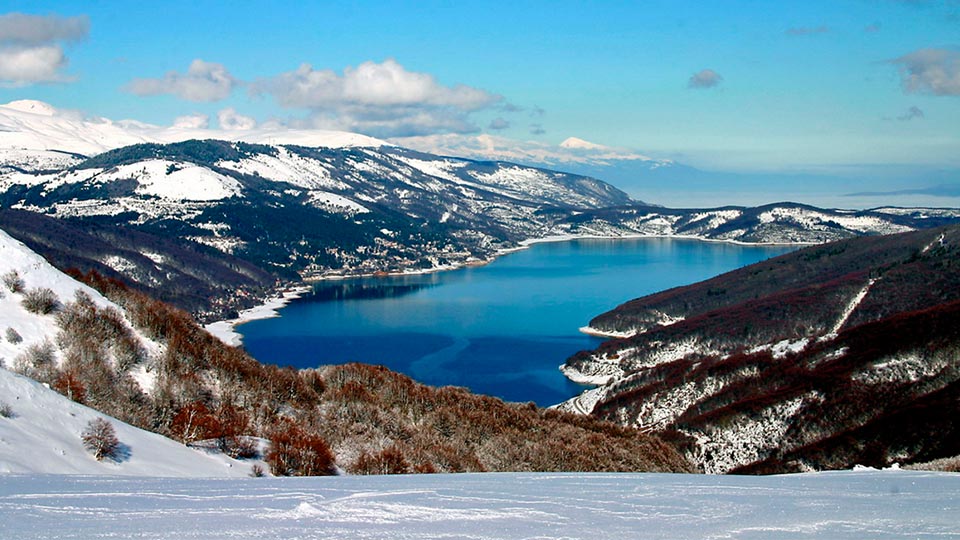
Natural treasures in the National Park Mavrovo
The natural treasures in the National Park Mavrovo call you at every step. Mavrovo has 30 picturesque caves, including the Sharkova dupka cave near Rostushe. Mavrovo also has Lokuv, the lowest glacial lake in Macedonia. The picturesque canyon of the beautiful Radika river gives a special beauty to the park. The many ravines, steep slopes, rocks of different shapes and waterfalls create the diverse and specific landscape of Mavrovo.
Within the boundaries of the National Park Mavrovo, there are over 52 mountain peaks with an altitude above 2000 metres, of which the peak Medenica of the Mountain Bistra, Velivar, Sandaktas and other are more famous. Special importance for the national park Mavrovo is given to the peak Golem Korab (2764 metres above the see level) which is at the same time the highest peak in the Republic of Macedonia and thus the highest point of the park. The lowest point of the national park Mavrovo is 600 metres above the see level and is located at the very place where Mala Reka flows into the river Radika.
Flora and Fauna in the National Park Mavrovo
The National Park Mavrovo has rich flora, with several endemic plant species, as well as with 82 protected animal species. From the vegetation of the park, the largest representation is that of the mountain beech forest community. The fauna of the national park Mavrovo is also characterized by considerable diversity. It consists of 140 species of birds, of which more important are: the grey falcon, the imperial eagle, the golden eagle (аquila chrysaetos), the forest owl, the great owl, the Montagu's harrier (circus pygargus), the pallid harrier (circus macrourus), as well as 11 species of amphibians, 12 species of reptiles and 38 types of mammals. Of the mammals, the most important are: the bear, the lynx, the wild goat and the wild cat.
The terrain offers a wonderful opportunity to explore while riding a horse or while moving along the biking and hiking trails, and the surrounding slopes of the mountains offer you the possibility of camping and long walks.
Cultural and historical monument in the National Park Mavrovo
The trademark of the region is the submerged church "St. Nikola" in the artificial Mavrovo Lake, which hides it to the roof with every rising of the water. Nearby is the archaeological site St. Nikola. The site is a necropolis from the late Middle Ages. During the summer period, when the water level in the Mavrovo lake is smaller, you can see the stone plates from graves and archaic crosses from the limestone. The Mavrovo Lake, on the other hand, is suitable for visitors all year round – in the summertime for bathing, and in the winter, when it freezes, for skating.
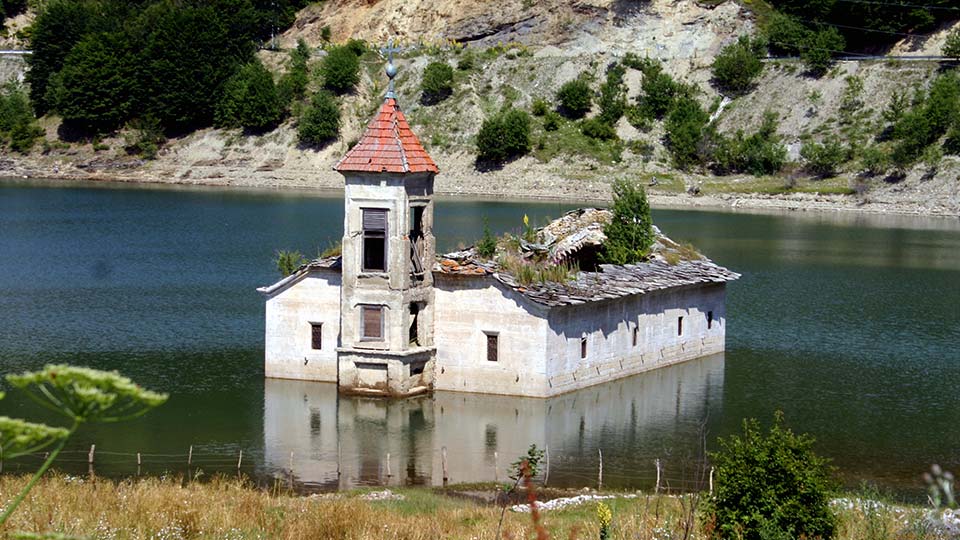
Monastery St. Jovan Bigorski
The monastery complex St. Jovan Bigorski dedicated to St. Jovan Krstitel (John the Baptist), is located along the flow of the beautiful river Radika. The monastery of St. John Bigorski is widely known for its iconostasis. It was made by Petre Filipov-Garkata from the village of Gary.
Bridge "Elen Skok" (Deer Jump)
The bridge was built on Mala Reka, about six hundred metres from the area of Boskov Most (Bosko’s Bridge) near the regional road Gostivar-Debar in the National Park Mavrovo. According to the local people and legends, the bridge was built 3-4 centuries ago in memory of the death of an enchanting and magnificent deer. On the mountain Stogovo, in the immediate vicinity of the village of Mogorce, a hunter from the village intercepted a deer when he was going hunting. He raised his rifle to shoot. But when he looked at the deer, he realized that the deer with the warm look and pose seemed to beg him not to shoot, not to kill him.
The hunter was enchanted, he lowered his rifle, got closer to the deer and began to pet him, and the deer hugged him with his head and expressed his friendship. So the hunter and the deer made friends and were spending time together every day. The hunter told the villagers about the meetings with the deer. One morning they went to look for him. They met him and tried to catch him. But the deer began to flee, and in order not to become the prey of the unknown, he tried to skip the river. But he did not succeed in that. The jump was a few feet short and the deer broke his front legs. In memory of the courage and beauty of the deer, the villagers of Mogorce, who were famous masters, built this bridge with unusual structure and architecture.

Tourist offer of the National Park Mavrovo
Within the National Park Mavrovo there is an Information Tourist Centre. The Info Centre is located in the village of Mavrovi Anovi, on the main road leading to the municipality building, that is, at a distance of about 500 m. from the dam in Mavrovo. It has data on tourist facilities in the region. They also issues various types of permits needed for certain activities on the territory of the park. In the centre you can obtain maps for movement and many other things that greatly facilitate the stay of tourists in the National Park Mavrovo. The centre operates every day from 08.00 hrs to 18.00 hrs.
Galicka Svadba (Galicnik Wedding)
It is held every year on Petrovden (St. Peter's Day) – 12th July and is a cultural event rich in many original, unique and unrepeatable wedding customs and rituals at the National Park Mavrovo. In the days of the wedding, the zurles and drums are heard "from Galichnik to Reka", with all the underground and aboveground sound to the Bistra stone and the sky. Those companions of the migrant workers in this region of Macedonia, always announce the Galichnik Wedding which has the greatest number of wedding guests. The Galichnik Wedding in its long existence has contributed to nurturing the unique wedding customs and rituals of the inhabitants of this region. It contributes to preserving the original songs, folk dances, and the well-known Galichnik costumes-made with filigree precision and correctness of the tailors.
Duf Waterfall
The Duf waterfall is located near the village of Rostushe and it can be reached in 30 minutes from the very centre of the village. The path to the waterfalls is marked, arranged, secured by a wooden fence and it is significantly steep on several spots, but in the most part it is easily passable. To reach the waterfalls one must pass through the Duf Canyon, which is up to 60 metres tall and is a real attraction. The place is also specific for the pleasant climate and the temperature in the hottest summer periods is from 18 to 20 degrees. Through the canyon runs the Rostushe River which is biggest in the spring period. The main attraction and a true holiday for the eyes is the Duf waterfall, according to which the place itself got its name, and it is located at the very end of the canyon.
The best period for visiting the site is from May to July, when the greatest amount of water flows through the Rostushe River and the waterfall. In the area of the village of Rostushe you can also visit the several local restaurants in which you can taste food prepared according to the traditional recipes. There is also a possibility for such foods to be prepared by local housewives.
Cave "Sharkova Dupka" (Sharko’s Hole)
Sharkova Dupka is located in the Municipality of Mavrovo-Rostushe, in the National Park Mavrovo, close to the winter tourist centre, more precisely in the village of Mavrovo. The cave pearl is located in the immediate vicinity of the last houses of the village. To the entrance there is a 10-minute walk along the built path and stairway. The Sharkova Dupka Cave, which is open to tourists, is protected by an iron door and bars. Decorated with semicircular metal stairs and fully illuminated with reflectors.
The cave is at a depth of 20 metres from the entrance, it is about 18 metres wide and 25 metres long. In the lower part of it there is an opening that leads into two more cave halls that are still unavailable for tourists. The cave was discovered more than three decades ago by the local population who was then afraid to enter it. According to one of the stories related to the discovery of the cave, the villager, nicknamed Sharko, who lived in the immediate vicinity of the cave, was the first who gained the courage to enter. He cut a few trees, lowered them into the hole and, with ropes and with the help of his neighbours, managed to get inside the cave. From there, the cavern beauty got its name Sharkova Dupka.
In addition to this, there are several interesting stories about the cave Sharkova Dupka. A map board is placed in front of the entrance gate, which explains the cave ornaments and rich animal world it is abundant with. Visitors descend into the interior of the cave with iron semicircular scales, which lead into the first pit or yard, about 20 metres below the ground. The temperature there is below 12 degrees Celsius.
The underground beauty is decorated with stalactites, stalagmites covered with coral, drapery and other cave jewelry, which presents the image of untouched beauty. Since the soil is rich in iron, most of the decorations are characterized by reddish-brown colour. In Sharkova Dupka there is a diverse animal world: bats, spiders, lizards, various types of insects. The cave is open for visits by organized groups and is an ideal location for organizing educational and didactic excursions.
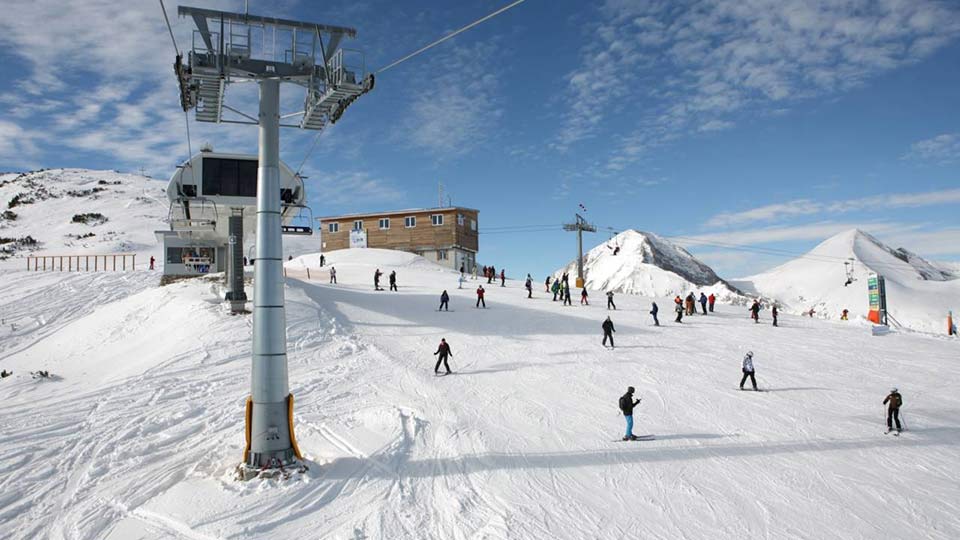
Skiing in Mavrovo
The winter in Mavrovo is enchanting. Then you can visit the snowy town of Bunec and head to the ski slopes. The beautiful snow-covered paths on Mount Bistra will awaken the athlete in you, and the terrain offers the possibility of night skiing. More information can be found on the official website of the National Park Mavrovo.

Museum in Sveti Nikole
The Museum in Sveti Nikole preserves, studies and presents the cultural wealth of the Ovcepolie region. The building of the Museum is a protected cultural heritage monument, built in the period from 1924 to 1926. The facility was built for the needs of the municipal administration at the time, so it has been called the old municipal building for a long time. The author of the project is architect Prof. Sotir Tomovski, one of the first academically educated architects from Macedonia.
The building was built in a neoclassical style, popular in this period in these areas, built upon influence of European traditions and European countries. Projected as a well-thought-out functional building for the needs of that time and with its architecture, it becomes a sign and benchmark of the central city area. It serves to house the municipal administrative units, a regional unit of the Ministry of Labor and Social Policy and the headquarters of other social organizations.
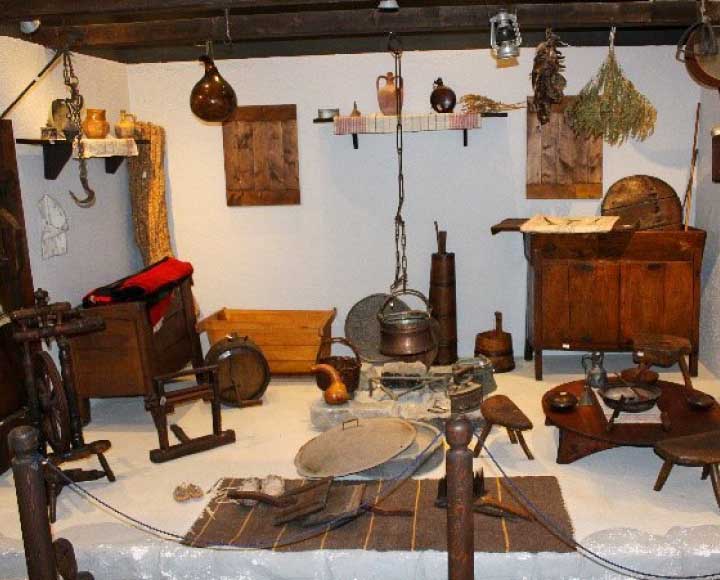
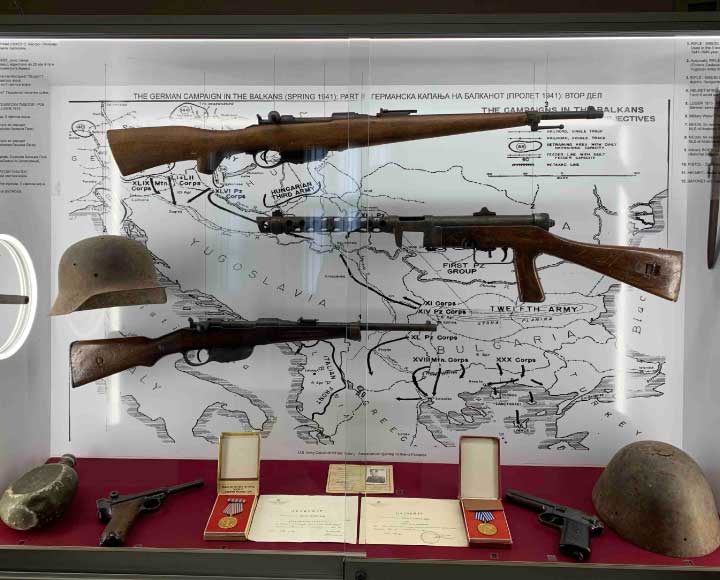
The Municipal Museum Collection was established in the year of 1981 due to the selected and presented archaeological material. The museum collection grew into the People's Museum - Sveti Nikole in 1994 with the increase in the collected material and fund of objects. By Decision of the Assembly of the Municipality of Sveti Nikole from October 1991, the object was assigned to the use of the then museum collection, and now the National Museum of Sveti Nikole.
Completely renovated and protected as a monument of the culture, the museum officially was open on August 25, 2002. It has a total area of 464 m2 of useful space. The museum contains the following permanent exhibitions and collections:archaeological, ethnological, historical, the lapidarium, as well as space for occasional exhibitions and events.
Archaeology - In a permanent archaeological setting, artifacts from 5-4 BC are exhibited, which result from the research of the archaeological site Gradiste Slavkov Dol, village of Knežje, known as Bilazora, as well as a diorama of the acropolis (model made in scale 1: 100 on the acropolis in Bilazora, which represents several periods of the Paionian continuum, with the palace being the ultimate architectural solution).
Ethnology - Objects that define the material and spiritual culture of the Ovchepol region, and which define the social life of the population for a period of two centuries, are exhibited in the permanent ethnological display, through folk architecture, traditional furniture, costumes, objects from agriculture, crafts, etc.
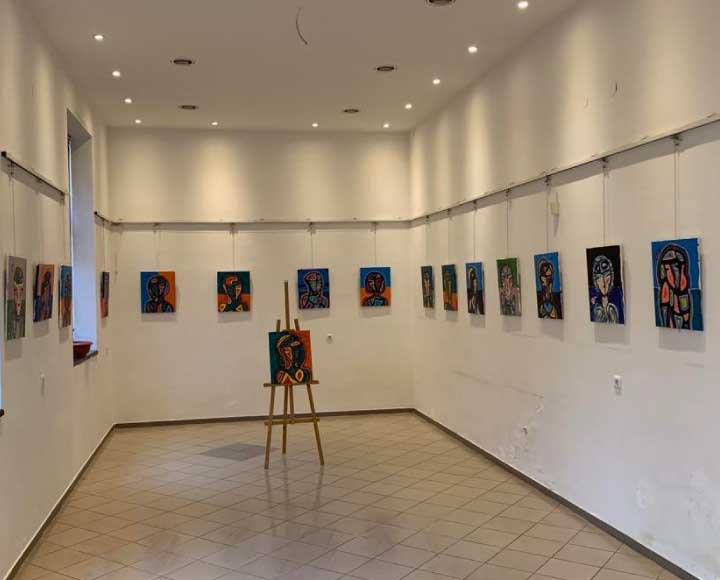
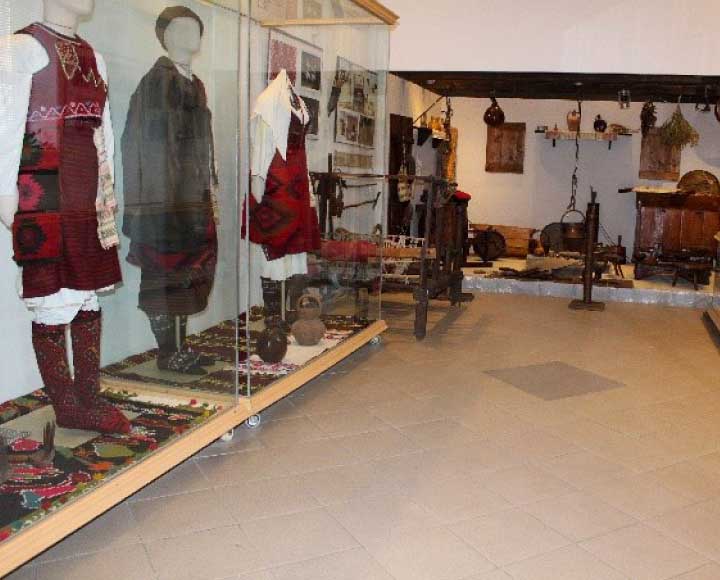
History - In the permanent historical setting with the exhibited objects, we capture the Ottoman period, the Balkan wars and the Second World War, using cartographic maps, which define the space and borders and historical events related to the territory of Macedonia, with an emphasis on the military-political networks of the Balkan peninsula for period from 1560 to the second world war.
The Museum is responsible for excavation and presentation of material findings for archeological site Bilazora. Contact: Square Ilinden 18, 2220 Sveti Nikole. Working hours: 07.30 - 15.30. Link from the museum's website: The website is under development https://muzejsvnikole.mk/public/, Link from Facebook page: Naroden Muzej Sveti Nikole https://www.facebook.com/SvNikole.
N.U. Museum of the Tetovo region
The Museum of the Tetovo area - Tetovo was founded in the year of 1950. The primary activity of the Museum is activities related to the promotion, research, presentation and preservation of the cultural-historical heritage and cultural monuments in the Polog Valley, as well as developing scientific-research projects in the field of archaeology, ethnology, history and the history of art.
The following departments and collections are located within the framework of the museum:-Archaeology,- Ethnology,- History of art,- History. Memorial house - of Gjoce Stojceski-Ambarce
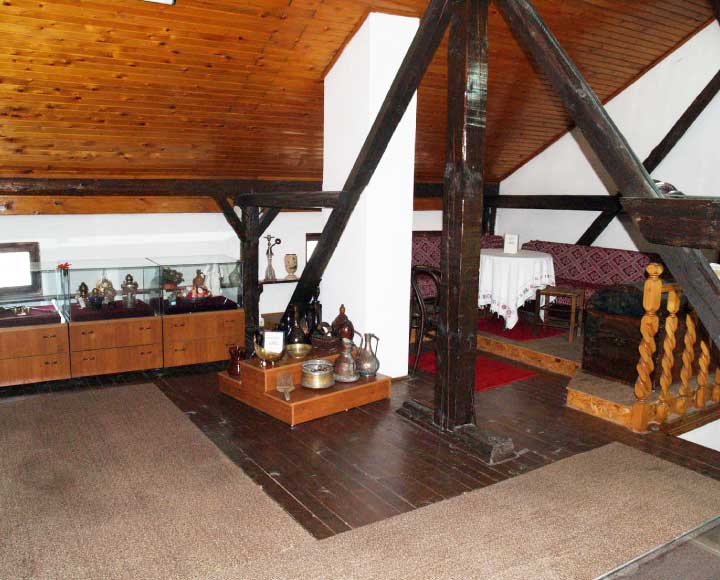
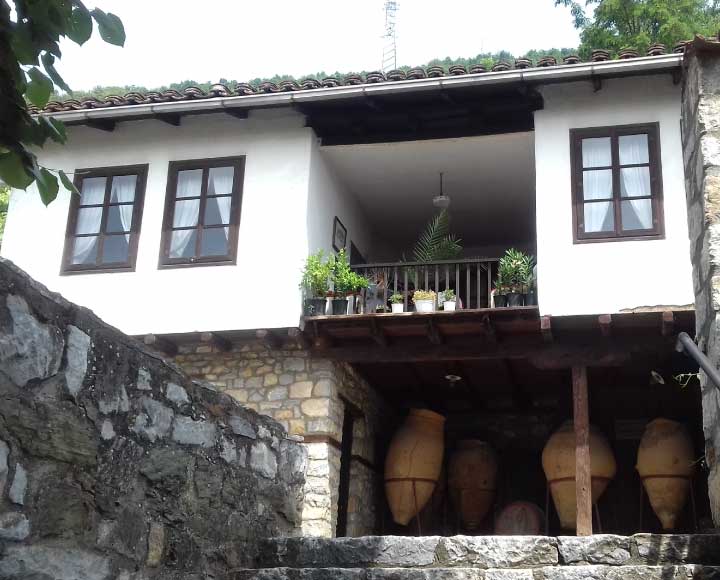
The museum collection is within the framework of this building. Located in an old traditional Macedonian house, protected as historical monument, the Museum of Tetovo offers to visitors the opportunity to see traditional costumes, objects and furniture in the modest collection of the permanent ethnological display.
Also, through the historical settings of the museum, information about city are displayed and presented through documents, photographs, geographical maps and various weapons, dating from the different historical periods of the past of the Tetovo, from the Turkish period until the beginning of the 20th century. The museum is open to visitors every day except Sunday.
Museum of the Central Committee of the Communist Party of Macedonia (CCC of the Communist Party of Macedonia). The Memorial Museum of the Communist Party of Macedonia is located in a quiet and beautiful place in the upper historical part of the city of Tetovo. In this house on March 19, 1943, following the decision of the Central Committee of the Communist Party of Yugoslavia, the Central Committee of the Communist Party of Macedonia (CCC of the CPM) was established.
The facility is located at following address Goce Delchev Street no. 83, in neighborhood in Tetovo. It represents an old town house built at the end of the 19th century, located just below the Tetovo Kale (the fortress) and represents an ambient architectural unit.
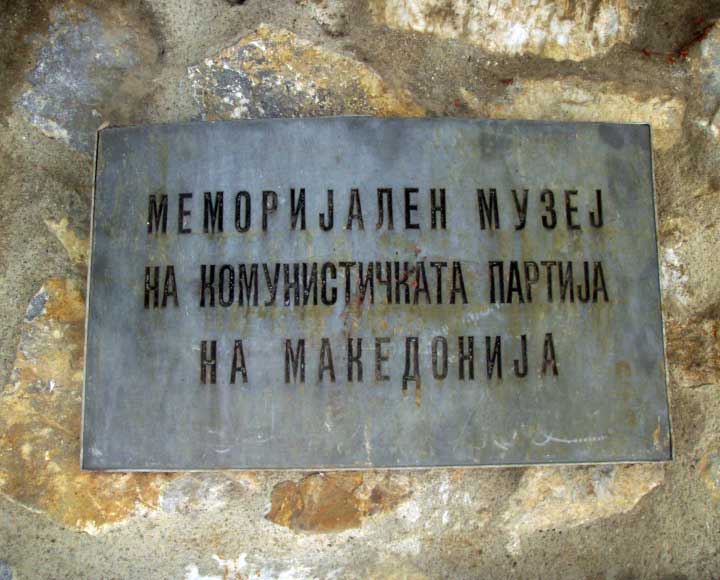
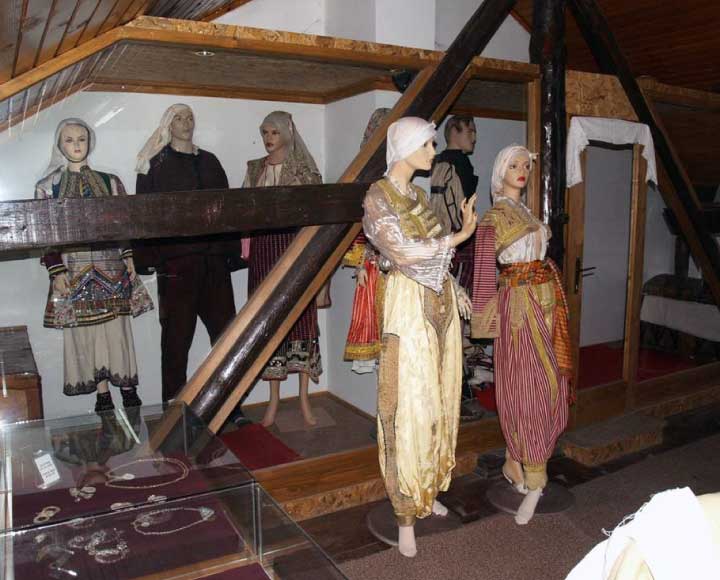
The building with its simple and clean exterior design, authentic interior possesses ambient, architectural and aesthetic value. A new open amphitheater has been set up in the courtyard, where various cultural multimedia projects are regularly held in the summer quarter in collaboration with the city's NGOs.
The museum is open for visitors from 09:00 to 16:00. New administrative building, former House of the ARM. The object is an administrative building of the former House of the ARM handed over to the use of the Museum from 2020 it is located in the central city area. Various cultural and artistic activities such as promotions, exhibitions, audio and visual performances and workshops, are happening in the ground floor rooms.

